Last updated on January 23, 2024
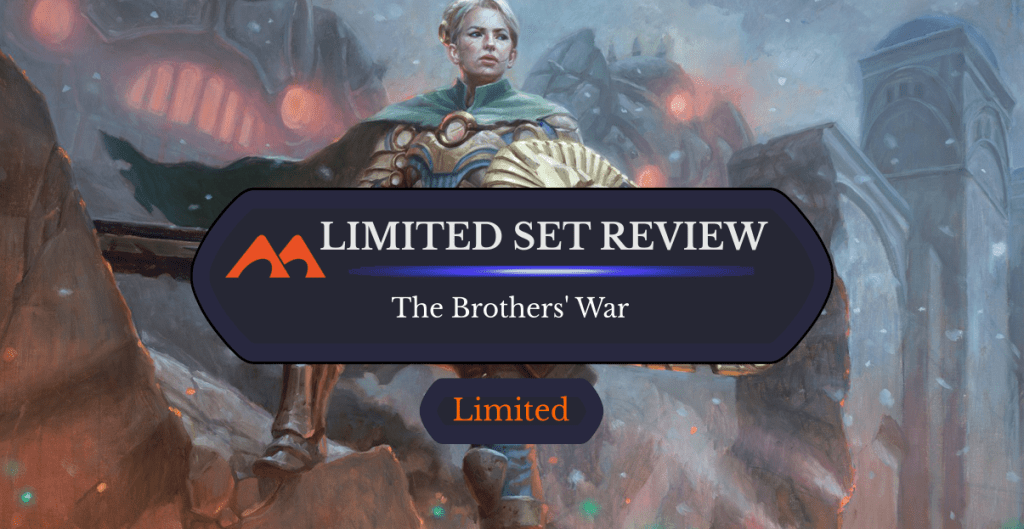
Myrel, Shield of Argive | Illustration by Ryan Pancoast
One of Magic’s oldest sets, Antiqusities, told the story of a great war between two brothers: Urza and commMishra. The story was told from the present day as ancient artifacts were being discovered by present-day archaeologists on Dominaria. The story was then told in one of the earliest Magic novels: The Brothers’ War by Jeff Grub.
Now we’re going back in time to see the war play out in real time as Teferi searches for ways to counter the impending threat of the present day Phyrexian army.
So that's the backstory. But how do the cards in The Brothers’ War rank when it comes to Limited? Let’s find out!
Rating Breakdown
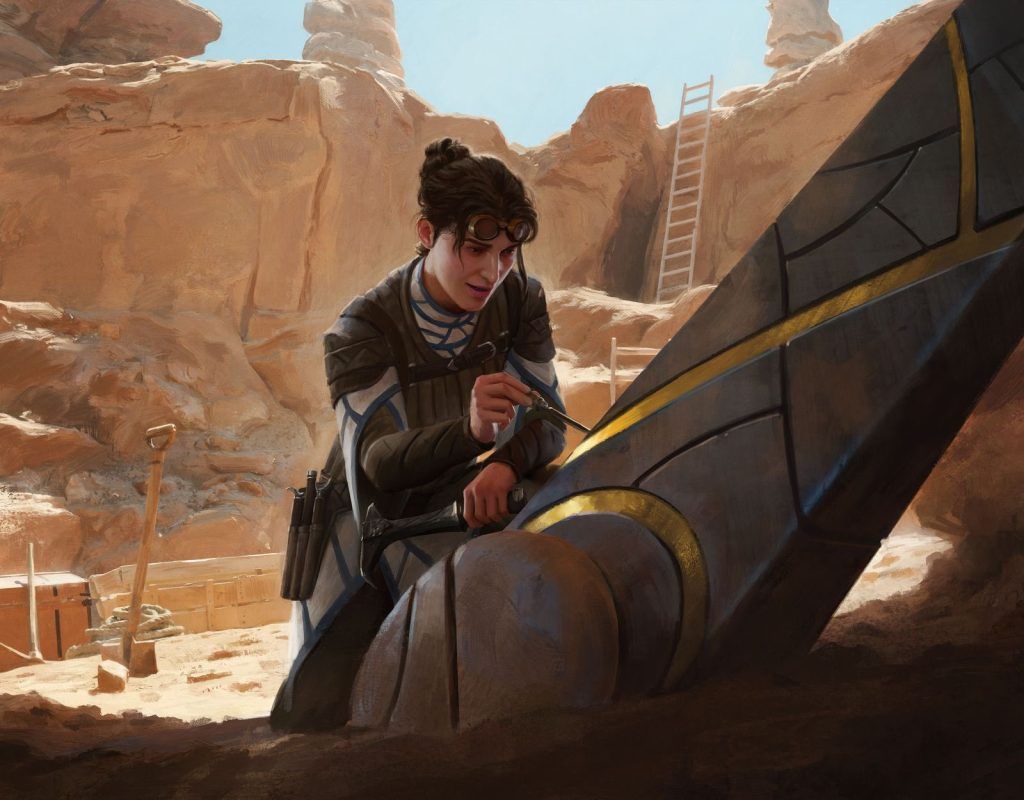
Loran, Disciple of History (The Brothers’ War) | art by Cristi Balanescu
A quick reminder that these reviews are based on my initial impressions of the set. There’s no way to tell how fast or slow the format is without playing, or how good each of the draftable decks are going to be.
My review of each card assumes that the archetype it’s designed for is in fact playable. My hope is that these insights will go some way to help inform your decisions in your first attempts at playing the format.
I’ll underscore each review with a rating for the card out of 10. Here’s what each of the ratings mean:
- 10: The absolute best of the best. 10s will make a meaningful impact on any game regardless of when you play them and will be extremely tough to beat. Cards like Sheoldred, Whispering One and Sol'Kanar the Tainted.
- 8-9: Extremely good cards, usually game-winning bombs and the most efficient removal spells, though not quite good enough to be 10/10. Cards like Herd Migration and Wingmantle Chaplain.
- 6-7: Important role-players. These are typically the best uncommons that really drive you towards playing a particular color, like build-arounds and good removal. Cards like Tolarian Geyser and Tolarian Terror.
- 3-5: The average limited card. Most commons and uncommons end up in this range, and most of your limited decks will be made up mostly of these. Cards like Magnigoth Sentry and Linebreaker Baloth.
- 1-2: These cards are generally pretty bad and you ideally won’t play any of them. They should be kept in the sideboard and might be useful in specific situations. Cards like Spell Pierce and Llanowar Stalker.
- 0: Absolutely awful cards. Virtually unplayable in every scenario and you should never put these in your main deck. Cards like Chaotic Transformation and The World Spell.
This is a very big set. On top of the roughly 260 cards that make up the main set there’s also an extra set of retro-border artifact reprints, similar to the Mystical Archives of Strixhaven, called Retro Artifacts. You get one of these in every draft booster so they’re a part of the Limited environment.
I’m also going to skip over my usual discussion of the mechanics and just jump straight into the cards. There are a lot of artifacts in this set, and I’ve sorted them based on their color identities. So cards with white costs for their abilities are listed as white cards.
White
Aeronaut Cavalry
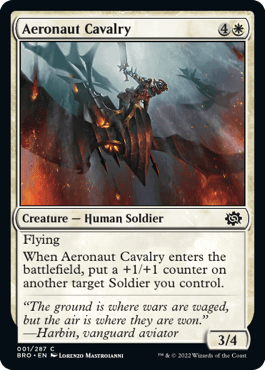
Rating: 5/10
Aeronaut Cavalry is very reminiscent of Supply-Line Cranes, which ended up being quite a decent card. We’ve also seen vanilla creatures like this in recent sets do really well, so the combination of a vanilla 3/4 flier plus an extra +1/+1 sounds like a really good curve topper to me.
Airlift Chaplain

Rating: 5/10
Airlift Chaplain is part of a cycle of self-mill enablers. Each one mills for three cards and then gives you either a +1/+1 counter or an extra card.
Both options sound good in this case. You either end up with a 2/2 flier for three or a 1/1 flier that draws you a card, and you should be happy with either option.
Ambush Paratrooper
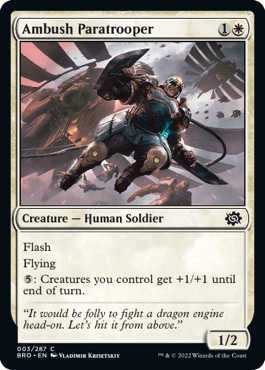
Rating: 3/10
A 1/2 flier for two is quite a bit smaller than I’d normally be happy playing. Flash is definitely nice and there are a few 1/1s that I wouldn’t mind ambushing.
Ambush Paratrooper stays relevant in the late game by being able to pump up your whole team, so that’s decent. There are basically enough small upsides to keep me interested, but it’s not likely to be a priority.
Calamity’s Wake
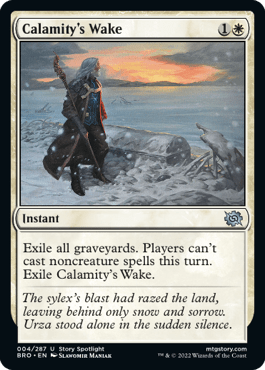
Rating: 0/10
While we do care about attacking the graveyard to some extent in this set, we don’t care enough to play a card like Calamity's Wake that’s a pure blank in the majority of scenarios and doesn’t replace itself. I can’t imagine the Silence mode is all that appealing either, so I assume this is completely unplayable.
Deadly Riposte
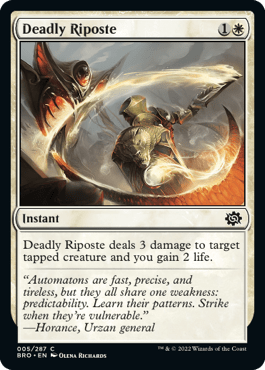
Rating: 4/10
Three damage is a little low to only be able to target a tapped creature, but the lifegain is nice to see. White looks to be quite aggressive in this set, but I don’t think many decks will be interested in a more control-oriented removal spell.
Still, Deadly Riposte is definitely a decent option that’s available.
Disenchant
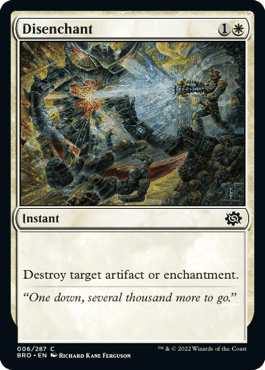
Rating: 6/10
From pure sideboard fodder to premium and efficient removal in an artifact-themed set. Not only are there plenty of artifact creatures roaming about, they’re also the biggest creatures and the ones that you most need to be able to kill, making Disenchant likely to be one of the better commons in the set.
Great Desert Prospector
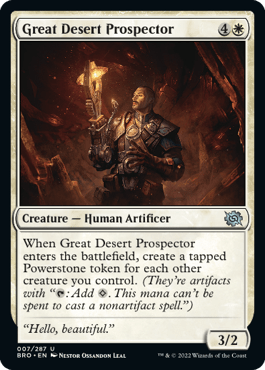
Rating: 3/10
I don’t think go-wide decks are all that interested in a pile of Powerstone tokens and decks that aren’t interested in going wide. Great Desert Prospector feels like a weird juxtaposition that makes the card worse than it immediately looks.
You might find a good compromise, but this is just awful if it’s making anything less than two tokens.
In the Trenches
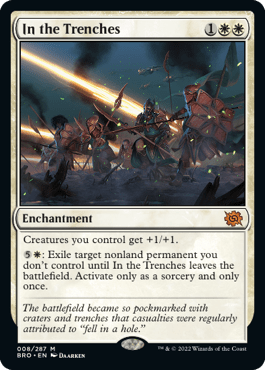
Rating: 8/10
Glorious Anthem on steroids is a very interesting card. In The Trenches might be very expensive to access the removal mode, but you’re still happy playing with this as just an anthem. It’s just a pure upside if you ever do reach six mana.
Kayla’s Command

Rating: 6/10
It’s hard to know what to make of Kayla's Command. One thing I know is that I’m not very interested in drawing another Plains if I already have two white sources to cast this.
But making a 2/2 Construct and then picking any of the other modes is probably enough value to make this always a nice card to cast, though it’s not setting the world alight.
Kayla’s Reconstruction
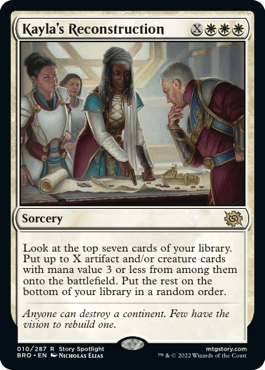
Rating: 0/10
A spell that costs, for example, six mana to grab up to three small artifacts and/or creatures from among the top seven sounds like there’s too much that can go wrong. Coupled with the fact that Kayla's Reconstruction is a sorcery doesn’t work with prototype cards and has a very prohibitive casting cost means I can’t imagine ever wanting to cast this.
Lay Down Arms
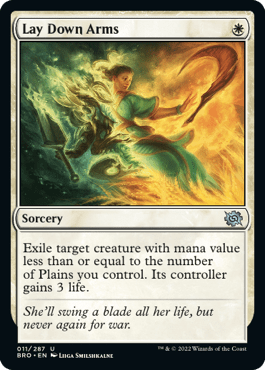
Rating: 3/10
Lay Down Arms is nice and efficient, but I think it's a little too restrictive. Having your opponent gain life means you’d much prefer to be a controlling white deck. Caring about the number of Plains you have in play means that you’ll only have a couple of them in play on most turn 4s in a 2-color deck with a typical 9/8 split on basics.
If you happen to be mono-white then the value of this skyrockets, especially if it’s possible that it can exile a Wurmcoil Engine. But this misses on too many fronts to become premium removal overall.
Loran of the Third Path

Rating: 9/10
Reclamation Sage is basically just Ravenous Chupacabra in an artifact-themed set. Not only is Loran of the Third Path an easy two-for-one, but you can flicker and recur this, making it a highly desirable card.
Loran, Disciple of History
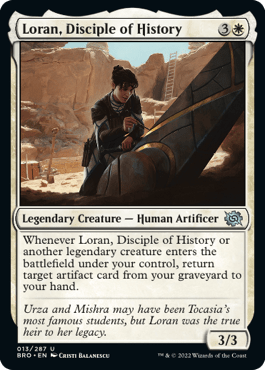
Rating: 7/10
We’ve had these kinds of cards in previous sets, like Trusty Packbeast and Master Skald, but they go from fine to amazing in a set that’s so heavy on artifacts.
Not only that, but young Loran, Disciple of History repeats this effect if you happen to have other legendary creatures handy, meaning you don’t even need to recur it to be able to reuse the trigger. This will be an exceptional card for white artifact-based decks.
Loran’s Escape
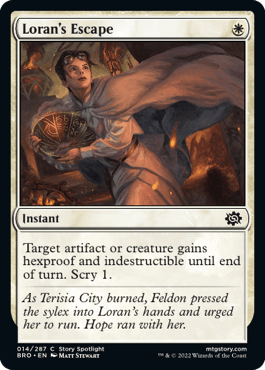
Rating: 4/10
I’m always wary of cards that are basically combat tricks that provide no power/toughness bonus. But hexproof and indestructible is a combination we’re seeing more and more and it mainly exists to protect against the majority of removal spells.
On balance I’d say Loran's Escape will end up being worth it given its flexibility, and the scry 1 is a nice touch to help find your next play.
Mass Production
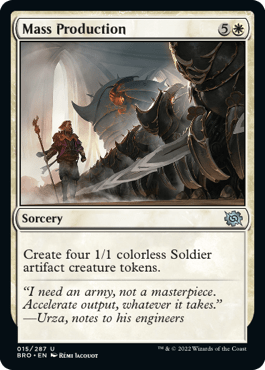
Rating: 3/10
Six mana for four 1/1s feels quite a bit below rate. If you compare to cards like Imperial Oath and Goblin Rally, we’ve seen Mass Production be a lot better. That said, making four artifacts in one go can trigger a lot of things in the set, so this may be a great top end in the right deck.
Meticulous Excavation
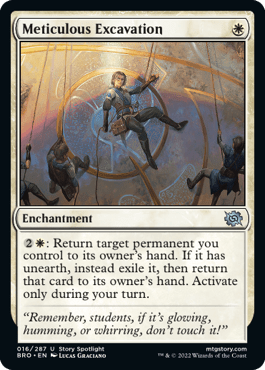
Rating: 3/10
Meticulous Excavation probably looks like an effect that you never want to a lot of players, but it lets you reuse ETB triggers. You can also pick up creatures that are locked down by an opposing aura, or pick up your own aura to move it to a better target.
Thanks to the obvious wording you can also pick up an unearthed creature to stop it going to exile. This does have quite a lot of narrow applications so I assume we can find a deck that wants it, but that narrowness will keep it out of most decks.
Military Discipline
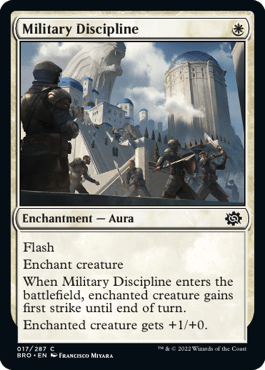
Rating: 1/10
While I’m a fan of combat tricks that stick around and give a meaningful bonus after they’ve been played, Military Discipline has to be the worst one I’ve ever seen. The aura left behind is minimal and the entire effect isn’t even that good.
Kindled Fury isn’t good enough, and I don’t think this is either.
Myrel, Shield of Argive

Rating: 10/10
Any creature that creates multiple tokens when they attack is worth a look. Much like Hero of Bladehold being one of the best mythics from the Scars of Mirrodin block, Myrel, Shield of Argive looks to be one of the best mythics in this set.
While it lacks some kind of evasion to make sure it can attack, the Grand Abolisher ability guarantees that your opponent can’t’ do anything to stop it. From there you can use whatever removal or combat tricks to get that attack in.
The ability will always get you at least one token, and exponentially more on successive turns. Did I mention this card is also extremely splashable? Soldiers are looking very strong in this set so far, and this is one of the best cards they have access to.
Phalanx Vanguard

Rating: 4/10
We do like our 2-drops with upsides, and Phalanx Vanguard will often be able to attack as a 3/2 or 4/2 thanks to all the Soldier tokens you’re probably making.
Powerstone Engineer

Rating: 5/10
2-drops with relevance are exactly what we’re looking for in Limited, and Powerstone Engine turning into a Powerstone when it dies looks like a good trade. Dire Fleet Hoarder was a great 2-drop in Ixalan, and I expect the same is true here.
Prison Sentence
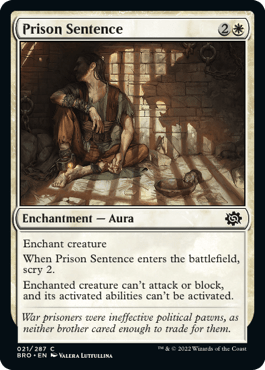
Rating: 6/10
Prison Sentence is white’s main common removal spell, and it’s really good. Arrest with a pure upside is nice to see, so you still end up trading one-for-one and getting a scry 2 out of it even if it gets Disenchanted.
Recommission
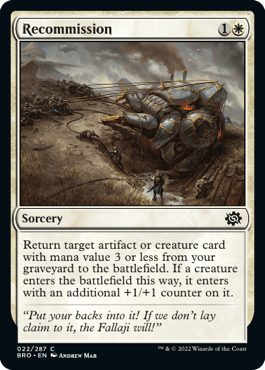
Rating: 3/10
There are actually a couple of reanimation spells in this set to go along with all the self-milling cards, but they’re a little too situational to be good. Recommission is essentially a 2-drop that you can’t slot into your mana curve. You need something to go to the graveyard first.
It just seems too narrow in use for most decks to run.
Recruitment Officer
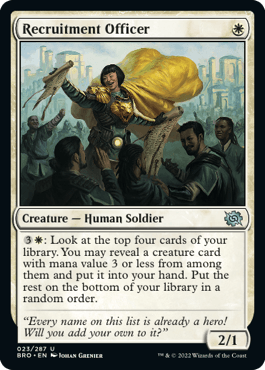
Rating: 7/10
We’ve come a long way since Elite Vanguard. There’s nothing not to like about Recruitment Officer. 1-drop 2/1s are decent, soldier is a relevant creature type in the format, and late game mana sinks are always desirable.
Repair and Recharge

Rating: 3/10
Reanimation spells haven’t had a great time of it in Limited, and one that can only really get back artifacts is just a little too narrow. Especially costing five mana.
There may very well be decks that can make use of Repair and Recharge, but I don’t think it will end up being good enough.
Siege Veteran
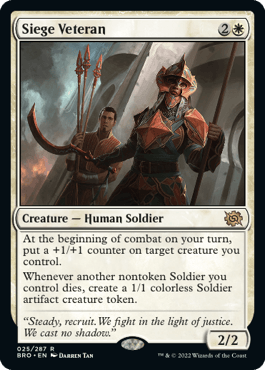
Rating: 10/10
Luminarch Aspirant, is that you? You were once the best rare in Zendikar Rising Limited, can you live up to that record here? I’d imagine so.
Siege Veteran costs one extra mana, but it’s slightly bigger and has a very powerful effect that lets you keep generating tokens if your creatures die in combat. This will get out of hand very quickly and doesn’t even require any mana input after you’ve cast it, which is just excellent.
When 10/10s are this cheap to play they’re worth paying attention to because they’re more likely to get cast when you draw them. There are more games where you just don’t get to six mana compared to a 6-drop, and that does make them a little worse.
Soul Partition
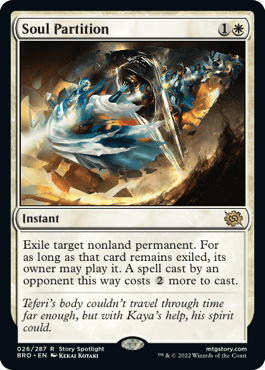
Rating: 5/10
We’ve seen some similar cards to Soul Partition pop up in Alchemy, and I understand they’ve performed very well there. This variation basically works as a white bounce spell, taxing the player to recast their spell. That’s honestly okay.
Bounce spells are very good on big expensive creatures since it often takes your opponent a whole turn to recast them. And doing this on a pesky 4-drop will force your opponent to take the whole of their turn 6 just to replay it, and that loss in tempo can be a powerful weapon.
You can even use this as a very roundabout way of flickering a permanent of your own in a pinch, so that’s worth bearing in mind too.
Static Net

Rating: 7/10
A Banishing Light variant that also ramps you and gains life is phenomenal. Static Net should be premium removal if not for one major downside. The fact that everyone will be happy putting Disenchant effects in their main decks means this gets incidentally hated out as a result.
I’d also be aware of hitting prototype creatures with this because if it’s destroyed and they come back, they come back as their original big version. That’s not to say it’s not still a good card, but there are definitely knocks against it.
Survivor of Korlis
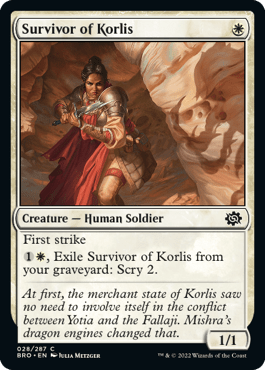
Rating: 2/10
1-drops have been getting very relevant in the last few years, but a 1/1 first striker is still well below par. Getting some extra value from Survivor of Korlis in the late game isn’t enough to save it, but being a soldier might.
You may actually want this to start off your curve if that deck has enough tribal synergies.
Thopter Architect

Rating: 3/10
Giving flying to creatures is always welcome, but we’ve seen similar cards to Thopter Architect, and they always fall short of the mark.
The base creature is massively understatted for a 4-drop, meaning you have to be making use of the effect as much as possible. But you need a steady stream of artifacts and creatures that are good to attack each turn to do that.
Tocasia’s Welcome

Rating: 4/10
Tocasia's Welcome’s effect has been very good when we’ve seen it appear on creatures like Mentor of the Meek and Welcoming Vampire. But those cards affect the board and draw you cards, which this card does not.
It’s also a terrible card to draw when you’re behind or when you reach the late game, so I don’t think it’ll play out anywhere near as well as it looks like it might.
Union of the Third Path
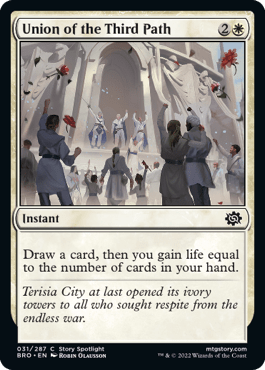
Rating: 1/10
If Revitalize is only barely playable (and even then not good enough most of the time), tacking on an extra mana and making the lifegain not guaranteed isn’t a recipe for success. The chance that Union of the Third Path doesn’t gain you much life at all is big enough that I wouldn’t want to play it, even if you’re a go wide deck.
Warlord’s Elite
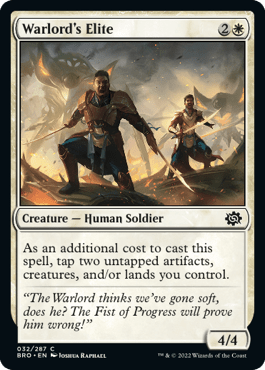
Rating: 4/10
Warlord's Elite is basically a 4/4 for five with some minor cost reductions involved. It shouldn’t be too difficult to slot into your curve if you tap creatures or equipment to cast it. My worry is that it might end up getting played at its full cost too often, but that tradeoff is probably worth it if it still come in for cheap enough of the time.
Yotian Medic
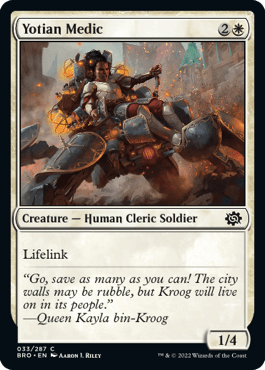
Rating: 4/10
A 1/4 with lifelink is pretty solid and a really annoying creature that should be fine on both offense and defense. Being a soldier is also a huge boon, so I’d expect Yotian Medic to be a nice common to pick up and fill out your curve.
Autonomous Assembler

Rating: 9/10
As you’ll see with a lot of these prototype creatures, I’m not that interested in casting Autonomous Assembler for the full cost. But two mana for a 2/2 with vigilance that gives itself a +1/+1 counter every turn is just bonkers.
We’ve seen similar cards before like Chronomaton, Hangarback Walker, and the whole outlast mechanic, and they’ve always played out incredibly well. Not to mention that assembly-worker is a very relevant creature type, allowing you to search for it with Self-Assembler. And you can distribute the counters onto the Urzatron creatures that you’ll see later.
This is a beast of a card and I can’t imagine a better turn 2 play that’ll lead to more wins.
Combat Thresher
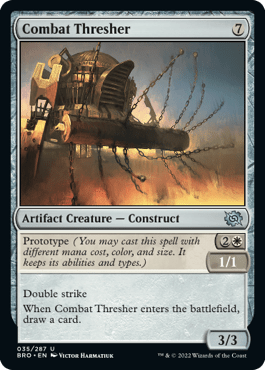
Rating: 7/10
I don’t really see wanting to cast Combat Thresher for seven mana, but I guess it’s an option. This is already great at three mana. A 1/1 double striker that also draws a card is an incredible rate for three mana.
From there it should be easy enough to modify with equipment or +1/+1 counters, so the double strike really comes in handy. Even if we don’t, drawing a card and trading off with another card is more than good enough to have spent three mana on.
Platoon Dispenser
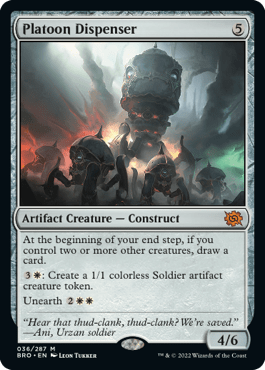
Rating: 9/10
While unearth is a little weird on Platoon Dispenser it’s still a pretty busted card since the activation costs to make a Soldier and unearth it are too expensive together. It shouldn’t be that difficult to engineer a scenario where you already have two creatures when you play this and get to draw a card at the end of the turn.
From that point on churning out free tokens each turn is a great ability to sink your mana into. This should slowly dominate the board if left unchecked.
Scrapwork Cohort
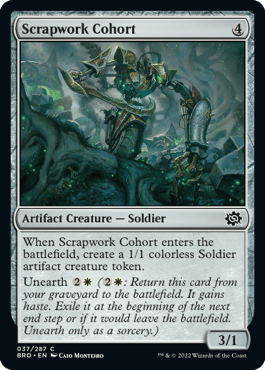
Rating: 4/10
A pair of Soldiers for four mana sounds pretty good to me, and that’s without even factoring in the unearth cost. Unearth is a swingy mechanic that sometimes feels like a waste because the creature you get is only temporary. But Scrapwork Cohort gives you a tangible advantage when you unearth it, and I am all in for that.
Steel Seraph
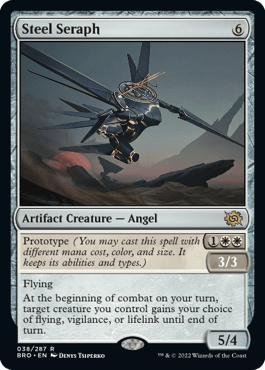
Rating: 9/10
The floor on Steel Seraph is that it’s basically a 3/3 lifelink flier for three mana, and that’s already excellent. The flexibility of being able to pick and choose your second keyword and also grant it to other creatures goes above and beyond what this card is capable of.
Jumping your creatures over their blockers or giving lifelink to a big creature feel like the best options, but the fact that this lets you pick and choose the best option for whatever scenario you’re in makes this an exceptionally strong card above all else.
Tocasia’s Onulet

Rating: 2/10
Even if you get a second wind out of Tocasia's Onulet I think it’s too small and ineffectual to make much of a difference. Especially since it doesn’t gain you life right away.
Urza’s Sylex

Rating: 5/10
On average Urza's Sylex is probably worse than Perilous Vault since destroying everything is a big downgrade compared to exiling everything. But this might just be cheap enough to be good at a total of seven mana to cast and activate in the same turn.
You’ll basically never be searching for a planeswalker so that’s off the table, but as far as board wipes go you could certainly do worse.
Veteran’s Powerblade

Rating: 3/10
I have no idea why WotC loves printing crap equipment that just gives +2/+0 and nothing else. We’ve seen this from the completely unplayable Jackhammer in New Capenna and the equally terrible Veteran's Axe in Dominaria United.
Veteran's Powerblade is marginally better because you can equip up Soldier tokens for just a white mana, but it needs to be so much better than this.
WotC, just reprint Bonesplitter. It won’t break the set.
Yotian Frontliner
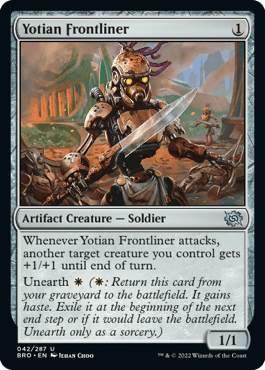
Rating: 2/10
Similarly to Survivor of Korlis, I don’t think Yotian Frontliner does enough for a 1-drop for me to be interested in it. The unearth cost is nice and being a soldier is a definite plus, but the body is too fragile to make it a worthwhile attacker in most scenarios.
Blue
Air Marshal
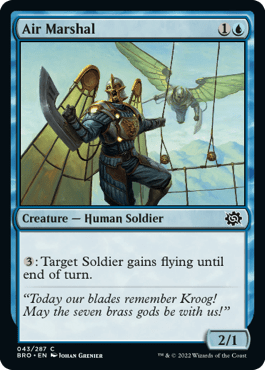
Rating: 4/10
I remember losing a lot of Drafts to Passwall Adept, and Air Marshal looks like a nicer and more aggressive version of that card. Being a soldier is awesome. and being an aggressive turn 2 play while being very relevant when you draw it late is exactly what these soldier decks want.
Curate
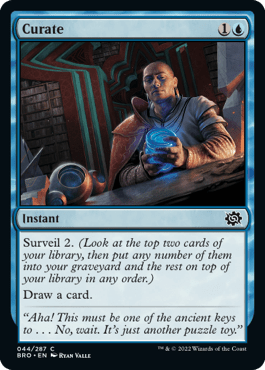
Rating: 2/10
When we last saw Curate in Strixhaven it was mediocre at best. And that was in a set that centered around instants and sorceries.
I don’t think this is likely to be that useful here, but there are some good prowess creatures and graveyard-based decks that might want it.
Defabricate
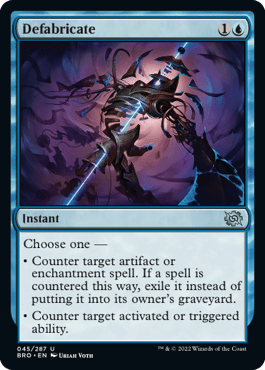
Rating: 5/10
Annul with a ton of upside for just one more mana sounds like a pretty good deal in a set based around artifacts. I don’t think we’re that likely to counter an ability with Defabricate but countering unearth actually sounds reasonable, and being able to exile unearth creatures when they’re cast for the first time is a great option too.
Desynchronize
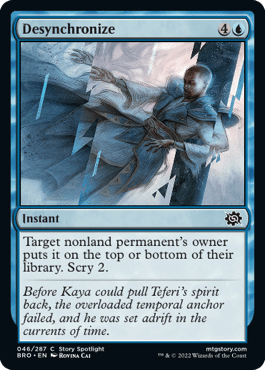
Rating: 3/10
Cards like Desynchronize have been pretty good in recent sets, but they also cost just four mana. Costing five is a big step up and I don’t think scry 2 quite makes up for it.
That said this is removal if a deck needs it. There are just probably better options in other colors.
Drafna, Founder of Lat-Nam

Rating: 7/10
Getting Drafna, Founder of Lat-Nam going with something like Ichor Wellspring is literally all I want to do in this set. This card is so sweet it just has to be good, and I hope there are enough synergies in the set to make this something I can do reliably.
In the mid game you can just use Drafna to accrue value and start copying your giant mechs later in the game. At that point it starts getting really scary.
I love everything about this and can’t wait to try it out for myself.
Fallaji Archaeologist

Rating: 5/10
Either you get a two mana 0/3 that mills three cards and draws you a spell, which is excellent, or you whiff on the spell and end up with a 1/4. Either way I really like Fallaji Archaeologist.
I have to imagine that the self-mill is an upside, meaning you’d be happy with this no matter what.
Flow of Knowledge

Rating: 1/10
Five mana to draw an indeterminate number of cards and then discard two isn’t where the majority of decks want to be. In fact, you’re only likely to have two or three Islands in play on turn 5 in a 2-color deck, making Flow of Knowledge a really bad deal.
This becomes really decent if mono-blue is a thing (which isn’t that unlikely), but I think it’s far too unreliable to play outside of that.
Forging the Anchor
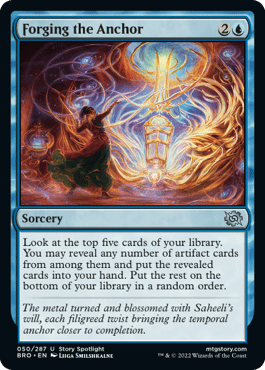
Rating: 5/10
You really need to be heavy on artifacts to make Forging the Anchor work, but this becomes a worthwhile card in my opinion if you can reliably hit two or more.
I’d want at least half my spells to be artifacts before I felt comfortable putting this in my deck, but it should work out well enough like Kruphix's Insight before it.
Hurkyl, Master Wizard
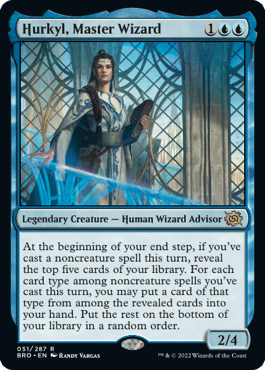
Rating: 5/10
Hurkyl. Master Wizard has a lot of text that basically boils down to: if you cast a sorcery spell on your turn then you can look for a sorcery out of your top five cards and put it into your hand during your end step.
And the same is true for every other noncreature spell type. That seems good when you can build around it, but otherwise you’ll probably miss too often for this to be all that good. You’ve made your money back if you can find at least one card off it.
I just think that it may take a few attempts to find your first card and that probably makes this weaker than it looks.
Hurkyl’s Final Meditation
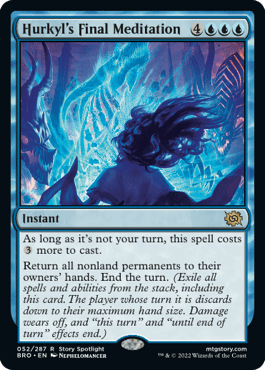
Rating: 0/10
As much as I love casting 10-mana instants, I don’t think Hurkyl's Final Meditation looks very castable given that Powerstones do nothing to help you.
Casting it for seven on your turn sounds like a bad idea since giving your opponent the first crack at replaying their permanents is a surefire way to lose a game. I’m liking this for Constructed, but it’s basically unusable here.
Involuntary Cooldown
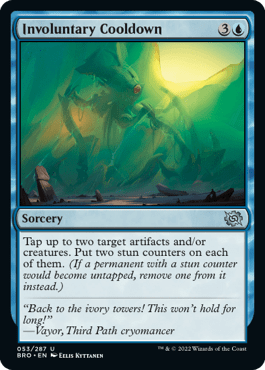
Rating: 4/10
I think Involuntary Cooldown looks pretty good, specifically for the soldier decks. Tapping down two annoying blockers and keeping them stunned for two whole turns gives you three combat phases where they’re not a factor, and that often gives you enough time to formulate a win.
Keeper of the Cadence
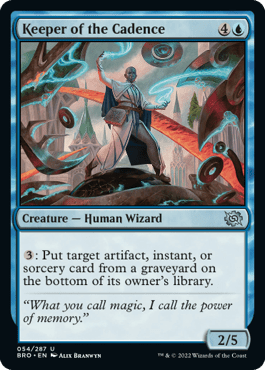
Rating: 3/10
Seeing a card like Keeper of the Cadence fills me with a ton of hope and optimism for this set. Epitaph Golem from Shadows Over Innistrad led to some incredibly grindy gameplay where you would have the time to mill your entire library and then pick and choose the cards you wanted to draw.
While this card is probably bad, it’s an effect I really like having access to in the set. I really hope there’s a deck that can use it.
Koilos Roc
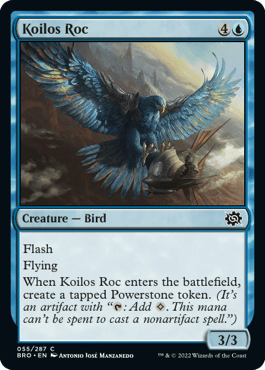
Rating: 4/10
Take your pick. Living Tempest, Faerie Invaders, Stormrider Spirit? I’m a Spire Monitor man myself.
We’ve seen this 5-drop flash flier several times before and they’ve always been fine. They play out nicely, ambush small attackers, let you hold up counterspells and so on. Koilos Roc also ramps you a little bit which is a very welcome bonus.
Lat-Nam Adept
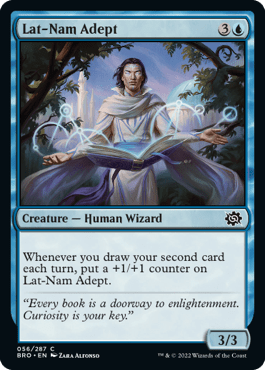
Rating: 4/10
I’ve liked the “draw two cards in a turn” mechanic ever since we first saw it back in Throne of Eldraine. Lat-Nam Adept seems like a relatively weak common for the archetype, but it becomes a reasonable creature on board as soon as it starts getting counters and can even start getting big enough to trade for 6-drops and the like.
I’d say that’s good enough to want at least one copy in these decks.
Machine Over Matter
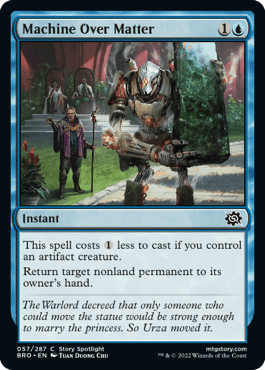
Rating: 3/10
Disperse is a fine card, but nothing all that exciting. This upgrade over it is very minor so it really comes down to how much you want that 2-mana bounce spell, and that’s going to be fine in some decks.
I like Machine Over Matter more in the Azorius () soldiers deck than anything else since tempo cards are exactly what that deck is looking for.
Mightstone’s Animation

Rating: 5/10
Ensoul Artifact variants always play out pretty well in Limited. Mightstone's Animation is a little on the expensive side, but we’ll probably have a bunch of Powerstones lying around and this draws a card when it enters, which is more than enough of a tradeoff.
One with the Multiverse
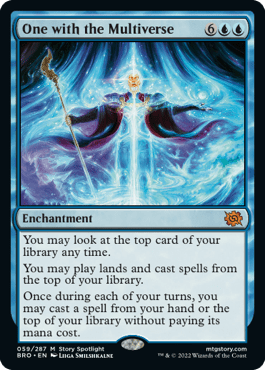
Rating: 1/10
If the format allows you to cast 8-mana non-artifact spells then One with the Multiverse is incredibly dumb. I just assume that you probably can’t afford to do this.
Powerstones don’t help you in casting this, otherwise it would be a great card. I want to make it work but I know it’s too ambitious.
Retrieval Agent
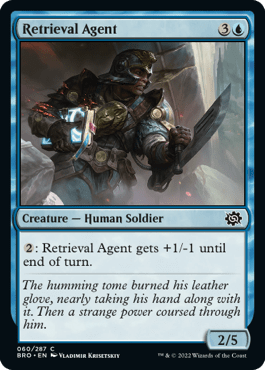
Rating: 3/10
Wishcoin Crab might have been good in its format, but it doesn’t make the cut these days. Even if Retrieval Agent has a minor upside it’s just too expensive to activate and not especially threatening unless you have a lot of spare mana.
Don’t get me wrong, it’s by no means unplayable. I just don’t think a lot of decks will want it.
Scatter Ray
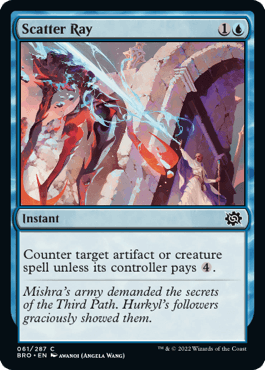
Rating: 5/10
Even though Powerstones can be used to pay for the four, four is still a big enough cost that Scatter Ray is just a straight up Essence Scatter for most of a game.
I doubt you’ll want to counter a noncreature artifact, but that’s just a tacked-up ability that we’ll happily take on a card that’s already good.
Skystrike Officer

Rating: 9/10
Soldiers seem to have so many busted rares going for them, I barely know where to start. You start with a Soaring Drake, which is perfectly serviceable, but then you get two whole abilities that each provide you with easy access to card advantage? Skystrike Officer is ridiculous.
The best curve I can imagine is getting to play a soldier on turns 1 and 2 and then playing this on turn 3 to immediately tap all three and draw a card. Even more simple scenarios make this sound busted.
I honestly wouldn’t be surprised if my rating is wrong and it deserves a 10/10. It’s that good.
Splitting the Powerstone

Rating: 2/10
The biggest thing holding Splitting the Powerstone back is the fact that it’s a sorcery. If it was an instant you could use it in response to removal and have a great time with it, but you have to trade in two cards (plus the artifact we sacrifice) to just get two Powerstones as it stands.
You’re going to want to get some good value by sacrificing something that wants to go to the graveyard before wanting to play this, but there are a few nice options available for you to do that.
Stern Lesson
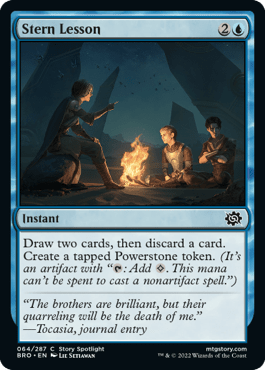
Rating: 3/10
Catalog isn’t a particularly good card, but a Catalog that also nets you a Powerstone is probably good enough for some decks, so I do like Stern Lesson a fair bit.
Take Flight
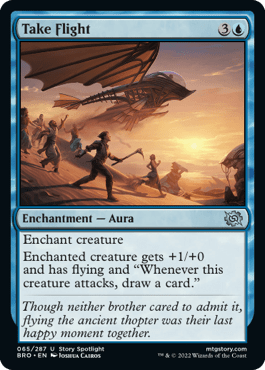
Rating: 1/10
I just don’t like Take Flight. Auras are bad.
You can play this on a creature, have that creature killed and immediately get two-for-oned. Yeah, if you can guarantee getting a hit in and drawing a card then you’re somewhat protected against that, but this costing four mana means you often end up spending your whole turn to do that.
Teferi, Temporal Pilgrim
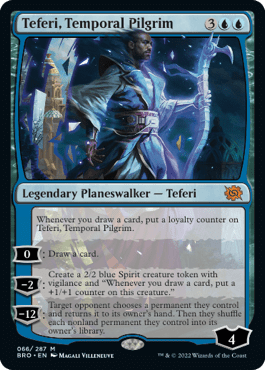
Rating: 10/10
Let’s start with the obvious. Teferi, Temporal Pilgrim protects itself very well by making a very solid creature to block for it, which is often the baseline we look for when determining the Limited playability of planeswalkers.
If you start by running out Teferi, using its -2 and making its Spirit token then you draw for turn, tick Teferi up to three and the Spirit up to 3/3 if it survives on your next turn. Now you can -2 again to make another Spirit and all three go up really high if you cast any draw spell.
The fact that you don’t even need to play draw spells and this ticks up naturally when you draw for your turn and when you use Teferi’s 0 ability makes it very easy for this to become silly very quickly. Above all else the fact that the Spirits only cost two loyalty when you get one free loyalty each turn is just absurd.
If Teferi is left unchecked I can see it easily churning out an army of these things in no time, and each of them will become big enough to be a bomb rare on its own.
Third Path Servant

Rating: 3/10
I really like drawing extra cards, but seven mana is quite a lot. Invokers have typically played out really well in the past, and Third Path Servant’s activation cost looks much easier to accomplish if you’re playing some kind of Powerstone turbo deck.
Otherwise it seems far too slow and lacking in impact for your average deck to want it.
Thopter Mechanic
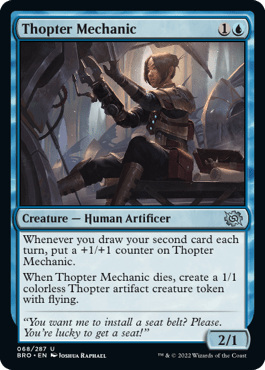
Rating: 7/10
What I find absurd about Thopter Mechanic is that this card would be pretty good with just one of these abilities. Throw both of them into the mix and I think this turns into a premium 2-drop.
Any 2-drop that can grow into a very sizable creature in time while also giving you a nice failsafe for when it dies is pretty good in my book.
Urza, Powerstone Prodigy

Rating: 5/10
Merfolk Looters still tend to be good even if they cost mana to use. While Urza, Powerstone Prodigy is a little bit expensive, paying you off with free Powerstones every now and again is a nice upside that you should be able to make use of.
Urza’s Command

Rating: 8/10
I’d be very happy with a lot of the combinations Urza's Command can give you. Naturally you’re happiest making a Karnstruct token and adding in one of the others, all of which work well in different scenarios.
Overall this command spell is cheap enough that it should be good no matter how you use it, and that makes for a really powerful card.
Urza’s Rebuff
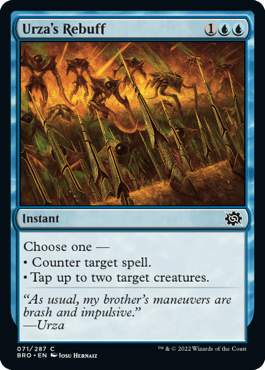
Rating: 3/10
I’d guess that you’ll want to be countering a spell around 90% of the time you use Urza's Rebuff. The question you need to ask yourself is how good Cancel is in this format.
I’d say it starts off as a two or a three, but its value starts to increase if the format ends up being really slow and you’ll start actively wanting it in decks. There are very expensive spells to cast in this set, which leads me to believe I’ll be quickly reevaluating this.
Weakstone’s Subjugation
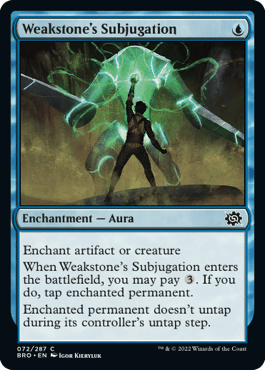
Rating: 6/10
While Claustrophobias have fallen somewhat out of favor in recent years, a great way to keep them relevant is to make them cheaper. We saw this with Bubble Snare just two years ago and Weakstone's Subjugation is nearly the exact same card.
It looks really strong and I’d expect it to perform about as well as the Snare did in Zendikar Rising.
Wing Commando
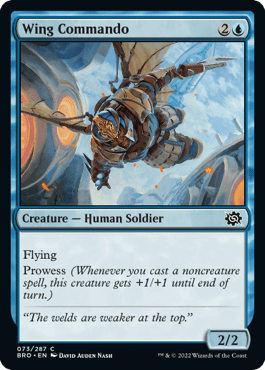
Rating: 5/10
I remember when we first saw prowess we had a nifty little creature called Jeskai Windscout. It was good then, it was good again the few times it got functionally reprinted, and it’s probably good now too.
Especially because Wing Commando is also a soldier.
Zephyr Sentinel
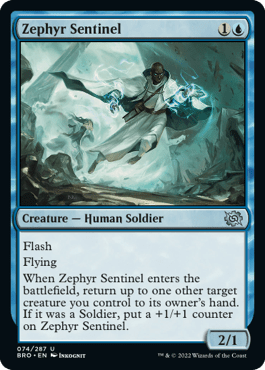
Rating: 7/10
Let’s start by reflecting on the fact that a 2/1 flier for two is a great card and you’d always be happy playing that. Now throw in flash, which isn’t great on a creature that’s bad at blocking but we’ll take it.
Now again you have this optional ability that lets you pick up a creature you had in play to get to reset it or reuse its ETB trigger. The upsides just keep coming on top of a card you’d have been happy with as a vanilla creature.
Zephyr Sentinel is a sweet card all round.
Arcane Proxy

Rating: 7/10
The key to Arcane Proxy is just whether or not you can flashback a good removal spell. You already have good options in other colors for its prototype cost including Disenchant and Go for the Throat.
This shouldn’t be too difficult to get some great value from assuming we have a deck with plenty of good targets for it. The 7-mana mode is a bit weird because I don’t think you’re getting enough of an upgrade, but at three mana it’s very good already.
Coastal Bulwark

Rating: 4/10
When I draft, I’m a big fan of the typical 3/3 defender for just two mana. Coastal Bulwark has to be the best one I’ve ever seen and I’m loving it.
This kind of a wall that also helps dig through the deck and find good spells to cast is exactly what a slower deck needs to stave off the onslaught of aggro decks.
Combat Courier
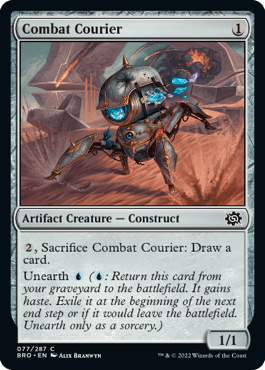
Rating: 5/10
I love everything about this little guy. Get a chump block in, sac it, and draw a card. Later down the line pay three mana to draw another card.
And Combat Courier is also great if you just mill it and unearth it for value. What’s not to love?
Depth Charge Colossus
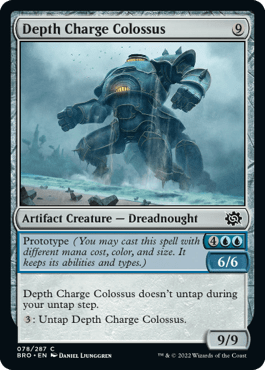
Rating: 4/10
Unlike a lot of the other prototype cards, Depth Charge Colossus’ prototype cost doesn’t really wow me. I’d prefer to just hold out for the nine mana version if you’re intending to ramp with Powerstones.
But this card looks very impactful whichever way you cast it. While the untap cost is a bit restrictive, the way it’s worded allows you to untap it early and use it as a blocker, which is a very nice mode to have.
Hulking Metamorph
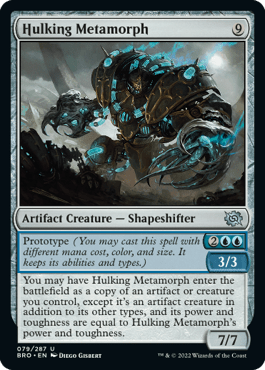
Rating: 5/10
Clones that only copy your creatures haven’t had the best results historically, but you could always play Hulking Metamorph without copying anything in a pinch. You can also copy artifacts, which means you can just come down as an Ichor Wellspring and get a cantripping 3/3 or 7/7.
Odds are you’ll have something at least decent to copy, and this should give you a good amount of value either way.
Spotter Thopter

Rating: 4/10
Spotter Thopter looks a little bit overcosted on both the prototype and hard cast modes, but the combination of either or is still worth looking at. Cloudreader Sphinx was an amazing card and a cheaper version shouldn’t be too bad.
Maybe I’m being too harsh. It still looks like a solid playable.
Surge Engine
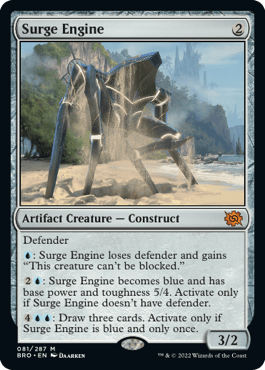
Rating: 9/10
I’m not normally in the habit of giving such high grades to mythic rare defenders, but the ability to immediately lose defender and start swinging is pretty nice. Surge Engine is basically for a 3/2 unblockable creature which is a phenomenal rate, and it can be split up over two turns.
Just in case a 3-power unblockable creature isn’t a fast enough clock, you can even grow it to a 5/4 and draw some cards. This is a fairly bad card to draw when you’re behind on the board, but it’s the very definition of a must-kill threat at every other time.
The Temporal Anchor
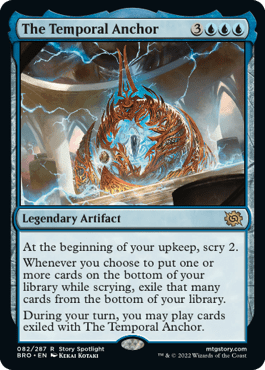
Rating: 3/10
The Temporal Anchor essentially translates to an artifact that lets you draw two extra cards per turn with some drawbacks. It’s pretty hard to cast because even with Powerstones you’ll still need triple blue.
Ultimately I want to like the card, but I think it has too many downsides to really make an impact, even if the format is on the slow side. It would have to be one of the slowest formats we’ve ever seen for me to want it.
Terisian Mindbreaker
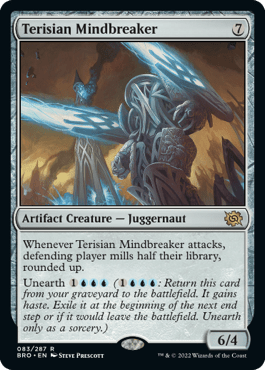
Rating: 5/10
Terisian Mindbreaker is on the weak side, but there’s a surprising amount of mill in the set, particularly on the Retro Artifact sheet. It doesn’t seem that bad to get one or two hits in with this, leaving an opponent with about six cards left, and then just finish them off with a couple Millstone activations.
The unearth ability does make that plan a fair bit more likely to connect, so I think I like this and will be trying it out.
Black
Ashnod, Flesh Mechanist
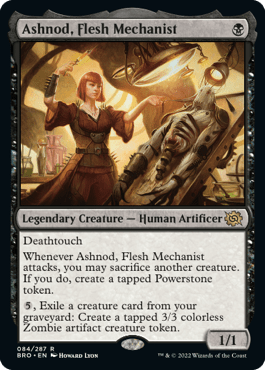
Rating: 6/10
I expected a little better from Ashnod’s first card if I’m being honest. Needing to attack to sacrifice a creature is really quite restrictive. On top of that all you get is a Powerstone.
On the plus side, Ashnod, Flesh Mechanist is a 1-mana deathtoucher, which is always a great start to a card. Being able to make 3/3 tokens at will is pretty brutal in the late game.
Ultimately Ashnod remains a relevant play at all stages of the game even if it’s not the most impressive sac outlet in the world, which you can’t be too upset about.
Ashnod’s Intervention

Rating: 4/10
Here we have our typical Supernatural Stamina variant for the set. Ashnod's Intervention is always a fine card, but not one you often need to run. It has a nice little clause that I think pushes it over the top.
This also returns creatures from exile. You can unearth a creature and use this to have it return to your hand at the end of the turn instead of being exiled. That seems really good to me in the right scenario, even if it means your dying creatures also just return to your hand instead of the battlefield.
Battlefield Butcher
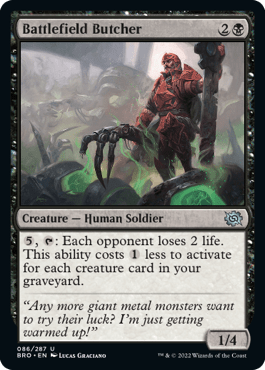
Rating: 5/10
Battlefield Butcher seems like a really nasty defensive creature. A 1/4 blocks pretty well on the ground. and being able to clock your opponent while sitting back on not attacking makes this a really dangerous card to have to play against.
Your opponent will need to spend removal on it given enough time.
Carrion Locust
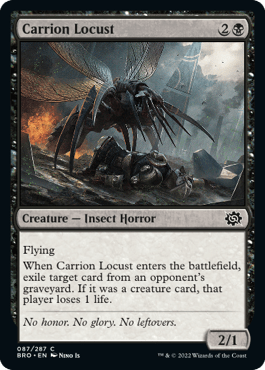
Rating: 4/10
We had Scavenging Harpy in Theros: Beyond Death, a set where black was the best color by far and nothing else could hold a candle to it, and it still looked really good even compared to the rest of its color. Carrion Locust looks very good in a world full of unearth cards, and is a solid inclusion in any black deck.
Corrupt

Rating: 5/10
I have in fact played with Corrupt in Limited before. It’ll usually deal about three or four damage since it’s six mana, and that ends up being perfectly fine given that it gains you life too.
This becomes a ridiculous card that can swing any damage race in your favor if you’re so inclined to draft mono-black, so it’s worth keeping an eye on. Oh, and remember that it can always hit the player too!
Diabolic Intent
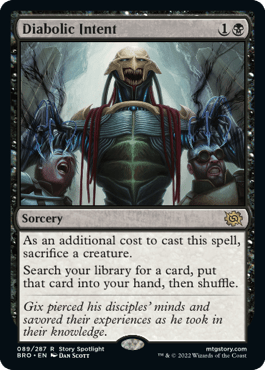
Rating: 0/10
I’m excited to see what this sweet reprint can do for Constructed, but Diabolic Intent is useless in Limited. Even Demonic Tutor would get a 0.
Tutors are only good when the quality of the card you’re getting is high enough that you don’t mind spending an extra two mana to get it, and that’s not likely to be the case with most of the set. There’s enough of a downside on this variant to rule that out completely even if you did have something that powerful.
Disciples of Gix

Rating: 1/10
I get it. The gimmick is that you can dump three unearth creatures into the graveyard and get them back as well as turning on cards that care about the creatures in your graveyard. Except that you also have to be happy casting a 6-mana 4/4, which you’re really not.
I’d much rather just draw the cards and cast them than have to play a terrible vanilla creature like Disciple of Gix.
Disfigure

Rating: 7/10
Disfigure is just one of the best 1-mana removal spells we’ve ever had in Limited. Not only can it kill a lot of 1- to 3-mana creatures, it can be used in combat to shrink bigger creatures and have them lose to yours.
It’s great to see it back and especially at common, so go ahead and pick it up when you draft the color.
Dreams of Steel and Oil

Rating: 5/10
Thoughtseize effects can be decent in Limited, but they’re a little hit or miss. I think Dreams of Steel and Oil is good enough. It hits enough relevant card types that you should find something to take most of the time.
You also get to also attack the graveyard and exile an unearth card. I think I’d rather try this card out and be proved wrong than assume it’s bad.
Emergency Weld
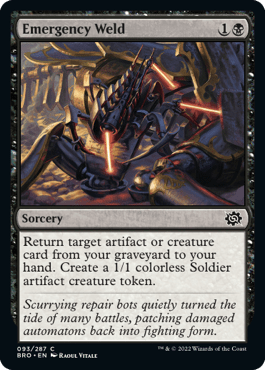
Rating: 5/10
We see a lot of Raise Deads with small upsides these days, but one that gives you a 1/1 token is pretty exceptional. Emergency Weld is effectively a 1/1 Gravedigger for two mana except you can’t flicker it, but that’s a great place to be.
Fateful Handoff
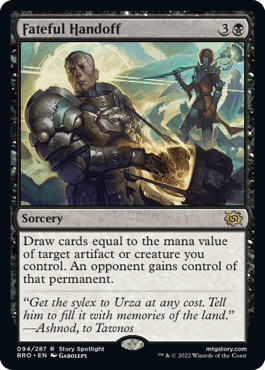
Rating: 0/10
No amount of card draw is going to be worth giving one of your permanents to your opponent. Especially since you need to give them something actually good to draw multiple cards.
Fateful Handoff is a pure Constructed/Commander plant and nothing more.
Gix, Yawgmoth Praetor
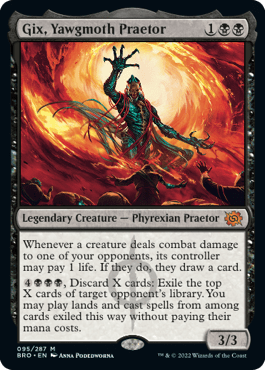
Rating: 8/10
I’m excited for Gix, Yawgmoth Praetor. It’s exactly what Standard needed: another powerful black midrange card…
Anyway. I do like Gix quite a bit. Not requiring any mana to draw the cards with its first ability is very relevant. It means you can curve a 2-drop into this and get a card immediately if they don’t have anything to block with.
Gix’s activated ability is a bit on the expensive side, but at least you can mitigate some of that cost with Powerstones. And it really is powerful enough to be worth it. This card provides a steady stream of card advantage with both of its abilities, so you should just win you the game given enough time.
Gix’s Caress
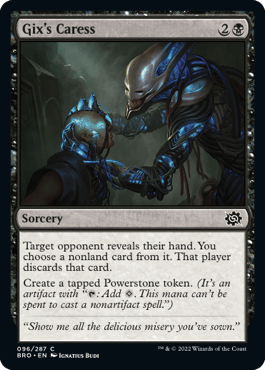
Rating: 2/10
Ramping with a Powerstone is a nice upside, but Coercion effects just aren’t good enough in Limited. I’d be tempted to start one in BRO Sealed and with so many powerful bomb rares lying around I’d be interested in siding Gix's Caress in from time to time, but it’s not good enough for most main decks.
Gix’s Command
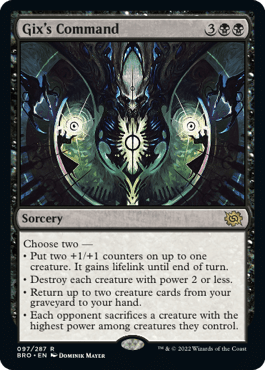
Rating: 10/10
The best part about Commands is just how flexible they are with six different combinations of abilities. With Gix's Command I think you’re mostly looking at the bottom two modes to get the most value.
Drawing two spells and killing the biggest creature your opponent has in play is a big three-for-one swing that you’re very interested in pulling off. Having the options to wipe out all small creatures and going for a big lifelink swing are more narrow options, but having them as extras is a massive deal.
I just don’t see this going wrong for you. Every mode is powerful and you always get to choose the two best ones. High power level and maximum flexibility equals a solid 10/10 to me.
Gixian Infiltrator

Rating: 5/10
You’re generally fine with any 2-power 2-drop as long as it does something else. Gixian Infiltrator could very easily grow into a proper late game threat in the sacrifices deck.
My only gripe is that a lot of the sacrifice outlets appear to cost a good chunk of mana, so you won’t be sacrificing much more often than once per turn. But this can reach scarily high levels even then.
Gixian Puppeteer
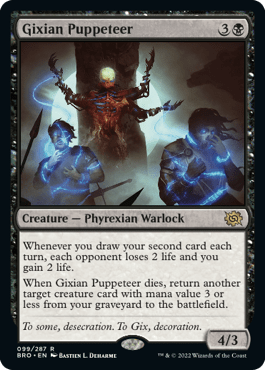
Rating: 7/10
Gixian Puppeteer already has good and efficient stats before we get to its abilities. While you’re not guaranteed to have a creature in the graveyard for when this dies it should be fine assuming that you curve out into it and trade off. At that point this creature very much becomes worth it.
Draining your opponent whenever you cantrip on your turn really helps you to win races. At the very worst trading this off and replacing it with another creature is perfectly fine. Both abilities are good and this should end up being very good on an already fine creature.
Gixian Skullflayer

Rating: 4/10
Gixian Skullflayer starts out on the small side, so you really need to make sure you can trigger it to be useful. It doesn’t take long to become a really annoying threat and eventually becomes a must-kill threat if you can.
It just takes quite a while to get there and is bad when you draw it late.
Gnawing Vermin

Rating: 4/10
Festering Goblin is usually a good card, so tacking on a bit of mill as an upside is pretty nice. Self-mill decks and sacrifice decks should both be interested in picking Gnawing Vermin up, and I can’t imagine a better 1-drop if you have a deck that can do both.
Go for the Throat

Rating: 7/10
I think it’s easy to look at Go for the Throat and assume that it’ll be bad in a set based around artifact creatures. Except this still hits a ton of creatures and is incredibly efficient.
The same issue came up when we last saw it in Mirrodin Besieged, but it was still one of the better black non-rares in that set and it still will be here.
Gruesome Realization
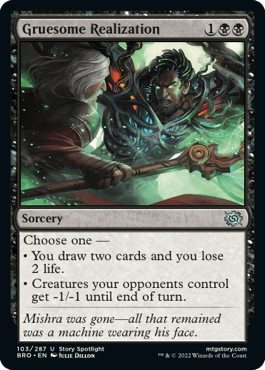
Rating: 5/10
Double black is a little restrictive for either of Gruesome Realization’s modes, but modal spells with two good modes usually end up working out. It looks like the premier aggro deck of the format uses 1/1 tokens to overwhelm you, and you’ll be happy to draw two cards against most other decks.
Gurgling Anointer
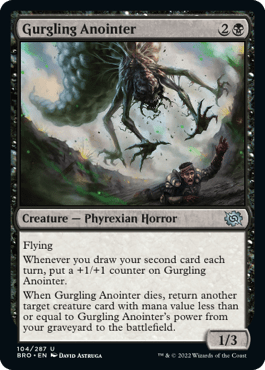
Rating: 7/10
The thing about this draw two archetype is that it’s relatively easy to accomplish. You only need to play something that cantrips to trigger Gurgling Anointer on your turn since you already draw one card every turn.
As we’ve seen from Faerie Vandal, a cheap flier that gets free +1/+1 counters is pretty good. You even get a potentially very powerful death trigger in too. This is probably one of the better payoffs for this archetype.
Hostile Negotiations
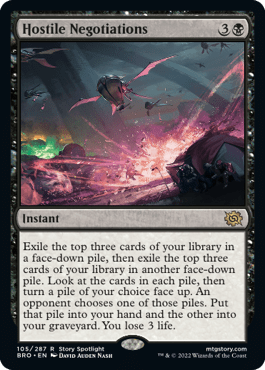
Rating: 7/10
I absolutely love cards like Hostile Negotiations. Anything that lets you play this fun little mind game with your opponent, like Atris, Oracle of Half-Truths or just good old Fact or Fiction.
No matter what pile your opponent chooses you’ll be drawing three cards for four mana, which is a great deal. And you get to play this really fun subgame in the process, and you can probably swing it so that that’s an upside for you too since the other pile goes to the graveyard.
Kill-Zone Acrobat

Rating: 4/10
A 3/2 for three is pretty mediocre on balance, but gaining flying is decent. And you can always sacrifice Ichor Wellspring or spare Powerstones to Kill-Zone Acrobat if you want to get an attack in.
Misery’s Shadow

Rating: 8/10
It might be hard to imagine now, but Nantuko Shade was once a powerhouse that saw play in both Standard and Legacy. Its reprint in Magic 2011 was seen as a bold move, and it was assumed it would likely dominate again. Well, it didn’t, but it was a good card nonetheless.
Misery's Shadow is a strict upgrade over the torment classic and oh boy is it nicer this time. The generic mana costs make this very splashable and not forced into mono-black strategies, which is awesome.
If you play it on turn 2 it threatens to attack as a 5/5 on turn 3, making it extremely difficult to block. Add to that this Leyline of the Void-style ability that shuts off death triggers and hoses unearth creatures and you have one nifty little creature.
Moment of Defiance
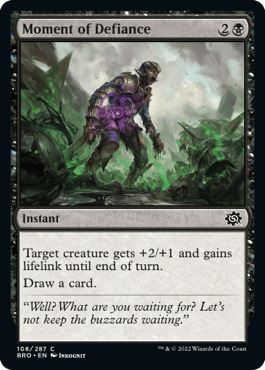
Rating: 6/10
My rating might be a little off, but Moment of Defiance might be one of the best combat tricks I’ve ever seen in black. +1 toughness is a little low, granted, but this draws a card and gives lifelink.
If you have a scenario where this saves your creature in combat you end up gaining say four or five life, drawing a card, and killing their blocker and all for just three mana. That’s insane!
I’m calling it now; this is the black Wildsize, and you can quote me on that.
No One Left Behind
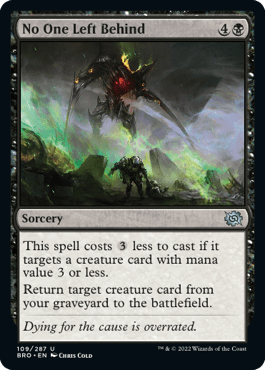
Rating: 3/10
Reanimation spells are very hit and miss. I like that No One Left Behind has a sort of Unearth mode so that you can play it more efficiently sometimes. You may very well want a reanimate spell with there also being some self-milling going on, especially with enormous mechs for you to dredge up.
I’ll have to see it first because I wouldn’t be happy running this in any average set.
Overwhelming Remorse
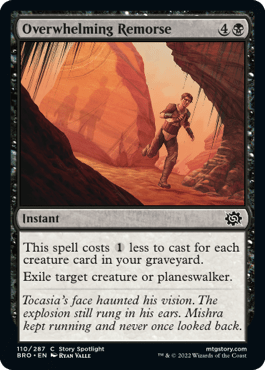
Rating: 8/10
Exiling creatures is incredibly relevant in this format. Not only do you want to make sure that unearth creatures can’t come back for a second go around, you absolutely do not want to lose to Wurmcoil Engine.
The common catch-all removal spell in black is always going to be good, and Overwhelming Remorse even has the chance to cost very little mana. Getting it off for a single black will feel like you’ve cheated.
I’d guess that this is the best common in the set.
Painful Quandary
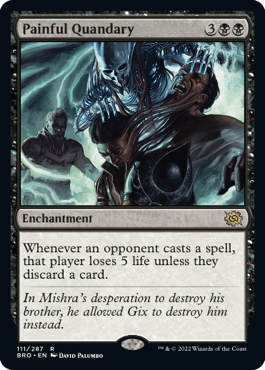
Rating: 1/10
I understand Painful Quandary is another rating that might surprise some Commander players, but this card is pretty bad. While having your opponent lose five life or discard a card whenever they cast a spell sounds great, there are some big downsides here.
First is that you have to cast a 5-mana enchantment that does nothing to affect the board, which isn’t something that you often have time to do. The second is that your opponent has full control of what way they get punished. If they have excess lands in hand then they won’t mind discarding them. If they have plenty of life left then they’ll just pay the life.
You’d cast this and several dozen spells might get cast after it in a Commander game making it quite painful for everyone else, but that’s just not the case in Limited.
Powerstone Fracture
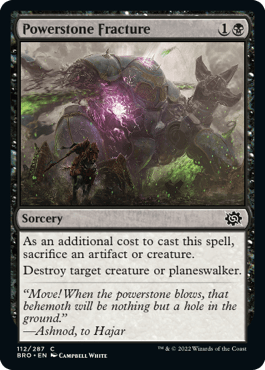
Rating: 6/10
Powerstone Fracture is exactly the kind of card I want to see. We’re used to Bone Splinters costing one mana, but costing two and being able to sacrifice an Ichor Wellspring seems like a very fair trade off.
I think you’ll end up prioritizing this in quite a few Drafts since it should be relatively easy to pay this cost without losing board presence between Wellsprings, Powerstones, and other throwaway items,.
Ravenous Gigamole
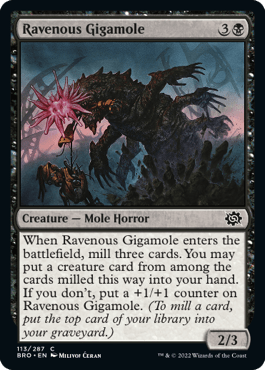
Rating: 5/10
Out of all of these self-mill creatures, Ravenous Gigamole looks like the strongest to me. Hitting a creature basically turns this into Organ Hoarder since it’s the nonland type that’s easiest to hit from your top three.
Whether this is a 3/4 that milled you or a 2/3 that milled you and drew you a spell, it’s really good.
Thran Vigil
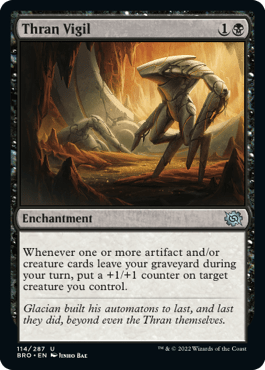
Rating: 0/10
So if I’m reading Thran Vigil right I need to first play this, a whole card that does nothing. Then I need to do something that’s relatively hard to accomplish, especially given how most unearth costs are on the expensive side.
Once I’ve done all of that, my reward is a +1/+1 counter? What? I don’t even get a free creature or a card? No, I’m off it. Too much work to put in for very little payoff.
Thraxodemon
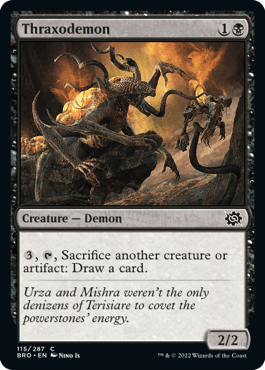
Rating: 5/10
I think Thraxodemon is exactly what you want in the sacrifice decks. It’s a 2/2 for two, which is perfect to play on turn 2, and then later on you start sacrificing stuff for good value.
There’s a lot of good sacrifice fodder to feed to this and make it a really worthwhile play.
Trench Stalker
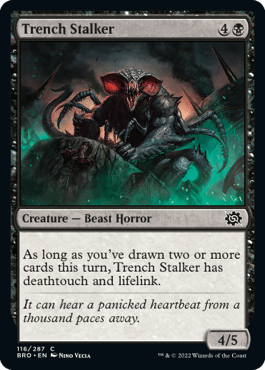
Rating: 3/10
While the “draw two cards” archetype should be fairly easy to enable, I’m not happy enough with a vanilla 4/5 for five to see Trench Stalker making the cut too often.
Ashnod’s Harvester
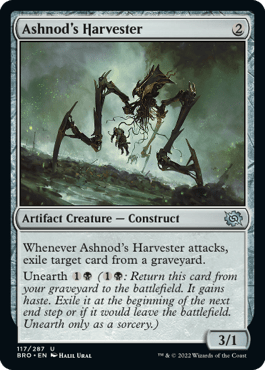
Rating: 4/10
I’m very interested in bits of incidental graveyard hate with unearth cards all over the place plus a Draft archetype based on having creatures in the graveyard. Ashnod's Harvester looks like a simple and aggressive creature that will basically draw you a card by nabbing some pesky unearth creature every now and again, which is a pretty good deal already.
Throw in unearth to give you some extra push potential and I think you have a very solid creature.
Clay Revenant
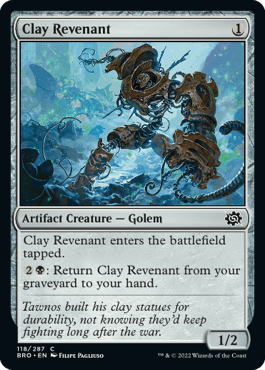
Rating: 3/10
While I do love a Sanitarium Skeleton, I think Clay Revenant entering tapped is too big of a downside for it to deserve a better grade. It’s still great to sacrifice or discard, but not being able to chump block every turn removes enough functionality that I’m only interested in this for very specific decks.
Dredging Claw

Rating: 3/10
On one hand Dredging Claw is a little weak to be constantly reequipping to creatures. But getting a free equip on each creature that you reanimate or unearth sounds like something that I’d be in for.
After all, you probably want to be attacking with the creature you unearth, and giving it menace is a great way of making sure it hits.
Goring Warplow
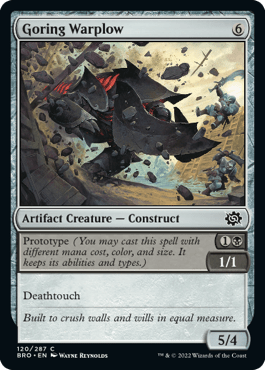
Rating: 5/10
I bet the Simpsons writers didn’t have anything like Goring Warplow in mind when they came up with Mr. Plow (you’re welcome for now having the Mr. Plow theme stuck in your head). I’m always happy with a cheap deathtouch creature that has some upside. and being a 5/4 when you draw it late is definitely an upside I can get on board with.
Phyrexian Fleshgorger
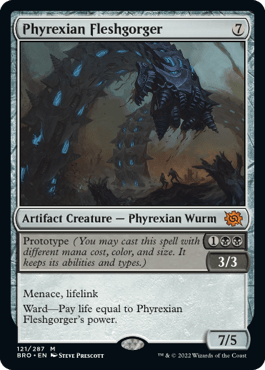
Rating: 7/10
I don’t know about you, but Phyrexian Fleshgorger doesn’t feel very mythic to me. Sure, it’s a beefy creature that costs a fair bit of life to deal with, but a 3/3 for three with menace and lifelink that upgrades to a 7-mana 7/5 with the same abilities isn’t all that exciting.
This is at least hard to deal with removal, but it’s not that difficult to get into combat with and tradeoff for. It’s pretty good to have a solid mid-curve creature that can be cast as a 7-drop if you draw it later in the game so this isn’t exactly a bad card, just somewhat unexciting to see at mythic rare.
Razorlash Transmogrant

Rating: 4/10
You have to be aggressive to want Razorlash Transmogrant because it doesn’t matter how many times a creature can come back from the graveyard, your control deck needs creatures that block. This will basically always cost the full six mana to reanimate so it’s a very late game effect, but aggro decks always want ways to stay relevant and keep doing stuff in the late game.
A 4/2 that never dies and can be brought back at will is probably a good way to do that.
Scrapwork Rager
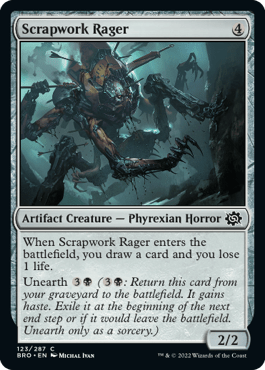
Rating: 6/10
Phyrexian Rager is one hell of a Magic card, so I’m excited to see a version of it that you can get two shots at. Scrapwork Rager costing four mana each time is a bit hefty, but that’s a fair trade for any color being able to play the card upfront and then black decks getting to unearth it.
Transmogrant Altar
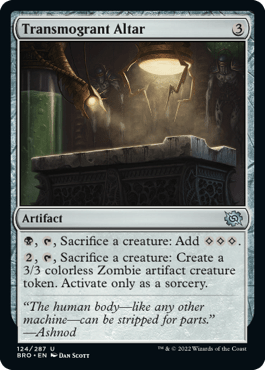
Rating: 5/10
It’s hard to know what to make of Transmogrant Altar without the full context of the set. On one hand sacrificing creatures to turn them into 3/3s sounds like a good thing, but sorcery speed is a little restrictive.
Sacrificing them to effectively Dark Ritual seems good for casting all of these large mechs, so you probably like that. On balance I’d rather use a creature to sacrifice others, but this is a very nice payoff and I’ll likely want one in my sacrifice decks.
Transmogrant’s Crown

Rating: 7/10
I think Transmogrant's Crown looks pretty good. Like a fixed Skullclamp. If you’re a black deck then there’s a good chance that you want to be sacrificing creatures fairly regularly, so paying a single black to keep equipping this and drawing cards off each one sounds pretty good to me.
Even outside of black you can slap this onto cheap tokens and trade them off for value. In typical Limited formats you really need a good reason to play an equipment, and one that can draw you multiple cards over a few turns while helping small creatures trade up is enough of a reason to want to play this one.
Red
Arms Race
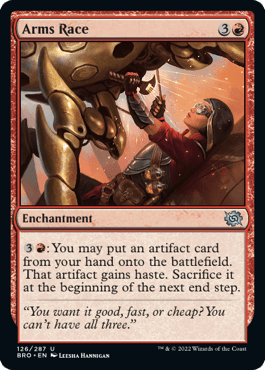
Rating: 0/10
I don’t know why I’d want Sneak Attack in a Limited deck, let alone a nerfed one that costs four mana to activate. There are just so many better things to be spending your mana on than Arms Race.
Bitter Reunion
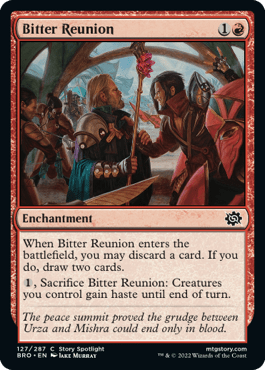
Rating: 3/10
Bitter Reunion is little more than Tormenting Voice with a little upside. At the end of the day it isn’t a creature and it doesn’t interact with the board.
You can’t fit all that many cards in your deck that do that, so I’d advise against playing this unless you have a deck that specifically wants to dig deeper or discard something.
Brotherhood’s End
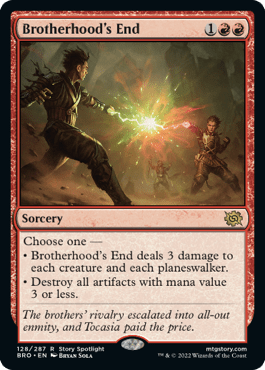
Rating: 6/10
Anger of the Gods variants are fairly decent at doing what they want to do. Brotherhood's End seems to have enough flexibility that you’re interested in it.
It’s easy to set up so that you lose very little but your opponent loses most of their board in the right matchup, at which point you’ll be very happy to have it.
Conscripted Infantry

Rating: 4/10
While I don’t like my 3-drop being weak enough to trade off with 1/1 tokens, getting a free advantage when Conscripted Infantry dies is very nice. This feels a little more defensive in nature because of that since I’d rather make sure it’s going to trade off for something worthwhile.
Draconic Destiny
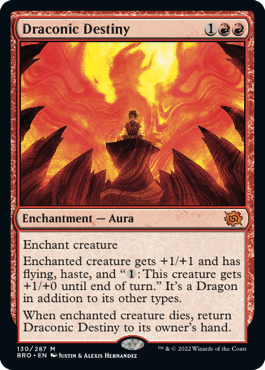
Rating: 8/10
I guess we’re now turning Angelic Destiny into a cycle then. I always say how bad auras are, but one that’s this powerful while also mitigating some of the inherent downsides of auras can end up really busted.
You slap Draconic Destiny onto a creature to turn it into a very powerful threat, then you get it back when it eventually dies and jam it on another creature. But beware: this doesn’t eliminate all of the downsides. Your opponent can still kill your creature in response to you casting this, and they can also bounce or exile your creature.
It goes away in each of those instances, so you need to be aware of that. This is just an incredible card that looks really scary to play against otherwise.
Dwarven Forge-Chanter
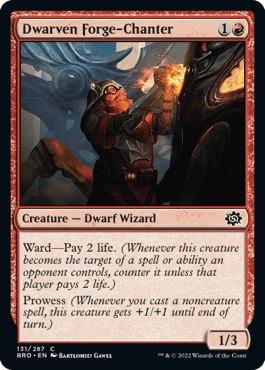
Rating: 3/10
It’s kind of weird to see a ward ability here because it’s just not the kind of card I’m likely to spend a removal spell on. Dwarven Forge-Chanter isn’t big enough to get over most blockers, even with a prowess trigger.
I don’t think I’m very keen on it, but at least the base rate isn’t so embarrassing when you can’t trigger the prowess reliably.
Excavation Explosion
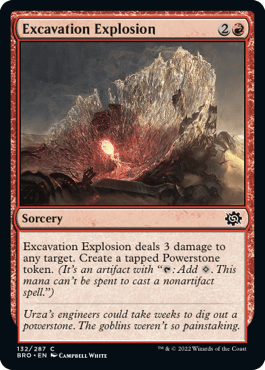
Rating: 7/10
My brother and I were discussing what kinds of effects they’d be willing to print with Powerstone[card]s added, and we never even considered [card]Excavation Explosion. This has to be one of the best ways to do it and it’s going to be the best red common by quite a big margin.
Turn 3 kill your creature and play a 5-drop next turn? Done.
The Fall of Kroog
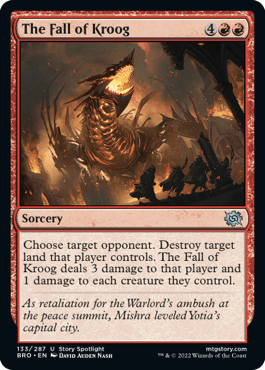
Rating: 0/10
Land destruction is very much not something you’re interested in. With The Fall of Kroog you’re looking at a 6-mana spell that only deals one damage to each creature and three to the face, which is massively overcosted.
Fallaji Chaindancer
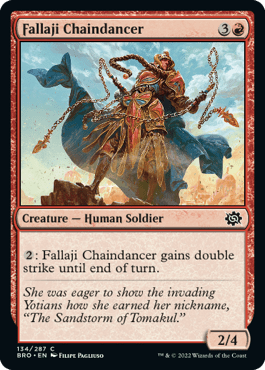
Rating: 4/10
You may need to activate its ability, but Fallaji Chaindancer is basically just a 4/4 for four which is fairly decent. It’s a good creature to fill out your curve with.
Feldon, Ronom Excavator
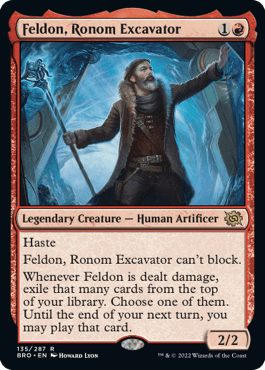
Rating: 4/10
A 2/2 with haste for two is very aggressive, but Feldon, Ronom Excavator will likely get outclassed in a turn or two. You can only really use Feldon in the most aggressive of decks since it can’t block, at which point if it gets some damage in and trades off, leaving you an extra card, that’s not too bad of a card.
But it is very restrictive in his application and I wouldn’t want to play it if I wasn’t planning to be aggressive.
Giant Cindermaw
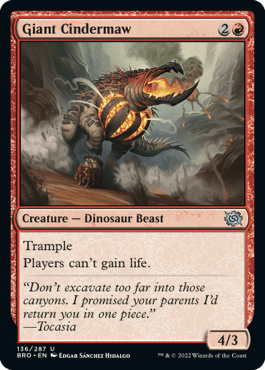
Rating: 7/10
I really can’t believe Giant Cindermaw is an uncommon. Three mana for a 4/3 and you get trample on top of that? Incredible.
Stopping lifegain isn’t hugely relevant but it will be very annoying for some matchups and very unlikely to matter to you.
Goblin Blast-Runner

Rating: 2/10
Even in a sacrifice deck I’m not sure that you’re likely to be sacrificing creatures often enough that Goblin Blast-Runner will be good enough. I can definitely see it making the cut, but it’s very much on the low end of cards I’d be looking to play.
Horned Stoneseeker
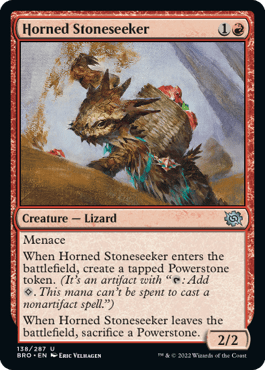
Rating: 6/10
Horned Stoneseeker is likely to survive at least for a short while even if it takes its Powerstone with it when it dies. And if it lets you play a 4-drop on turn three then it’s accomplished its mission.
And even without the Powerstone abilities it’s still a 2/2 with menace for two mana, which I’d want to play any day of the week.
Mechanized Warfare
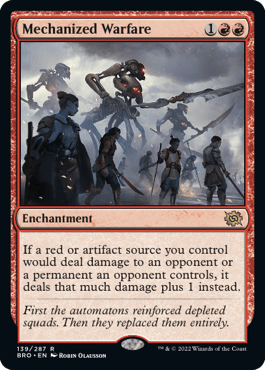
Rating: 2/10
My instinct is to say Mechanized Warfare is really bad. It’s at least cheap and efficient, but this just isn’t good enough most of the time. I kind of like this in a go-wide tokens deck, especially if you combine this with 1/1 soldier tokens, but spending a whole card for no guarantee on return isn’t something I want to be putting in a deck that isn’t specifically built to take advantage of it.
Mishra, Excavation Prodigy
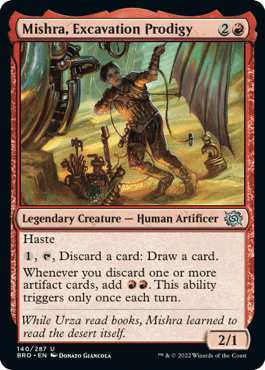
Rating: 5/10
Young Mishra is a nice little card. On an open board you could always play Mishra, Excavation Prodigy and attack immediately. Rummaging is a nice ability that’ll help you smooth out your draws too.
But what I’m really interested in is the mana generation. By paying one mana to rummage you can pitch a random artifact and get two mana back. A turn 3 Mishra will let you cast a 5-drop on turn 4, which is something that most other looters and rummagers just aren’t able to do.
Mishra’s Command
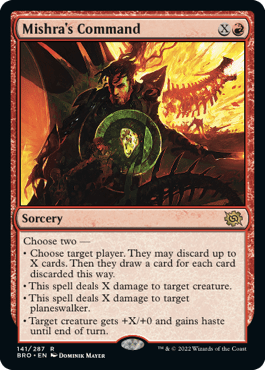
Rating: 6/10
Thankfully Mishra's Command doesn’t also go to the face. The mode you care about the most here is definitely dealing X damage to a target creature. The others are honestly pretty weak.
You can loot away some of the cards in your hand, you can grow a creature for the turn, but you’d like to make sure it’s guaranteed to get a hit if we do that. And of course hitting planeswalkers comes up very rarely anyway.
I’d be giving only a slightly worse grade to Blaze if it was in the set so I’d say it’s only a little better than that. But that still makes it a solid playable.
Mishra’s Domination
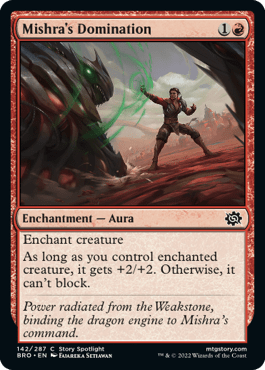
Rating: 3/10
Have you noticed that I don’t like auras yet? +2/+2 for two mana is not good enough when Mishra's Domination is so easy to deal with.
I’m a little more interested in playing this as a Demotion to help get through annoying blockers, but even then this can only be good in a very aggressive red deck and will be bad elsewhere.
Mishra’s Onslaught
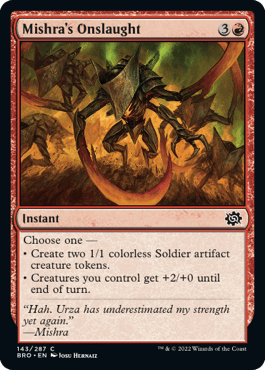
Rating: 4/10
Neither mode of Mishra's Onslaught is particularly exciting for the mana you’re spending, but the combination of whichever one you need at the time probably makes this a pretty reasonable card.
Monastery Swiftspear
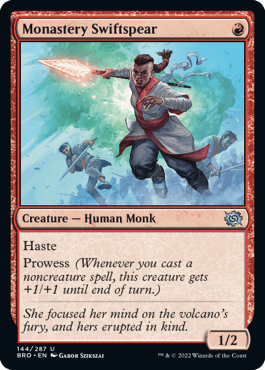
Rating: 2/10
Monastery Swiftspear has been an aggressive staple for over eight years at this point. But the big thing about why is because you can put it into a deck alongside dozens of cheap spells to make sure you’re triggering prowess multiple times per turn.
You might have a couple of spells to play after it in Limited, but most of the time you won’t be able to trigger it. A 1/2 with haste for one with no other text wouldn’t be a good card, and Swiftspear will often be no better than that.
Obliterating Bolt

Rating: 7/10
Four damage for two mana is excellent, and getting to exile unearth creatures with Obliterating Bolt is very relevant for this format. Lava Coil with a little upgrade on it is very nice to see.
Over the Top
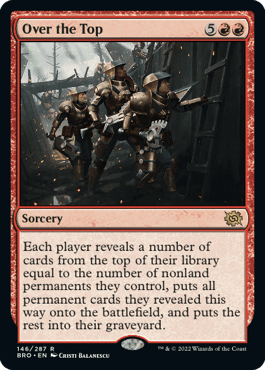
Rating: 0/10
Imagery: 10/10
I imagine Over the Top might get a lot of attention in the coming weeks. It invokes images of soldiers from World War One, particularly in the Battle of the Somme, being sent over the tops of their trenches to almost certain death at the hands of German machine gun fire. And the French translation of it missed the point of the card entirely and appears to have dubbed it as “Exaggeration.”
It’s also a weird coincidence that the first prerelease day for this set happens to fall on Armistice day, the day commemorating the end of the war in 1918. For anyone outside of the UK reading this I’d encourage you to dig up the classic British sitcom Blackadder Goes Forth, in particular the final episode. It pays amazing respect to the soldiers that needlessly died in that battle and is one of the absolute best works of British comedy.
Anyway, I just wanted to provide a little context for the card, let’s get back to the review. Over the Top is cool and might be fringe playable, but unfortunately it’s basically a Commander plant so I don’t think you’re likely to play it much in Limited.
Penregon Strongbull
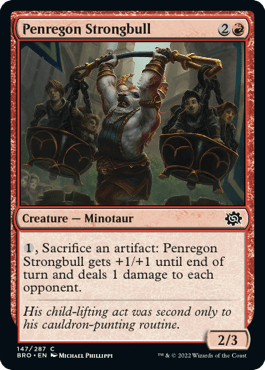
Rating: 4/10
One mana to activate should be cheap enough compared to your other options that Penregon Strongbull will be a fine playable for the sacrifice-themed decks. It also attacks into a lot of boards just based on the threat of activation, so I really like it.
Pyrrhic Blast

Rating: 6/10
The only thing I don’t like about Pyrrhic Blast is that the damage it deals is dependent on the size of what you sacrifice. So you can’t just sacrifice a random token and have enough damage to kill something good.
But this is an instant, which means that the best line of play you can do is sacrificing your big creature in response to a removal spell, drawing a card and killing a creature in the process. You can also do this with a chump block of some kind.
Four mana is quite a lot to be holding up in case this scenario presents itself, but the payoff is enough to reward you for doing it.
Raze to the Ground

Rating: 5/10
It’s funny that Raze to the Ground would be unplayable in most sets but of course artifact removal is close enough to straight up creature removal in a set like this. Three mana and sorcery speed lacks a bit of the flexibility that something like a Shatter would have, but this is still very solid and I’m happy to run it in any deck.
Roc Hunter

Rating: 4/10
Best be looking out for the secret reach card. An aggressive 2-drop that can black important fliers and trade nicely with them looks really good to me. Oh, and Roc Hunter is a soldier too.
Sardian Cliffstomper
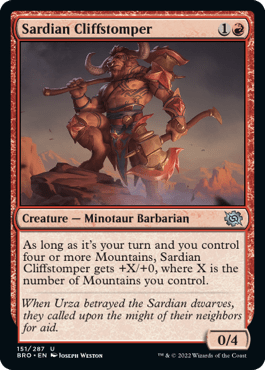
Rating: 1/10
You aren’t likely to find four Mountains until you get up to seven or eight lands with most decks, so a 2-drop that’s little more than a vanilla wall until you reach that doesn’t sound like a card most decks are going to be interested in. Sardian Cliffstomper will go up in value a little in mono-color, but I don’t know how likely you are to be doing that.
Sibling Rivalry

Rating: 4/10
Sibling Rivalry is just the Threaten for the set, and there’s a sacrifice theme. The rating for this could easily go up if that deck is viable.
The trick for anyone not familiar with it is to steal an opponent’s creature and then sacrifice it for value before it goes back at the end of the turn. The Threaten variant has ended up as one of the best commons in the set when we’ve had good sacrifice themes in the past, so this is worth keeping an eye on.
Tomakul Scrapsmith
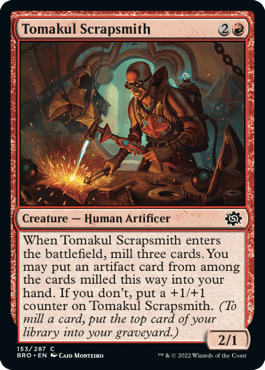
Rating: 5/10
With so many artifacts in this set Tomakul Scrapsmith is bound to hit a spell quite a lot of the time, making it an incredible cantripping creature. And a 3/2 that fuels the graveyard is still excellent even if it doesn’t.
Tyrant of Kher Ridges
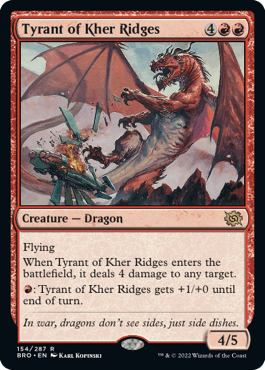
Rating: 10/10
Glorybringer was the most broken rare in Amonkhet Limited, and Tyrant of Kher Ridges is very similar. Immediately killing a good-sized creature when it enters is fantastic, and the four damage can even go to the face and finish off your opponent in the late game.
On top of all that the Firebreathing ability makes this a giant threat in combat. Costing six mana is a little bit high, but at this point I’m really clutching at straws to find something bad about it. The card is just excellent.
Unleash Shell
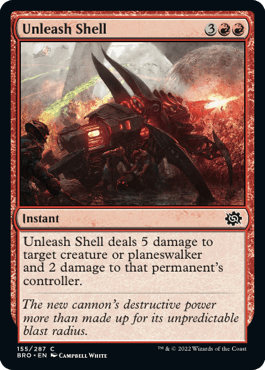
Rating: 5/10
Five mana for five damage is usually just outside the realms of playability. We just had Jaya's Firenado in the last set and it often didn’t make the cut.
But Unleash Shell is quite a bit more playable than some of those other versions. Two damage to the face is a nice touch, but being an instant is the big pull for it. Now you can start using it to kill off double blocks and respond to pump spells, making it a lot more functional.
Visions of Phyrexia

Rating: 7/10
Enchantments that basically draw you a card each turn in red have been quite strong recently, especially Furious Rise. Visions of Phyrexia costs a little extra mana but has no hoops to jump through to get the card each turn, which is a real bonus.
On top of that you have a very good failsafe if you can’t use the card you exile. It’s also worth noting that this will create a Powerstone on the turn it’s played since you’re unlikely to have played a card from exile. This means you have a one-sided Howling Mine that also ramps you, which is an excellent place to be.
Whirling Strike
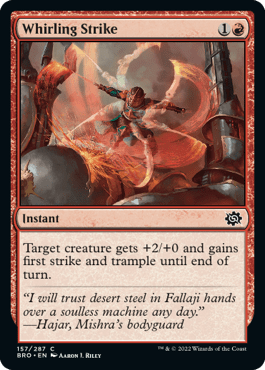
Rating: 4/10
It’s really nasty to have a combat trick that gives both first strike and trample. You usually end up playing around one or the other but seeing both is just annoying.
Whirling Strike is still just your average red combat trick for the set, but it looks like it should play out really well.
Blitz Automaton
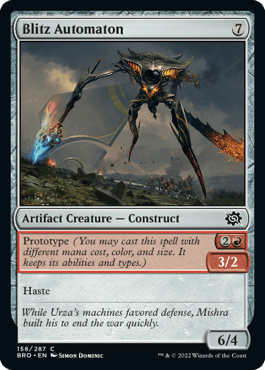
Rating: 5/10
Haste is a really powerful mechanic for Limited aggro decks. Being able to build a board and then play a haste creature on the turn you plan to attack can really help to swing that combat further in your favor.
I’m happier with Blitz Automaton at three mana because of this, but sometimes you’ll be mana flooded and can actually drop this for seven. Having that possibility pushes this up a fair bit in my estimation, and it looks really solid.
Fallaji Dragon Engine

Rating: 5/10
The 8-mana version of Fallaji Dragon Engine looks very overcosted for what it does, but the 3-mana version is really good. Since you get the 3-mana version with the possible upside of casting it for eight mana when you have a bunch of excess mana, that makes it a card I’m happy playing.
You can also pay for its ability with Powerstones, which is a really nice upside to have.
Heavyweight Demolisher
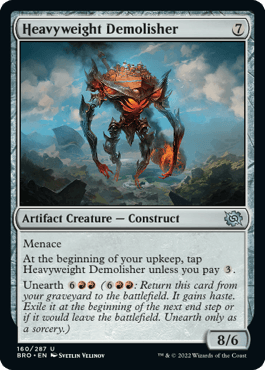
Rating: 5/10
Heavyweight Demolisher really can’t go into your deck unless you have ways to accelerate it out. The upkeep cost is very annoying to maintain but at least it’s manageable.
While menace looks weird on such a big creature since it likely needs to be double blocked anyway, it stops it from being chump blocked by 1/1s all day long.
Mishra’s Juggernaut
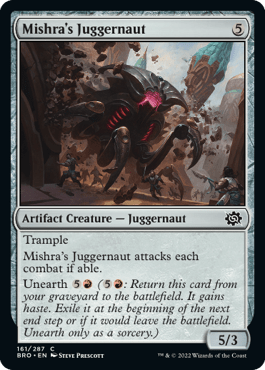
Rating: 4/10
Flavor: 0/10
Yeah, they made Mishra's Juggernaut a 5/3, but Juggernauts are supposed to be unblockable by walls. Come on WotC…
Other than this egregious flavor fail, Mishra's Juggernaut still hits a lot of the right notes. It’s well costed and has trample, even if it has to attack every turn, and the unearth cost will be able to swing combats in your favor in the late game.
Mishra’s Research Desk
Rating: 5/10

Normally a card like Mishra's Research Desk would be a bit rubbish, but this innovative new take on unearth really makes it shine. You need to sacrifice it the same turn that you unearth it meaning three of your mana will have been used, but you get a whole extra turn in which to use it so that’s not much of a downside.
In a roundabout way this is letting you draw two extra cards out of four choices and also hits artifact synergies while doing it, so I really like this one.
Phyrexian Dragon Engine
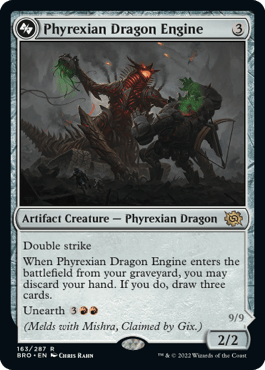
Rating: 7/10
Phyrexian Dragon Engine is the first of three meld pairs, so I’ll point this out here. The ratings I give for these six cards is based purely on the cards by themselves. Given that each pair is made up of one rare and one mythic they’re extremely unlikely to get together in a Limited deck. If you make it happen then that’s awesome, but for the most part I’m just going to consider the cards on their own.
Now that that’s done with, let’s look at Phyrexian Dragon Engine. This is a really brutal card on both sides. Upfront it’s a 2/2 double strike for just three mana and that’s already good, but then you can unearth it and draw a new hand when you get into the late game.
I like both modes of this and pretty much any deck will be happy with a simple 2/2 double strike for just three mana, so I expect this to get picked up early at a Draft table.
Scrapwork Mutt

Rating: 5/10
Immersturm Raider was a decent card in Kaldheim and now every color has access to it. On top of that red decks will be able to get two bites of the apple, which makes Scrapwork Mutt a really nice package and good to draw at any point in the game.
Skitterbeam Battalion
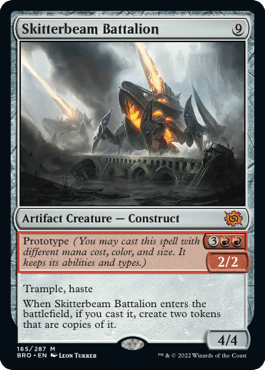
Rating: 9/10
Now this is something we can sink all of our Powerstones into. Nine mana for a trio of 4/4s with haste and trample sounds very good indeed. The failsafe cost of just five mana to get them as 2/2s is also decent, but I think you’re really looking at the full nine mana here.
Haste is so ridiculous on Skitterbeam Battalion. You’ll have board stalls that get completely wrenched open by a player slamming this and hitting the “attack all” button. This is also one of the best things in the set to pick up and recast with the various ways there are of doing that.
I just don’t see how you’re ever going to be able to do that since they’ll already be dead.
Green
Alloy Animist
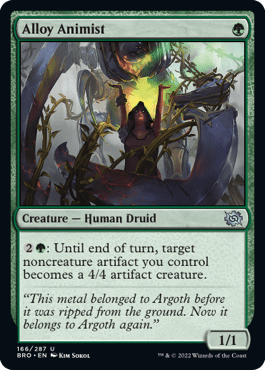
Rating: 7/10
I still remember the obscene turns I had when playing with Avalanche Caller back in Kaldheim. It shouldn’t be too difficult for Alloy Animist to have a steady stream of artifacts to animate and throw at the opponent thanks to Powerstones, and you can even pay for the ability with others that you have.
This can also come out of nowhere since it’s so cheap and completely surprise your opponent with a couple of 4/4s that they didn’t know they had to consider.
Argothian Opportunist

Rating: 5/10
Perfect. You want to be powering out Powerstones, and Argothian Opportunist is likely one of the best ways to get them out early. This is likely going to be one of the most important commons you’ll want to find for that deck.
Argothian Sprite
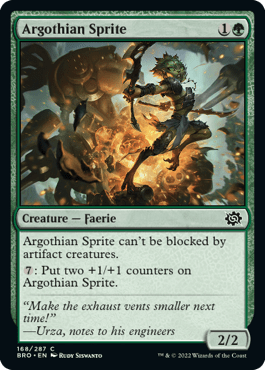
Rating: 5/10
I love this throwback to Argothian Pixies. Unblockable by artifact creatures is presumably going to be very relevant, but above all else Argothian Sprite is a solid 2-drop that continues to be relevant later in the game. Like a Sauroform Hybrid that just keeps getting bigger.
I can imagine this being a 10/10 in some games, except it gets to attack past your opponent’s 10/10 mechs.
Audacity
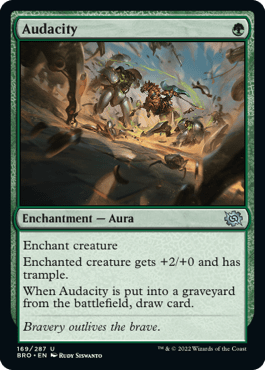
Rating: 5/10
Rancor is one of the best auras of all time, and Audacity does a reasonable imitation. +2/+0 and trample is perfect for making sure your giant creatures can connect for damage and cycling when it dies is a good way to stop you getting hit by a two-for-one.
I especially like that this just needs to hit the graveyard to trigger, so your creature can be bounced or exiled and you still draw the card.
Awaken the Woods
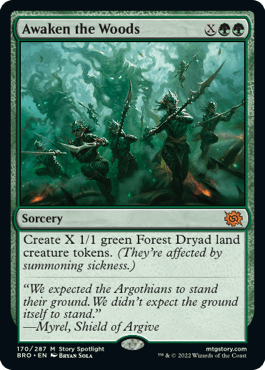
Rating: 8/10
to make X Dryad Arbor tokens is such a weird effect I barely know where to start. You can cast Awaken the Woods for six mana and then have access to 10 mana on the next turn.
X needs to be at least two for you to be interested, at which point it seems really good for both mana ramp and providing a steady stream of chump blockers. I’m always a little skeptical of what’s essentially a ramp spell that requires a lot of mana to cast, but it’s flexible and is still effective when you cast it for less mana so it probably ends up being pretty good.
Blanchwood Armor

Rating: 1/10
We’ve seen Blanchwood Armor a few times before. Auras are inherently bad for several reasons, but even if you did want them I don’t think this does enough. On average this will be on par with or worse than Oakenform, which isn’t really a good card.
I could see it feasibly making the cut in a mono-green deck, but outside of that I wouldn’t bother.
Blanchwood Prowler
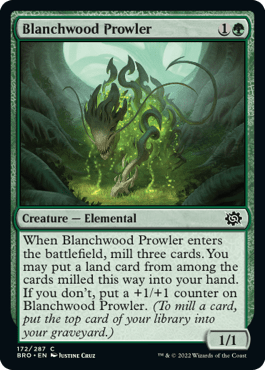
Rating: 4/10
I like Blanchwood Prowler quite a bit less than the other creatures in this cycle. It’s smaller and can only get back a land card.
That said it’s in the color that wants to mill itself the most, so it might end up being one of the better ones in the whole cycle.
Burrowing Razormaw

Rating: 4/10
You’d certainly rather that your 3-drops didn’t trade down for 2-drops, but if you hold back then Burrowing Razormaw could potentially trade up for something bigger. Either way this is a fine curve filler with a very nice death trigger to fuel your graveyard shenanigans.
Bushwhack
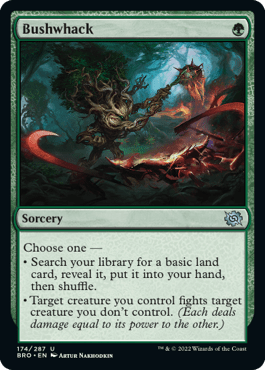
Rating: 6/10
Prey Upon and Lay of the Land are both sorceries that are just about playable but have some significant drawbacks. A modal spell that gives you the choice of one or the other sounds excellent to me.
They’re both good in different situations, so Bushwhack is unlikely to ever be that bad.
Citanul Stalwart

Rating: 4/10
Yeah, we’re a long way departed from WotC letting us have Llanowar Elves, but variants like Citanul Stalwart can still have their place. Being able to tap artifacts makes this functional enough that I’m happy with it in some decks, but I’m going to really want the acceleration to bother with it.
Epic Confrontation
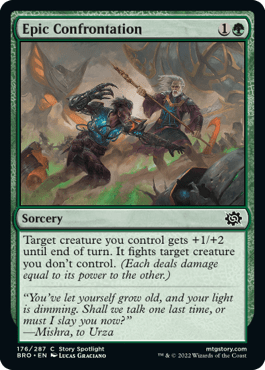
Rating: 6/10
As fight spells have gotten worse over recent years it’s been a long time since we had a good one. +1/+2 should be more than enough to guarantee you survive a fight against whatever it is you want to be killing, which should make Epic Confrontation a premium removal spell for green.
Fade from History

Rating: 10/10
I mean, come on. Look at Fade from History! How can this card be anything less than a ten?
I think I know what I’m collecting out of this set anyway…
Real Rating: 7/10
In all seriousness, Fade from History is actually quite good. This will be as good as Plague Wind against some decks. Giving your opponent an adorable bear cub in exchange for a couple of giant mechs sounds like a good tradeoff, and you can just make sure to play out your non-artifact cards first if you know it’s coming.
Fallaji Excavation

Rating: 5/10
I’m not sure what rate I’m expecting to get my Powerstones for, but getting three of them for five mana sounds okay. Getting three life as well should help to stem the bleeding since you’re essentially taking a turn off from playing anything impactful, and then you can cast an 8- or 9-mana creature the next turn.
Fauna Shaman
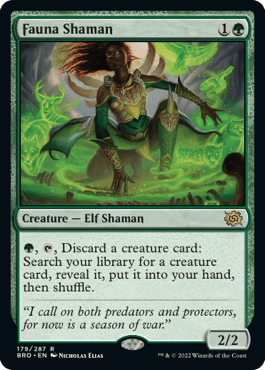
Rating: 5/10
Fauna Shaman wasn’t on my list of cards I wanted to see reprinted, but it’s a really sweet one nonetheless. It doesn’t do much for you here, but drawing into weaker creatures in the late game and trading them in for a giant mech sounds good.
It’s basically just a bear in the early game but it can load the graveyard with creatures, so that’s definitely a plus.
Fog of War
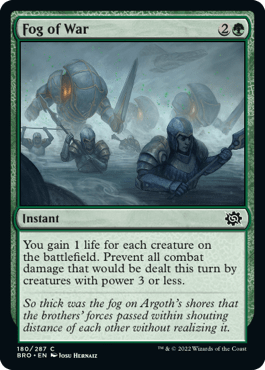
Rating: 1/10
You had me at a Fog that gained some life, you lost me at the Fog part being conditional and doing nothing to big creatures. No thanks.
You might want to keep Fog of War in mind in your sideboard against go-wide strategies, but otherwise it’s not worth it.
Gaea’s Courser
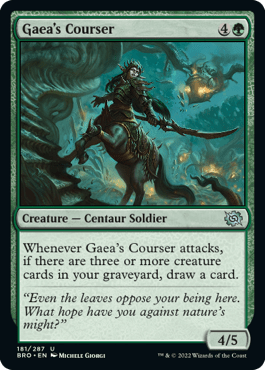
Rating: 6/10
While Gaea's Courser looks like a decent payoff for the graveyard-based decks that you can play, it does look a little bit on the slow side. Needing to play out this creature and then wait until the next turn before getting paid off feels a bit painful, but I don’t mind putting the effort in or waiting a little longer when the payoff is getting to draw a card with every attack.
Gaea’s Gift
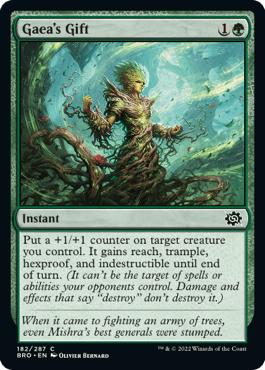
Rating: 5/10
What on earth? A +1/+1 counter and four, count ‘em, four keywords? Gaea's Gift feels a lot like green’s answer to Take Up the Shield. Hexproof and indestructible protect against virtually every removal spell in the game, reach lets you ambush fliers, and trample makes this even absurd on attacking.
I can only see this being bad if green is bad at aggro in this set, but this is a big winner other than that.
Giant Growth
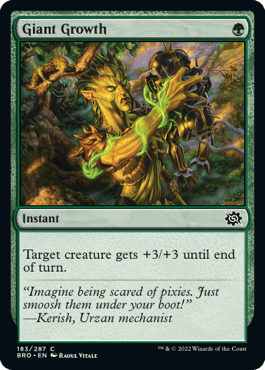
Rating: 2/10
It’s been a long time since we wanted to pick up Giant Growth. Giant Growth is still cheap and efficient, but a bit too underwhelming for modern Limited sets.
Given the choice I’d much rather take the more flexible option of Gaea's Gift.
Gnarlroot Pallbearer
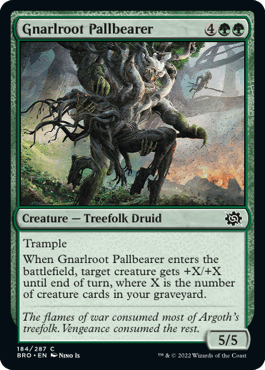
Rating: 3/10
Gnarlroot Pallbearer is on the small side for a 6-drop, and there’s no guarantee that there will be enough creatures in the bin for this ability to even have enough impact. It’s mediocre but still at least borderline playable.
Gwenna, Eyes of Gaea

Rating: 8/10
Gwenna, Eyes of Gaea looks absolutely absurd. A 3-drop that lets you cast a 6-drop on turn 4 is nuts. Not only that but the untap ability lets you cast even more spells. You could cast a 5-drop on turn 4, untap Gwenna, and still have enough mana left over for a 3-drop.
All the while Gwenna is growing bigger and becoming a legitimate threat on the board. I’m a big fan of mana ramp in Magic, and this has me very excited to try it out.
Hoarding Recluse
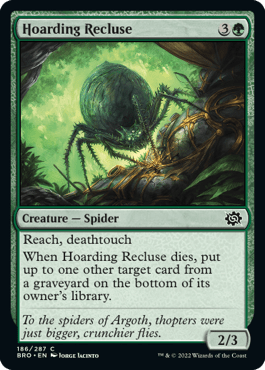
Rating: 4/10
There’s nothing really to dislike about a nicely-sized deathtouch spider (unless it was real, I guess…) Hoarding Recluse’s death trigger can also be used to attack an unearth creature or reload a good card back into your deck, so it’s pretty much just all upside.
Obstinate Baloth
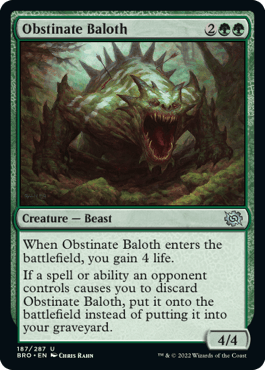
Rating: 7/10
I used to love getting players with Obstinate Baloth back in Standard, but that was many years ago. You’re unlikely to be cheating it in in Limited, but a 4-mana 4/4 that gains you four life is already an incredible creature.
Perimeter Patrol

Rating: 4/10
Centaur Courser is a good creature, but one that falls a little short of the mark in modern Limited sets. Tack on a relevant creature type and the fact Perimeter Patrol often gets to attack as a 4/3 or a 5/3 and you have yourself a good and solid playable.
Sarinth Steelseeker
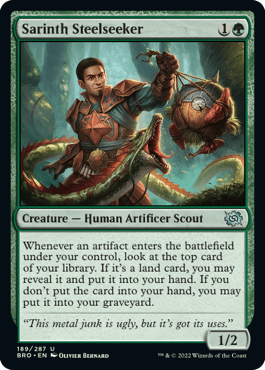
Rating: 6/10
We’ve seen a variety of cards like Sarinth Steelseeker, from Dryad Greenseeker to Nessian Wanderer, and they’re always great. The ability is a little bit limited in application compared to those examples but they were ridiculously broken uncommons, so being just a very good uncommon is still a great place to be.
Shoot Down
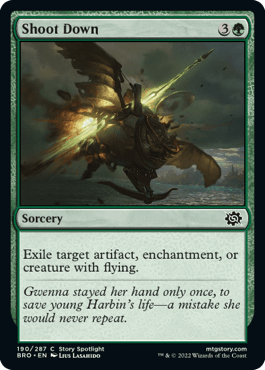
Rating: 6/10
Broken Wings is always a stellar sideboard card to see. While Shoot Down is somewhat different at one extra mana, being a sorcery, and instead exiling its target, this is being printed in a set based heavily around artifacts.
A 4-mana sorcery that can exile what will likely be about half of the creatures in the set sounds like a premium removal spell to me.
Tawnos’s Tinkering

Rating: 3/10
We’ve seen a few of these kinds of cards before, like Dragonscale Boon. The fact that they’re combat tricks that leave behind a permanent buff is often good enough for the cost you’re paying, but you can never play too many of them.
You do get a nice upside in being able to also animate a noncreature to block with, but Tawnos's Tinkering’s effect is still lacking a little in impact.
Teething Wurmlet
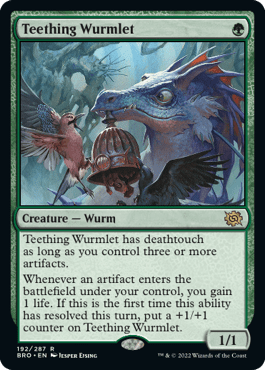
Rating: 7/10
Look how adorable Teething Wurmlet is! And not a bad card either. If you’re turbo-ing out Powerstones then this is one of the most absurd turn 1 plays I can imagine. If left unchecked you’ll end up gaining a ton of life and it’ll be a 6/6 deathtouch before you know it.
Even if you draw it late you’re very likely to have metalcraft to make this a Sedge Scorpion and still be a relevant late game play.
Titania, Voice of Gaea
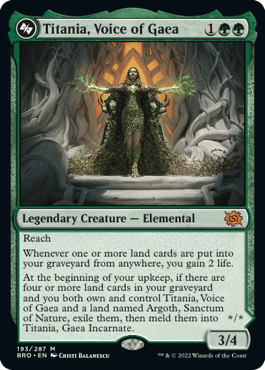
Rating: 6/10
A 3/4 reach for three mana is very much above the rate you expect, and Titania, Voice of Gaea gains life whenever you mill a land, but that’s about it. That makes Titania a decent card, but far less exciting without the ability to meld.
Titania’s Command
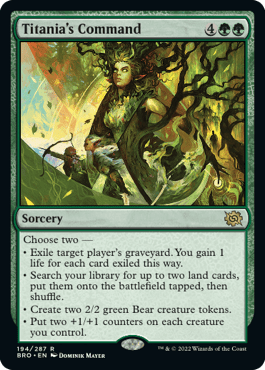
Rating: 10/10
We have another busted Command and it’s all thanks to two abilities. Specifically the last two.
Abilities on a card always resolve in the order in which they’re written, meaning that if you choose the final two modes the 2/2 bear tokens enter first and then pick up the +1/+1 counters from the last mode. If you have no creatures in play then this gives you a pair of 4/4s. If you do have creatures out then all of a sudden Titania's Command is an insane Overrun that also gives you some free creatures.
I don’t even need to mention the other two modes, but it will come up every now and again. Especially the first one which could gain you double digits of life while hosing an entire deck’s theme in the right matchup. This is just absurd for Limited, and I suspect I’ll be losing to it quite a lot.
Tomakul Honor Guard
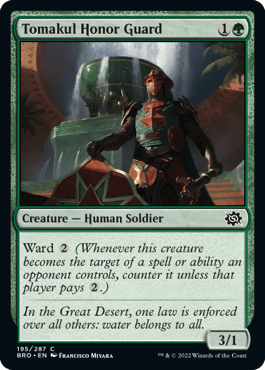
Rating: 3/10
Ward is so weird to see on a creature that’s so easy to kill in combat, but Tomakul Honor Guard is a 2-drop soldier with three power so there should be a home for it. It’s just not that exciting.
Wasteful Harvest

Rating: 4/10
For these self-mill decks to work they need enablers like Wasteful Harvest to dig further into the deck while not giving up resources. Hitting any permanent should mean that you always hit at least a land, so this will be something that you actively want in the right deck.
Boulderbranch Golem
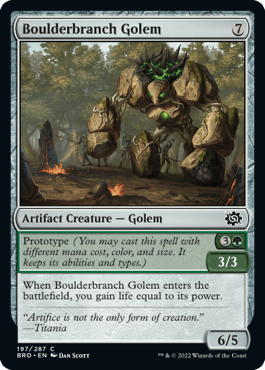
Rating: 5/10
I was hoping we’d see a Honey Mammoth in the set, and Boulderbranch Golem really delivers. The option to be a 4-drop that gains you three life or a 7-drop that gains you six is really exceptional, and this is exactly what ramp decks need to stay alive against the aggressive soldier decks.
Cradle Clearcutter
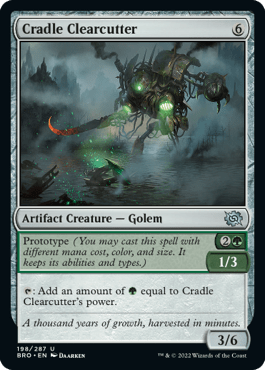
Rating: 4/10
These 6-mana dorks make me feel like we’re back in the time of Legends, but tapping for triple green does let us cast our very expensive creatures. As a three-drop, it’s also very defensible and should help you get to the late game a little faster.
Haywire Mine

Rating: 2/10
Haywire Mine is so close to being good, but I’ll have to see what kinds of noncreature artifacts we want to hit in order to want to play this. A sacrifice deck might want it to sac off and gain life from, but it doesn’t seem quite good enough overall.
Iron-Claw Crusher
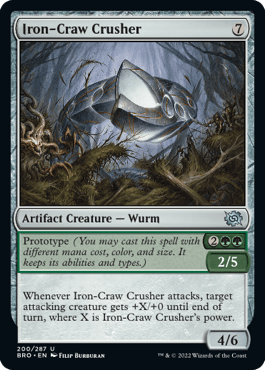
Rating: 6/10
Iron-Claw Crusher can target itself if you want it to, which essentially means that the prototype version gets to attack as a 4/5 for four. That’s a really good base rate for the card and it can only get stronger from then on.
Casting it for seven mana is okay, but attacking as a 7-mana 8/6 is a little less impressive. At that point I’d just be happier buffing other creatures instead.
Mask of the Jadecrafter
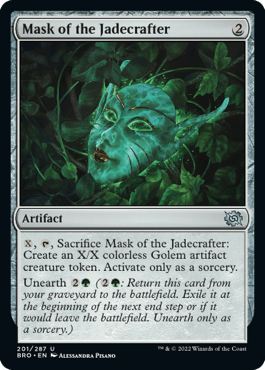
Rating: 6/10
What I like about Mask of the Jadecrafter is that you can just slot it onto your curve whenever you have two mana spare, then crack it to make an X mana X/X in a later turn.
The unearth cost is a bit expensive since you don’t get the opportunity to unearth it and then wait for a later turn, but still a very good upside that you’ll happily take as a bonus.
Perennial Behemoth
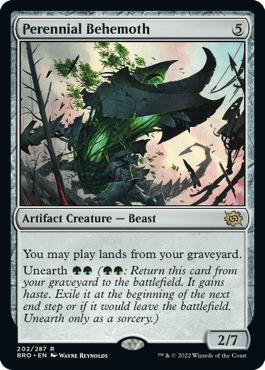
Rating: 3/10
Getting to play lands from your graveyard is an extremely powerful ability, but not one you can really make use of in Limited. Perennial Behemoth is little more than a large vanilla creature, and it’s a very weird one as a 2/7.
It should be a strong blocker and a weird thing to unearth, but this seems at least fine to gum up the ground with thanks to the self-mill plan.
Rootwire Amalgam
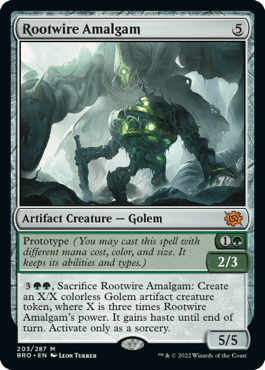
Rating: 9/10
The split card of a 2/3 for two and a 5/5 for five is already something I’d put in any green deck, and Rootwire Amalgam’s activated ability is the icing on the cake. I love the idea that I can turn my 2/3 into a 6/6 or my 5/5 into a 15/15 for five mana.
Haste is a really nice touch that your opponent needs to be aware of when facing this down because they don’t exactly have long before this runs them down.
Rust Goliath
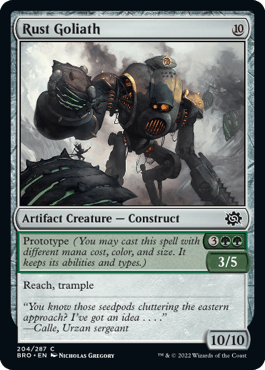
Rating: 6/10
I have to imagine that a ten mana 10/10 with trample is exactly the kind of boss monster you want if it’s worth ramping into massive mechs with Powerstones.
Its failsafe being a Mammoth Spider is superb, and that’s a card you’d probably play even without its 10-mana mode.
Simian Simulacrum
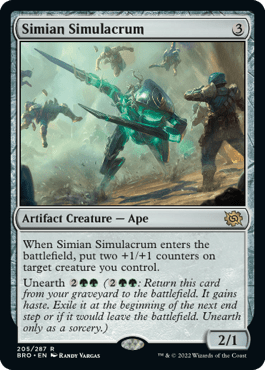
Rating: 8/10
While I’m a little disappointed that a card with “Simian” and “Simulacrum” in its name doesn’t give you any mana (because of Simian Spirit Guide and Solemn Simulacrum, in case you missed the reference), Simian Simulacrum is still a very fine card. It can be a 3-mana 4/3 in any color in a vacuum.
The unearth cost wants you to have a creature in play to put the counters onto, but that shouldn’t be that hard to achieve. Whether you just use it to beat down or you put the counters elsewhere and use the original creature as sac fodder, the numbers all add up on this to make it a very good card.
Multicolored
Arbalest Engineers
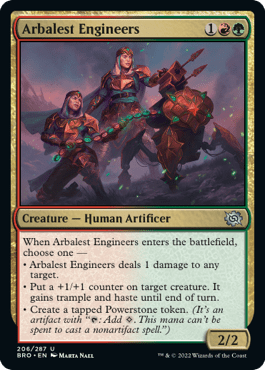
Rating: 7/10
There’s nothing to dislike about Arbalest Engineers. Every mode is fantastic. Either you ramp yourself, kill a small creature, or smack them hard with a 3/3 with haste and trample.
The flexibility of this card is exactly what I look for in good Limited cards, and I’m excited to play with it.
Battery Bearer
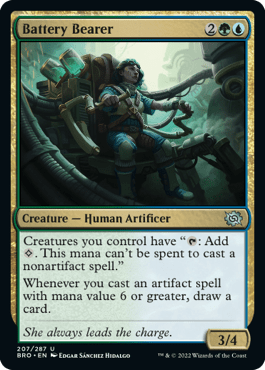
Rating: 7/10
I love the idea of turning all your creatures into Powerstones. It’s also kind of the plot of Guardians of the Galaxy 2. But above all else, drawing a card whenever you cast a huge mech is great.
You’ll play Battery Bearer on turn 4 and have about seven or eight mana to play with on the next turn on a typical board. From there you could cast a Boulderbranch Golem, draw a card, and gain six life.
I love what this card can offer ramp decks and I know I’ll be drafting a lot of them.
Deathbloom Ritualist
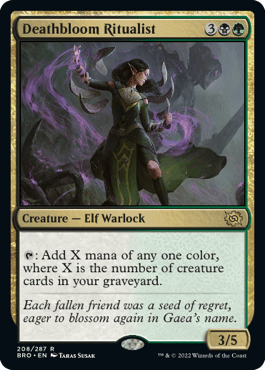
Rating: 4/10
5-drop mana dorks aren’t exactly the best things to be doing on five mana, especially if they require some setup to actually work. Deathbloom Ritualist could potentially be adding two, three, or even more mana in the right deck, and at that point it’s doing a good job of accelerating out giant creatures so it seems like it could be worth it.
Evangel of Synthesis

Rating: 6/10
Dimir’s () theme is clearly this “draw two cards” archetype that we’ve seen before. Giving us a card like Evangel of Synthesis that’s both a payoff for the strategy and an enabler for it is excellent, especially one that can come down and start applying pressure on turn 2.
Fallaji Vanguard
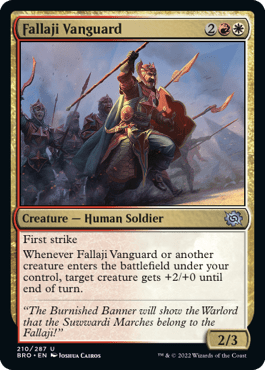
Rating: 7/10
While a 2/3 first strike for four is a little on the small side, Fallaji Vanguard can buff itself with its ability as well as something when it enters, which makes this a decent card all round.
Boros () is all about soldiers and we’ve seen a lot of powerful soldier cards so far. The token generators will work really nicely with this, both by helping to trigger it and by providing good bodies to put the +2/+0 buffs onto.
Hajar, Loyal Bodyguard
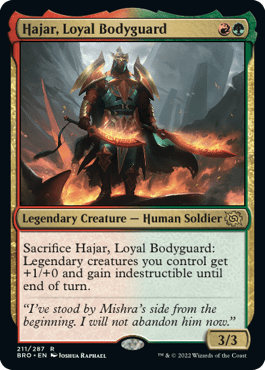
Rating: 4/10
The set does have quite a few legendary creatures in it, but enough that Hajar, Loyal Bodyguard’s ability makes me excited. It will come up from time to time, but this rating is mostly based on it being a well-statted vanilla creature with a very minor upside.
Harbin, Vanguard Aviator
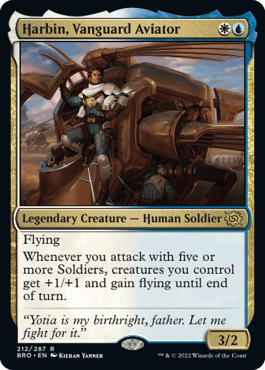
Rating: 8/10
I’ve already mentioned a couple times how good some of the soldier rares are. And Harbin, Vanguard Aviator looks absurd. A 3/2 flier for two is excellent no matter what else it does, but the ability to give +1/+1 and flying to your whole board is just ridiculous.
Attacking with five soldiers is quite the hoop to jump through to make this happen, but we’ve already seen a lot of token generation. Harbin counts itself in that number, so it doesn’t exactly seem impossible to make happen.
Hero of the Dunes
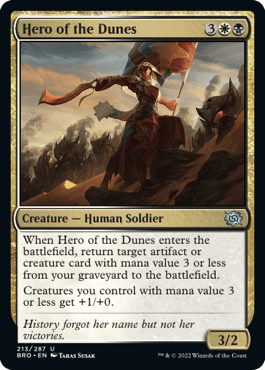
Rating: 7/10
Yet another excellent soldier enabler. Even though Hero of the Dunes is in black, the static +1/+0 buff is excellent with all the 1/1 Soldier tokens lying about. The reanimation ability is also awesome.
This can bring back artifacts as well as creatures unlike a lot of the sacrifice cards we’ve seen, so even bringing back something as innocuous as a Chromatic Star will be well worth it. It should be easy to set up a good creature with an early trade or two.
In short, this should usually be a very solid two-for-one with a lot of relevance for multiple decks.
Junkyard Genius
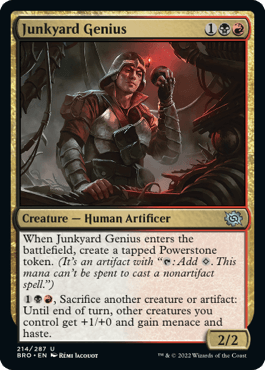
Rating: 6/10
While I’ve never been a fan of the sacrifice payoff costing a load of mana to activate, giving your team +1/+0 and menace is a big enough swing that it’s probably worth the mana investment. And Junkyard Genius comes in and makes a Powerstone, which is just good to see on a 3-drop anyway.
Legions to Ashes
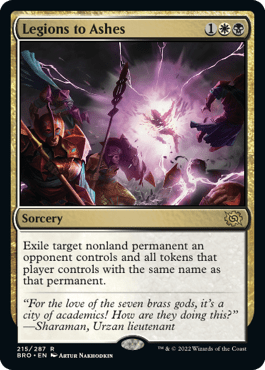
Rating: 8/10
A 3-mana sorcery that exiles a nonland permanent is already excellent. Add in Legions to Ashes’ ability to deal with all of a player’s Soldier tokens? Yes, I’m in.
Mishra, Claimed by Gix

Rating: 9/10
Mishra’s mythic form is essentially a souped-up version of Sanctum Seeker. That was a really powerful rare in its day (got me to a GP Day 2 in Liverpool, thank you very much), and Mishra, Claimed by Gix is much better.
The key is that you don’t even need to attack with Mishra itself, you can just play it and it’ll trigger off of everything else attacking. They also lose their life immediately, so sometimes you won’t even need your creatures to connect to kill your opponent. It’s just such a big life swing that it should win you a lot of races without even attacking.
Mishra, Tamer of Mak Fawa
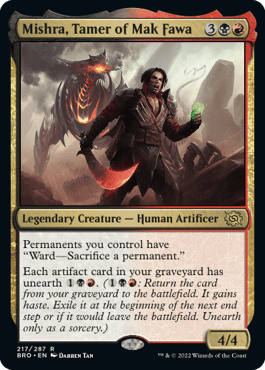
Rating: 8/10
Have you ever seen a line of text as silly as Mishra, Tamer of Mak Fawa’s first ability? I love it. But it’s easier to get around than you might think.
For a start, you can just kill Mishra before going after anything else, and sacrificing a land or a Powerstone usually isn’t going to set you back by much. That said, Mishra is only a 4/4 and you’d probably rather point your removal at something quite a bit stronger. And with that also being said, the longer you leave Mishra alive the more dead you’re likely to be since it’ll eventually get to unearth a ton of artifacts and overwhelm you.
I think some stuff still has to go right for Mishra to work to his full potential, but there’s a lot to like and it’s a very powerful card.
Queen Kayla bin-Kroog
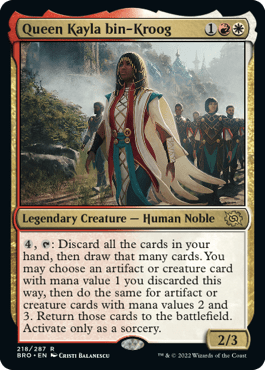
Rating: 4/10
I really don’t know what to make of Queen Kayla bin-Kroog. This effect is very weird, but it basically means that you can play a 1-drop, a 2-drop, and a 3-drop from your hand for four mana, and then draw cards to replace them. Except that you have to discard your hand in doing so.
This requires a ton of set up and will sometimes be fairly unusable, but the playoff is pretty big. It could end up being very powerful, but I’d like to see it happen. Until then it seems fairly average.
Saheeli, Filigree Master
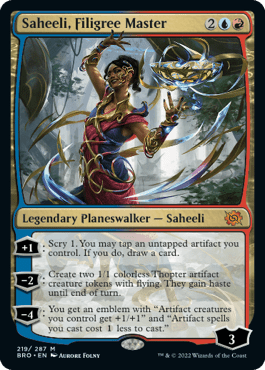
Rating: 10/10
Saheeli cards have always been a little experimental, but Saheeli, Filigree Master is right back to the basics of what makes planeswalkers good. It pluses to draw a card (I’ll assume you can spare an artifact to tap down for it) and minuses to make blockers. What’s not to like?
Filigree Master’s -2 even makes a pair of blockers. If they had printed a 4-mana sorcery that made a pair of Thopters with haste you’d be happy to play that, so a planeswalker that does the same thing and then sticks around drawing cards is absolutely fantastic.
Sanrith Greatwurm
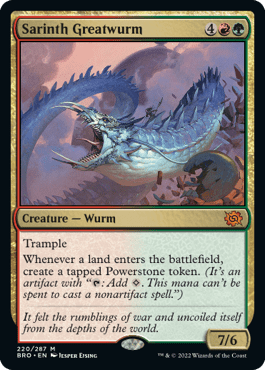
Rating: 7/10
Sanrith Greatwurm feels like a fairly lousy mythic, but an important note is that it triggers whenever any land enters the battlefield. Including for your opponent. You can play this, get a Powerstone when your opponent plays a land for their turn and then have extra mana to play with on your turn.
It’s pretty nice and it has its stats in all the right places, but I had higher hopes for a Gruul () mythic rare.
Skyfisher Spider
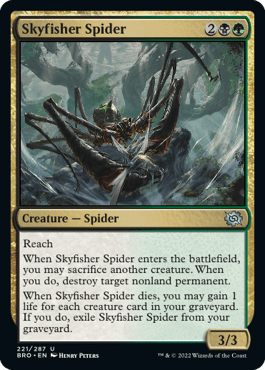
Rating: 7/10
Be thankful that Skyfisher Spider has the word “another” in its text. Otherwise it would be able to work as a Mortality Spear that gained you some life.
As it stands it’s still excellent. Not quite on the level of Ravenous Chupacabra, but really damn close. You’ll not only be happy to trade your worst creature for their best permanent, but it should be easy enough to recur, flicker, or whatever else you can find to synergize with it since this is a creature.
Tawnos, the Toymaker
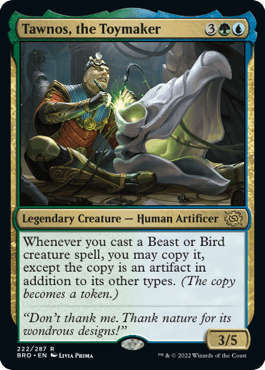
Rating: 1/10
There are five beasts in this whole set, two of which aren’t even blue or green, and one bird. That makes me wonder what on earth Tawnos, the Toymaker is even here for. I guess it’s a Commander-only card, but there are surely better products for that?
Either way this isn’t a card for Limited. It barely scrapes a point because maybe you do have some of those creature types, but it’s not likely to come together.
Third Path Iconoclast
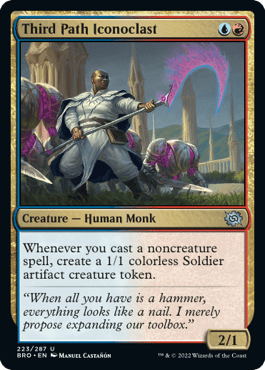
Rating: 7/10
I’ve already seen someone refer to Third Path Iconoclast as the new Young Pyromancer, and they’re really not far off. Being a gold card is a downside, but triggering off of any noncreature spell is a massive upside.
You can likely build a good deck around instants, sorceries, and sweet artifacts like Ichor Wellspring, and this is one of the big payoffs you can expect for that.
Tocasia, Dig Site Mentor
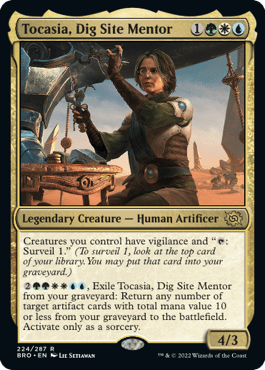
Rating: 6/10
Being a 3-color card in what appears to be a 1- or 2-color format is likely a big downside for Tocasia, Dig Site Mentor. You won’t be disappointed if you can make it happen.
Giving all your creatures the ability to tap to surveil should dig you to the best cards in your deck really quickly. Once you get to the late game its second ability is extremely hard to pull off, but it’s a free bonus from the graveyard so hardly anything to be upset about.
Ultimately I think Tocasia’s color requirements will get in the way of it being playable.
Urza, Lord Protector

Rating: 5/10
Sadly the mythic Urza, Lord Protector is nothing without The Mightstone and Weakstone. Just a 2/4 that makes some of your spells cost one less. That’s fine, but there are a lot of nonrare cards better than him.
Of course you should probably slam Urza and try to make the meld work if you’ve been lucky enough to get The Mightstone and Weakstone.
Urza, Prince of Kroog
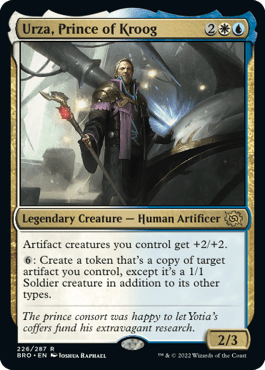
Rating: 7/10
+2/+2. To all of your artifact creatures. Including your 1/1 Soldier tokens. That’s a really nutty ability and one that I guarantee you’ll want to make happen.
Urza, Prince of Kroog is also in the right color combination for the soldiers deck, so that seems to be the best thing to do with it. This grade should potentially be higher, but the fact remains that it does literally nothing in vacuum with no other cards around it. It’s hard to tell how likely that is, but it’s too likely for me to want to rate this Urza higher.
Yotian Dissident
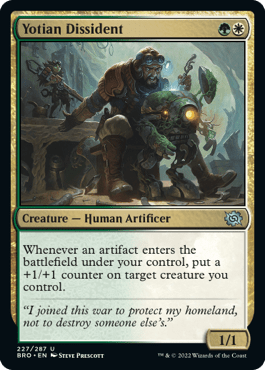
Rating: 7/10
We’re not so far away from Neon Dynasty to have forgotten about the power of Generous Visitor, a card that’s even seen Constructed play. Yotian Dissident is certainly harder to cast but it triggers off all sorts of artifact tokens, including both the Soldiers and Powerstones that you’ll be making.
As someone who recently got stomped in a Pioneer tournament by Showdown of the Skalds, I can confirm just how ridiculous it is to have effects like this that are capable of spreading around tons of counters. Even just a couple triggers will make playing this card worth it, and the high roll potential of hitting this on turn 2 is incredibly scary.
Yotian Tactician
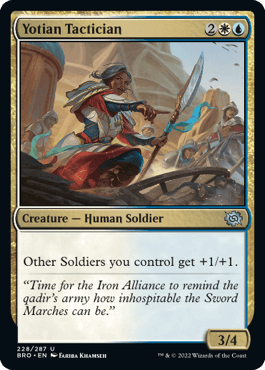
Rating: 7/10
Yotian Tactician is a bit on the expensive side for a tribal lord, but I’ll definitely take it. This just means you can spend your earlier turns on making soldiers that want to attack, drop this later, and get a good attack in.
Bladecoil Serpent
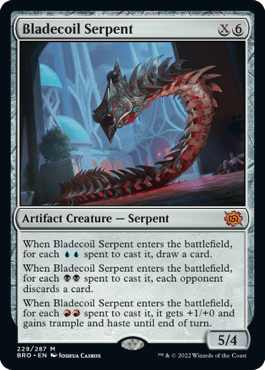
Rating: 10/10
The story of the next two mythics is that they’re full of flexibility. Let’s say you have Bladecoil Serpent in a Dimir deck.
You might have enough mana to make it draw two and make your opponent discard one, or maybe draw one and your opponent discards two. You might be a little stuck on mana and can only do one of each. You might even have so much mana that you can pick and choose which modes you use. You could even be mono-red and cast this as an 8/4 with haste and trample.
No matter what combination you end up using, the card is great. You still have a decent card even with the bare minimum of drawing just one card. That flexibility is huge and I’d be happy picking this up if I was in any one of these colors.
Clay Champion
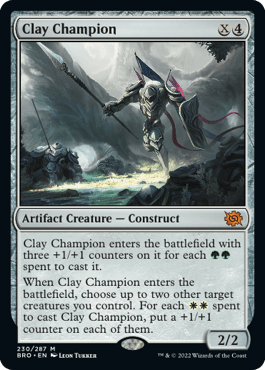
Rating: 9/10
Clay Champion is a weird mythic, but one that’s extremely flexible. If we ignore X for a moment, there are so many combinations of how you can cast this that make it worth playing.
Quad green gives you a four mana 8/8. Quad white gives you a 2/2 and four +1/+1 counters distributed across your creatures. If you only have a couple green mana and can’t satisfy anything else it’s still a 4-mana 5/5. The list goes on.
This flexibility is what makes the card tick for me. None of these modes are especially groundbreaking, but I’d be happy with this in any deck that was white or green, and in pure Selesnya () it goes crazy.
Colorless
Aeronaut’s Wings
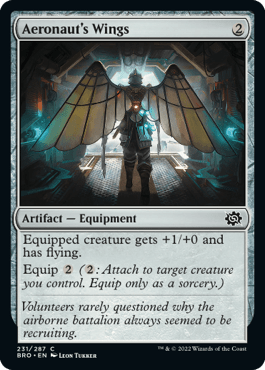
Rating: 2/10
An equipment that grants flying can be very hit or miss. The ones that have been playable have been cheaper to cast or equip. Cliffhaven Kitesail cost less and gave us the first equip for free but was only just good enough to see play.
I think Aeronaut's Wings is probably bad, but it can still do the thing and send big creatures into the air.
Argivian Avenger
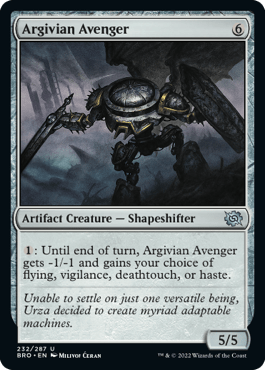
Rating: 3/10
A nice callback to Urza's Avenger, though paying mana for the ability is a bit rough. Argivian Avenger has the ability to tradeoff for anything, attack as a 4/4 or 3/3 flier if you also want it to block.
I’m not sure what deck would actively want this, but being colorless at least means that any deck can have it if they want it.
Cityscape Leveler
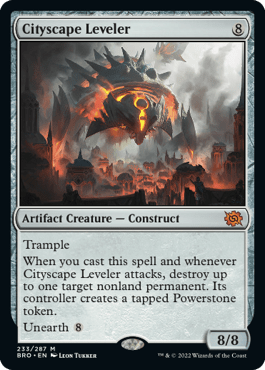
Rating: 10/10
Hoo boy! Leveler is back, baby, and it’s been hearing all of the nasty things we’ve said about it over the years, mocking it for being a terrible bulk rare.
Assuming you can actually cast an 8-mana artifact Cityscape Leveler really does the business. Destroying any creature or annoying permanent you want and then getting to keep doing it every combat if it’s left alive? Oh, and it has unearth so you really can’t rely on killing it.
If that wasn’t enough it also has trample, so you won’t be chump blocking it any time soon. This is just insane and likely a nice replacement for Meteor Golem in Pioneer.
Energy Refractor
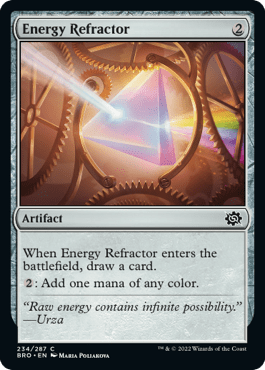
Rating: 4/10
I really like cheap artifacts that cantrip. They’re great for flickering, great for sacrificing, and so on. The mana filtering isn’t great, Energy Refractor is certainly no Prophetic Prism, but there are worse ways to enable splash colors.
Goblin Firebomb
CARD
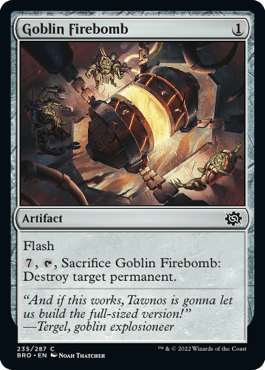
Rating: 1/10
While Goblin Firebomb can be playable in some fringe scenarios, just because you have a bunch of Powerstones lying around doesn’t mean you’re in the market for an 8-mana Vindicate.
Levitating Statue
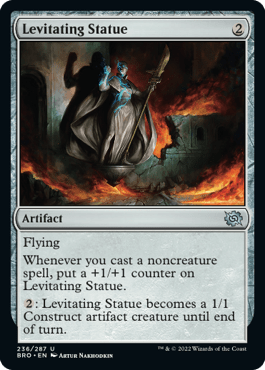
Rating: 4/10
It might be easy to remember how bad Stuffed Bear was and think Levitating Statue is terrible. I don’t think it’s amazing, but I’d say it’s closer to something like Riddleform.
Growing bigger just for casting spells you wanted to cast anyway is decent, and having flying makes a huge difference. I’d just be wary of drawing it too late because it really needs to happen early to reach its full potential.
Liberator, Urza’s Battlethopter
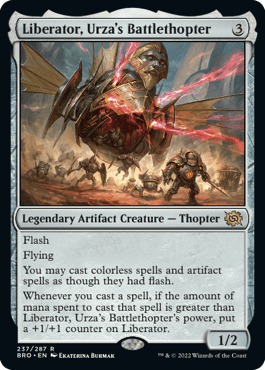
Rating: 7/10
I‘m just saying, Shimmer Myr was never able to give Emrakul, the Aeons Torn flash.
Liberator, Urza's Battlethopter looks quite painful to play against. Being able to quickly grow in size just from you casting spells should turn it into a 3/4 or 4/5 flier in no time at all. And being able to flash in blockers is really scary, especially since doing so will also make Liberator bigger at instant speed.
The Mightstone and Weakstone
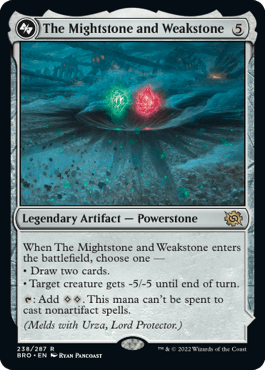
Rating: 10/10
The Mightstone and Weakstone is absolutely absurd. A colorless artifact that either kills a creature or draws two cards and then acts as two Powerstones in play? It’s unbelievably good. It’s flexible above all else and has no real downsides to being played.
While this might play out quite like other 10s, it’s important to point out that this card is so versatile that you should always take it. It’s colorless. Every single deck in the format can play it and it’s better than all of the commons or uncommons.
The only time you should be passing this is if you open up a Wurmcoil Engine in the same pack.
Mine Worker
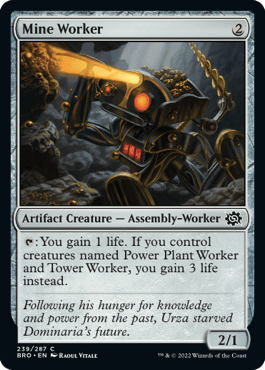
Rating: 4/10
Mine Worker is the first of a really cool trio of cards that call back to the Urzatron lands. They’d be interesting reprints but likely too powerful for Standard or Pioneer.
These three creatures mimic their effect by having abilities that are boosted if you control all three of them. The key to these cards is just asking whether or not they’re good enough on their own.
In the case of the first one, Mine Worker looks perfectly fine on its own. Bronze Sable is a little too weak, but gaining one life per turn is a nice upside and three life per turn is just great when you get the Tron together.
Portal to Phyrexia

Rating: 8/10
Now this is an absolutely absurd bomb to ramp into. Short of your opponent having a small army with plenty of spare creatures to throw away, playing Portal to Phyrexia will completely dominate the board and then win you the game by providing you with a steady stream of free reanimated creatures. What’s not to love?
Well, honestly, the mana cost. While you can turbo it out with Powerstones, it takes a lot of effort to make this work and it can’t go in every deck. But I’m confident that you will get paid off for it if you put the work.
Power Plant Worker
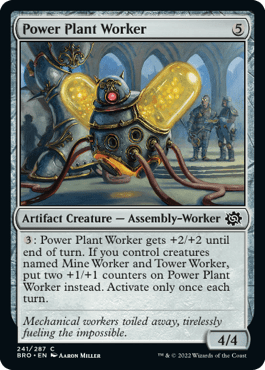
Rating: 3/10
Power Plant Worker is the worst of the Tron trio but also the biggest payoff for getting all three of them out. I doubt you’ll want to play this one in a deck that doesn’t have the other two, but it’s still a defensible card when you don’t draw them.
Reconstructed Thopter
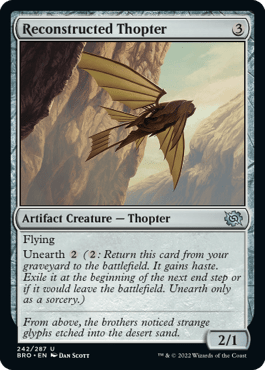
Rating: 4/10
You could do a lot worse than a 2/1 flier for three that every deck has access to, and Reconstructed Thopter’s unearth ability is nice to get some chip damage in.
Slagstone Refinery
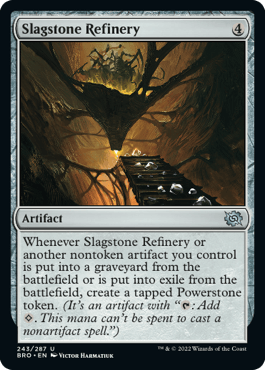
Rating: 1/10
Slagstone Refinery technically has text, but I’m reading the part where it’s a 4-mana artifact that doesn’t do anything until you do another thing. That’s not a great recipe for success.
If this was a little cheaper then I could see it being useful, but as it stands it’s just too expensive and does so little for what you’ve spent on it.
Spectrum Sentinel
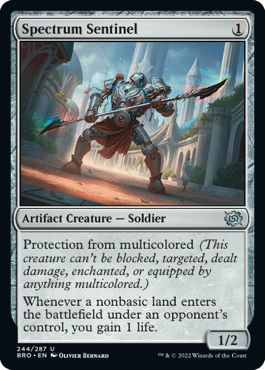
Rating: 1/10
While there are a handful of multicolored cards to protect against, that’s just not what this set is about. There won’t be very many nonbasic lands either so you won’t be gaining any life off it.
This rating is entirely based on the fact that Spectrum Sentinel is a soldier so maybe you want it in some fringe scenarios, but that’s literally it. Don’t play it otherwise.
The Stasis Coffin
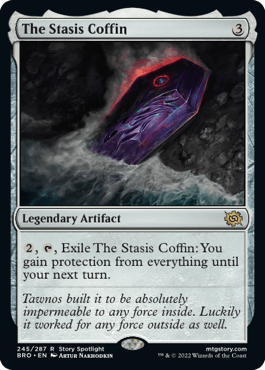
Rating: 0/10
Just, no. I’m not willing to spend a whole card on The Stasis Coffin to fog my opponent or counter a spell that targets me, especially when my opponent will see it coming.
Steel Exemplar
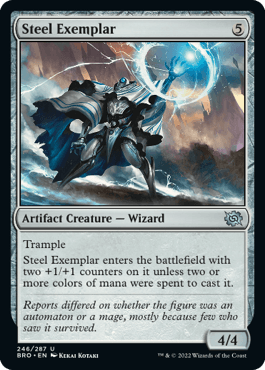
Rating: 6/10
The gimmick here is that Steel Exemplar is a 6/6 trample if you cast it with all or mostly Powerstones. That’s an extremely good rate and one that’s worth playing if you can get it to work.
I don’t think I’d be happy playing it unless my deck was either based on Powerstones or mono-color, but at least a 4/4 trample isn’t too bad if you end up short on playables.
The Stone Brain

Rating: 0/10
Once again, no. Cranial Extraction and its various spinoffs have never been even remotely playable in Limited. You spend a whole card with The Stone Brain and your mana to exile all copies (presumably just one) of a card from your opponent’s deck when they might not have even drawn it in the first place? Hard pass.
Stone Retrieval Unit

Rating: 3/10
We have better ways to make Powerstones in each color, but Stone Retrieval Unit is a fallback for each of those decks that want it.
We’ve seen these kinds of artifact creatures before, like Blood Servitor, that just do a set’s mechanic less efficiently than colored cards can. The difference here is that there are enough color combinations that would like Powerstones that some of them may fall short, and all of them have access to this one.
Su-Chi, Cave Guard
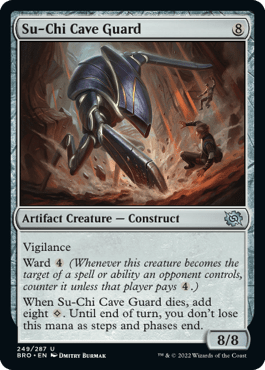
Rating: 7/10
Be warned, this rating is based entirely on the assumption that 8-mana creatures are castable. It seems that Su-Chi was considerably bigger before the ravages of time. Everything about Su-Chi, Cave Guard is ridiculous.
8/8 vigilance and ward 4 makes this an incredibly tough card to play against. Even if you do find a way to kill it your opponent gets enough mana to cast a new creature to take its place.
Supply Drop
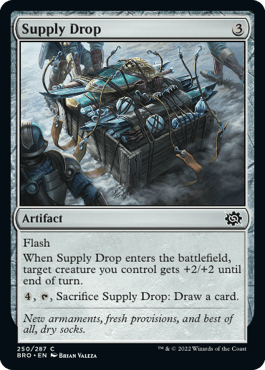
Rating: 3/10
Supply Drop is a really interesting card. I’ve said before that I like combat tricks that leave behind something after they’ve happened, and this leaving behind something you can sac later seems worth it.
It’s a bit expensive and I think you can do better with the colored combat tricks in each color, but this is at least an option that every color has access to.
Swiftgear Drake

Rating: 2/10
Five mana is just far too much mana to be paying for a card like Swiftgear Drake. It’s a useful creature in a pinch, but you can do a lot better for a lot less mana.
Symmetry Matrix

Rating: 1/10
I want Symmetry Matrix to be good. After all, it does say draw a card on it. And you can trigger it multiple times. But you can’t guarantee it triggering and you have to cast it for four mana despite it not doing anything upfront.
Like I say, my heart wants it to be good, but my head says it won’t be.
Thran Power Suit
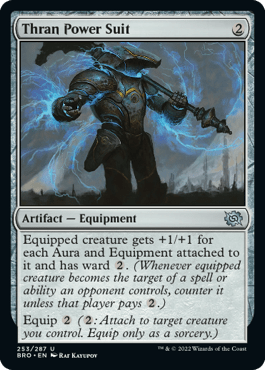
Rating: 3/10
Thran Power Suit grants +1/+1 and ward as a base rate, which isn’t too bad. You ideally need another equipment or aura before this gives a really good bonus, but that’s not too hard to accomplish.
In the meantime this is at least cheap enough to cast and reequip that it should be fine.
Thran Spider
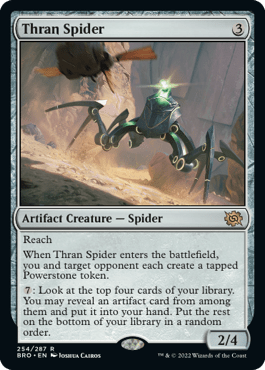
Rating: 7/10
Giving your opponent a Powerstone is a sizable downside, but everything you get in exchange seems worth it. Not only your own Powerstone, but also a 3-mana Giant Spider and a late game mana sink that draws cards?
There’s also a chance that your opponent won’t even be able to use the Powerstone you give them, so I think Thran Spider balances out.
Tower Worker
CARD
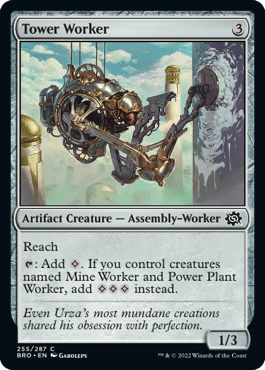
Rating: 5/10
I called it! As these were being spoiled I said “I bet the tower card gives you mana and triples it when you have all three,” and here it is.
A colorless mana dork for three mana is certainly a card that some decks are going to want, and Tower Worker also helps give you the mana to get the other Tron pieces out. I’m going to have a lot of fun trying to put this trio together, and nobody can stop me.
Lands
Argoth, Sanctum of Nature
Rating: 6/10

A land that creates creature tokens is always worth a second look. Four mana for a 2/2 Bear token is a really good rate, even if milling three cards makes it something you can only do so many times.
But Argoth, Sanctum of Nature is also a great enabler if you are playing the self-mill deck. Entering tapped most of the time isn’t much of a downside, so I’d always try to pick this up if you’re a green deck. Especially if you have some picks left in the Draft in which you might see a Titania.
The Pain Lands


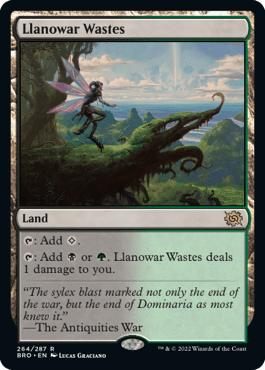
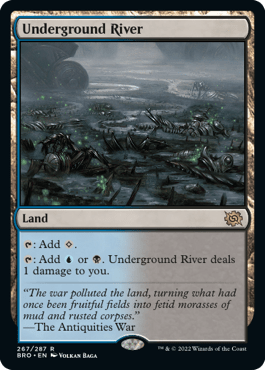
Rating: 4/10
Like all dual lands in Limited, these are fine if you happen to be in the right color combination. But they’re by no means necessary. Pick them up if you see them, but you shouldn’t need to take them over good playables.
Blast Zone
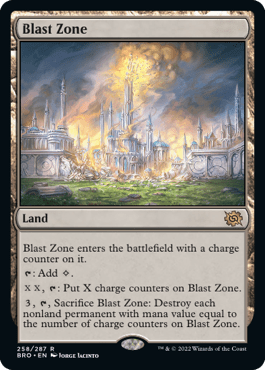
Rating: 6/10
While putting a colorless land in your deck comes with a significant cost, one that’s capable of destroying problematic permanents should end up being worth the cost. Blast Zone is a little mana intensive, but ultimately it only costs you a land so it ends up being a good trade off.
Demolition Field
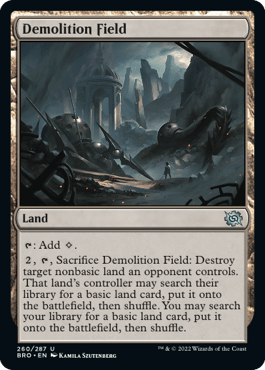
Rating: 1/10
Simply put, the majority of decks won’t even have any nonbasic lands in them, so Demolition Field is never worth running. It might be a fine sideboard card if your opponent has a Mishra's Foundry, but you should ignore it. other than that
Evolving Wilds
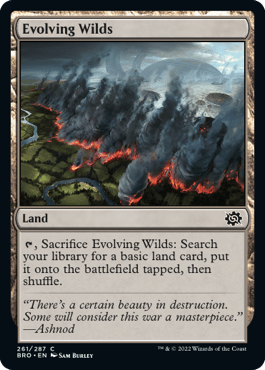
Rating: 4/10
We’ve all seen Evolving Wilds at this point. It’s a very solid card. Unless I was a very aggressive deck I’d never think of cutting any copies from my deck, but I also don’t want to prioritize them over good spells during a Draft.
Fortified Beachhead

Rating: 5/10
It’s really cool to see a new tribal dual land here, and Fortified Beachhead actually isn’t bad. On one hand you don’t care too much about picking up dual lands, but this is one that can potentially enter untapped and gives you a late game overrun pretty much for free.
I wouldn’t prioritize it over much, but this is perfect if you’re a soldier deck of any kind.
Hall of Tagsin
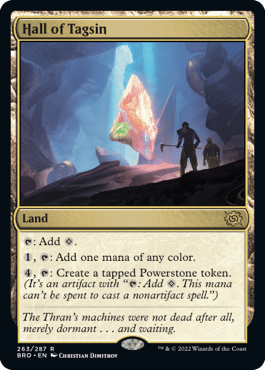
Rating: 3/10
I think four mana to create a Powerstone (five when you count tapping the land itself) is a little bit too expensive, and only a few decks would be happy playing Shimmering Grotto. Hall of Tagsin just isn’t good enough to prioritize overall.
Mishra’s Foundry
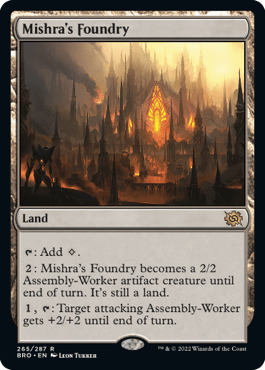
Rating: 7/10
Creature lands as good as Mishra's Foundry are few and far between. Attacking as a 2/2 is okay, but I actually like the third ability the most.
There are a handful of really good assembly-worker creatures in this set, and just having this among your lands makes it incredibly hard for your opponent to block any of them.
Tocasia’s Dig Site
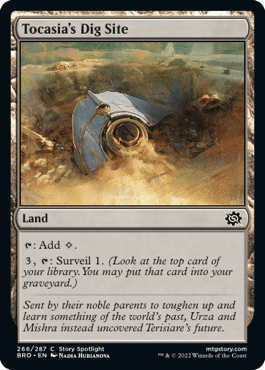
Rating: 5/10
As I’ve said, colorless lands have a significant cost associated with them. But as we saw with the campus duals from Strixhaven, repeatable sources of scry (or in this case surveil) are incredibly useful for the late game. And Tocasia's Dig Site doesn’t even enter tapped.
I quite like it, but it’s worth remembering that not every deck will be able to afford a colorless land.
Retro Artifacts
Adaptive Automaton

Rating: 6/10
There’s really only one very relevant creature type in this set and that’s soldier. But since it’s an archetype that wants to go wide and make lots of tokens, even a basic lord like Adaptive Automaton should be very powerful for that deck.
Outside of that you could always slot it into your average deck. And you probably get some situations where naming phyrexian, construct, or golem will work out well for you, but you really want to go for soldiers.
Aetherflux Reservoir
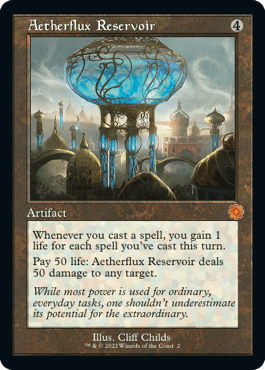
Rating: 0/10
For Aetherflux Reservoir to do its thing you need to be casting a lot of spells in one turn, which isn’t something your average Limited deck is able to do. Even good ones won’t be able to do it outside of Cube.
So just leave this in Constructed and don’t bother.
Altar of Dementia
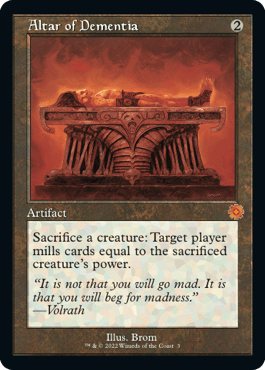
Rating: 9/10
This rating might look a bit weird to some players, especially since Altar of Dementia is a mill card, but from my experiences playing with this card in older draft formats the mill accumulates very quickly. Not to mention that this is a colorless card that can slot in any deck.
You can sac anything in response to removal, chump black attackers and then sac them, plus there’s a sub theme of sacrificing creatures in the set. You can also do this to mill yourself if you have a deck for it. You can sac unearthed creatures since they’re going to die anyway.
There are so many applications for this card and I think it’ll surprise you.
Ashnod's Altar
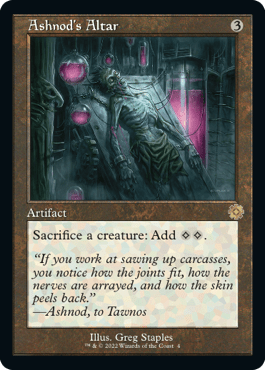
Rating: 7/10
Commander players will likely be very well aware of how powerful Ashnod's Altar can be. While I don’t think this is a good Limited card it has some good applications in this set.
There’s a sacrifice theme for which this is a repeatable sac outlet. Plus there are a bunch of very expensive spells that you might want to be casting. This might be just what you need to bring a deck together with enough tokens and the like to be sacrificed.
Astral Cornucopia
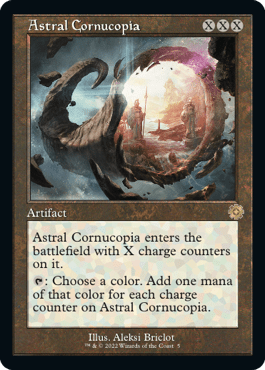
Rating: 2/10
Even though you can power Astral Cornucopia out with Powerstones, you’re probably not interested in casting it. Mana rocks need to be more efficient than this to be useful in Limited or at the very least do something else, so I don’t think you want this.
Blackblade Reforged
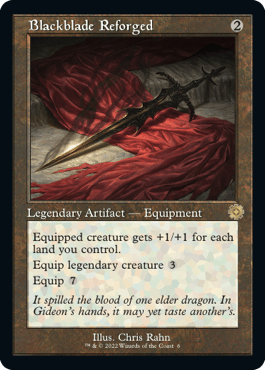
Rating: 7/10
Equip 7 is such a huge amount that it’s usually not something you want to do. But the payoff is massive, giving around +7/+7 at that point in the game, which turns literally any creature into an enormous threat. You can also use Powerstones to equip Blackblade Reforged for a little cheaper, and you’re just laughing if you ever have a legendary creature to equip up.
This was a pretty broken card when it was first printed in Dominaria, but that set was packed full of random legends so it played out a lot better than I imagine it will here. It should still be busted though.
Bone Saw
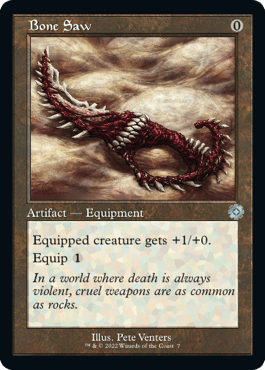
Rating: 1/10
Costing zero mana can often be quite deceptive. On one hand it’s free so there’s no downside, right? Except the downside is that Bone Saw is a whole card and you’re not getting enough value for that card.
There’s a fringe possibility that there’s a deck that this can synergize with, but odds are this should just stay in your sideboard.
Burnished Hart
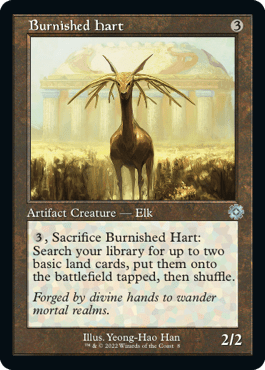
Rating: 5/10
We’ve seen Burnished Hart a few times before and it really benefits from formats that are slow and grindy. If the format isn’t hostile to it, it’s excellent colorless mana fixing for any deck and also lets you chump block on the way out. If the format turns out to be very aggressive, then its value will go down.
But for now I’m happy calling this a very solid playable for just about any deck that’s looking to go into the late game.
Caged Sun
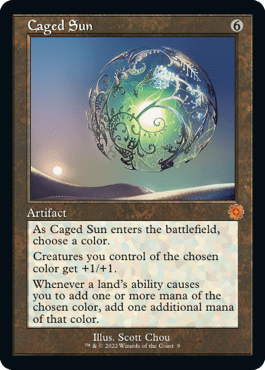
Rating: 0/10
Not only is Caged Sun only really effective in mono-color strategies, it’s also something you don’t want in Limited. Six mana is far too much mana to only be giving +1/+1 to some of your creatures, and doubling the mana of some of your lands isn’t something you’re interested in doing.
There are some very expensive creatures in this set but you have far easier ways to cast them than needing to play this first.
Chromatic Lantern
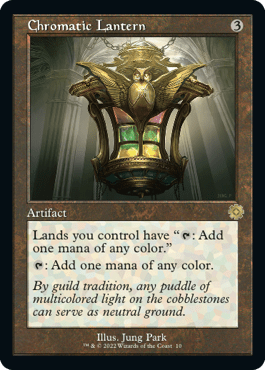
Rating: 2/10
A cursory glance tells me you probably won’t be drafting 5-color decks in this format, so the value of a card like Chromatic Lantern is seriously diminished. This is basically just a mana rock with some minor upside, and that’s probably not good enough for you to play.
Chromatic Star

Rating: 5/10
There’s absolutely nothing bad about Chromatic Star. Any deck can run it just to cantrip and maybe help a splash color. But this is really going to shine in decks that actively want to sacrifice artifacts since it’s a perfect thing to put out and sacrifice for value.
That deck is always going to be looking for cards like this.
Cloud Key
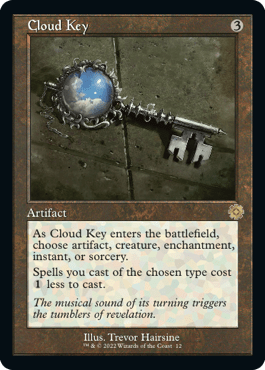
Rating: 1/10
It just isn’t worth it to play an artifact that doesn’t affect the board in any way and only makes some cards cost less in Limited. While I can see Cloud Key working in some very specific scenarios, it just isn’t going to be worth it most of the time.
Defense Grid

Rating: 0/10
Defense Grid has been an all-star sideboard card in eternal formats over time, allowing combo decks to do their thing against control decks. Except that this is Limited, so you don’t have combo decks.
Making instants cost three more on your turn is nowhere near good enough to spend a whole card and not affect the board.
Door to Nothingness
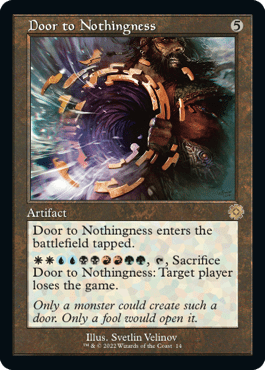
Rating: 0/10
I saw someone win a game with Door to Nothingness back when it was last printed in Core Set 2013. Once. It isn’t that likely to happen.
It’s a hilarious gimmick and I know I’ll try it at least once if I enjoy this format enough to play it over and over again. But this is quite obviously unplayable for the most part.
Elsewhere Flask
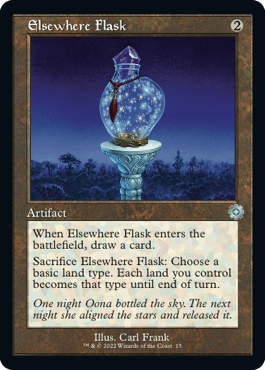
Rating: 4/10
This classic all-star of Modern eggs, courtesy of Stanislav Cifka at Pro Tour Return to Ravnica, is pretty ineffectual. But it does draw a card. And it’s very easy to play Elsewhere Flash, draw your card, and then sac it off for value since it’s quite cheap, which funnily enough is exactly what it was used for in Modern.
Foundry Inspector
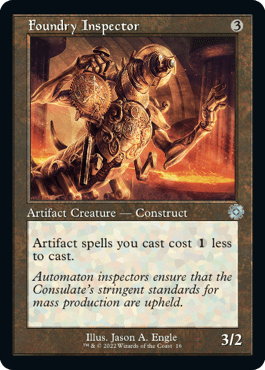
Rating: 5/10
I said with Cloud Key that playing a card that doesn’t affect the board and only makes some of your cards cost one less is just bad. Except that Foundry Inspector does affect the board, making it a very reasonable card all round.
It performed really well when we last saw it in Kaladesh and I expect it to do some good work in this set too.
Gilded Lotus

Rating: 5/10
Mana rocks have gotten worse over the years, but Gilded Lotus is a classic that we’ve seen time and time again and it always performs fairly well. This is a great way to accelerate up to huge mechs and is even castable via Powerstones, as well as fixing any color you might have on the splash.
Goblin Charbelcher
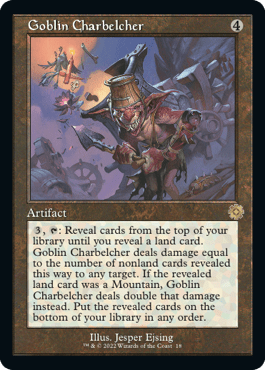
Rating: 8/10
It looks like we’ve found an artifact that might affect the board. Emphasis on the word might. The big downside with Goblin Charbelcher is that you have to declare a target for it when you activate it, and you don’t know how much damage it’s dealing until it resolves. But you can keep doing this over and over again since the cards you reveal all go to the bottom and you’ll eventually whittle down your opponent’s resources given the time.
If you’re a red deck you have even more of a chance to hit the numbers you want since hitting a Mountain will double your damage. Better yet, you can start going to the face and winning the game outright once the board is clear.
This is pretty expensive to do each turn so it might be too slow against aggressive decks, but this will dominate a board and win the game if left unchecked.
Helm of the Host
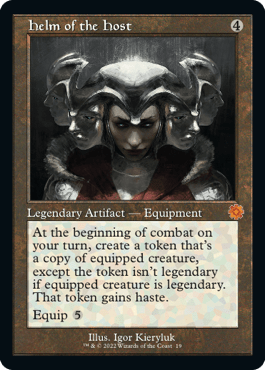
Rating: 8/10
Helm of the Host is one of the more expensive equipment cards you have, and boy do you get paid off for it. Getting a free creature every turn once you have this equipped is pretty nutty.
In a game of Limited, sure, slapping this on a huge creature is great, but it’ll be even better if you can find a great enters the battlefield trigger to keep repeating. But to be honest it matters very little what you’re actually copying since basically anything is good enough value turn after turn to justify the cost of this.
Howling Mine
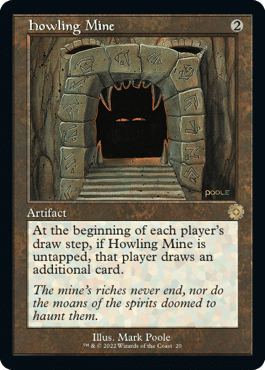
Rating: 1/10
While it’s very tempting to want to draw an extra card every turn, letting your opponent do it, and above all getting to do it first, is far too much of a downside to be interested in this Alpha classic.
Ichor Wellspring

Rating: 5/10
This is now the third artifact on this list that’s great for sacrificing, and I can see any one of them being a good addition to a deck that wants to be doing that. Of all of them Ichor Wellspring is the one I want the most, and you can’t stop me from drafting as many of them as I can find.
Inspiring Statuary
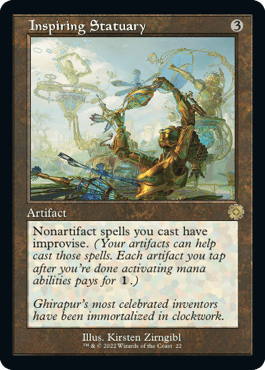
Rating: 0/10
Inspiring Statuary was hot garbage when it was first printed and I don’t see that changing now. Especially when the most expensive cards in the set are going to be artifacts.
Ivory Tower
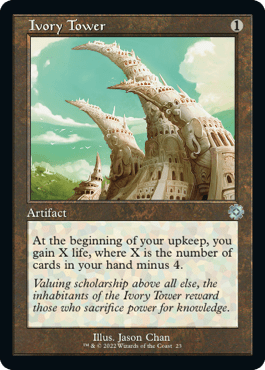
Rating: 0/10
If I had to guess I’d say that your average hand size in the majority of Limited games you play will be four or less. So an artifact that usually gains you no life per turn is wildly unplayable.
Believe it or not Ivory Tower was once a ban-able card back in the day. Times have really changed.
Jalum Tome

Rating: 1/10
I don’t think you have enough time to be looting unless the card also adds a creature to the board. On balance, the casting and activation costs are just too high for Jalum Tome to be all that good.
Journeyer's Kite
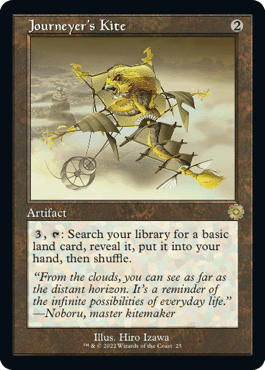
Rating: 2/10
I want to like a card that lets me draw a card every turn, but paying three mana to activate and only getting a basic land is far too much to rely on. If this format ends up being really slow and I have some number of splashes then I can see wanting Journeyer's Kite, but by and large it’s just far too slow.
Keening Stone
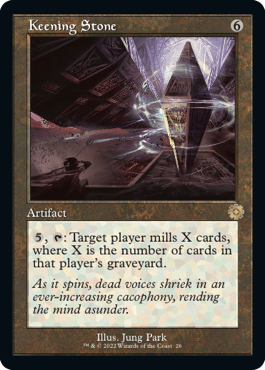
Rating: 8/10
Mill cards are often not great, but a repeatable mill that gets exponentially bigger is really good. Powerstones should do a good job of powering this out like the Eldrazi spawn did back in Rise of the Eldrazi, and it should only take a couple of activations before your opponent is in big trouble.
Win conditions that are hard for an opponent to interact with are often very powerful, and while this is pretty slow it should be more than good enough in the right deck.
Key to the City
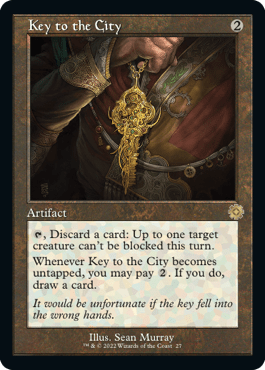
Rating: 7/10
I remember losing to Key to the City quite a few times back in Kaladesh, and I imagine it’ll be similarly good here. Except this time you have massive 10/10 mechs that wouldn’t mind becoming unblockable to break through a board stall.
Even if you don’t need to make anything unblockable, if it’s just looting away excess lands then that’s a fine base rate.
Liquimetal Coating
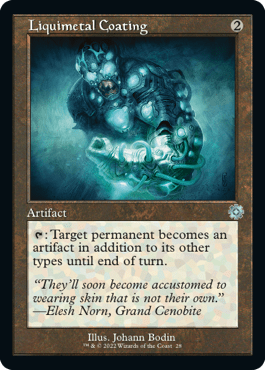
Rating: 1/10
Even in a set with an abundance of artifact removal, Liquimetal Coating likely isn’t good enough to put into your deck just to be able to give your removal more targets. While it’s good as a tutor target in eternal format decks, it just doesn’t have enough application for limited.
Lodestone Golem
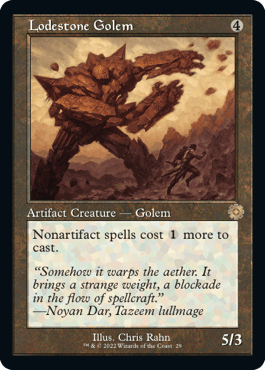
Rating: 5/10
While this vintage restricted card is often going to be little more than a big vanilla creature you’ll have some matchups where Lodestone Golem really hoses your opponent and becomes a massive nuisance. And nuisances that clock you really quickly often turn into cards that need answering, so this ought to be good in your heavy artifact decks.
Mazemind Tome
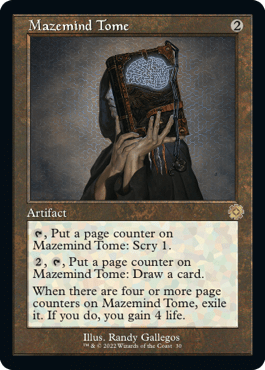
Rating: 7/10
While it costs you a few activations, a 2-mana artifact that eventually draws you three cards and gains you four life is quite a lot of potential. Mazemind Tome was an incredibly powerful card when last we saw it and I imagine I’ll be equally happy to pick this up for most decks.
Mesmeric Orb
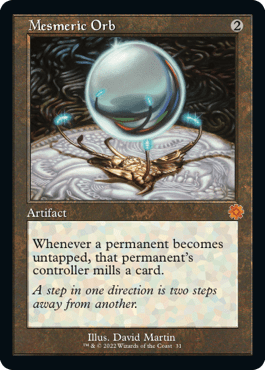
Rating: 6/10
Mesmeric Orb can be a very dangerous card since it mills players out incredibly quickly. At least your opponent will always be the first player to untap and mill some cards, so this is much more under your control at first.
Though it can get away from you, an early Orb can really put the pressure on your opponent and force them into some very awkward situations. You have a very viable win condition combined with some of the other mill effects in this set. You can even make use of it milling you with some of the graveyard-based shenanigans going on in the set.
I love cards like this and I think we’re in for a fun time, assuming you don’t have to play against it.
Millstone
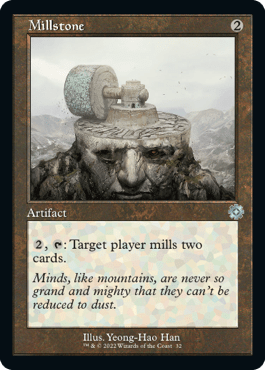
Rating: 4/10
While it doesn’t affect the board like a lot of these other artifacts we’ve seen on this list, Millstone has been a fairly effective control win condition in the past. Assuming the format is slow enough to allow you to use this it can definitely be a good card to close out grindy games. After all, there’s a reason we call this effect mill.
Mind's Eye
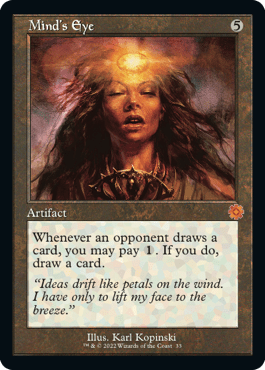
Rating: 4/10
Mind's Eye essentially translates to a 5-mana artifact that lets you pay one to draw an extra card on each of your opponent’s turns. Assuming we have a slow format that should pan out pretty well, even if you have to pay quite a lot upfront to get it into play.
There are definitely decks that can make use of this, and the extra free cards should be able to overwhelm your opponent pretty quickly. You just need the right deck to take advantage of it.
Mishra's Bauble
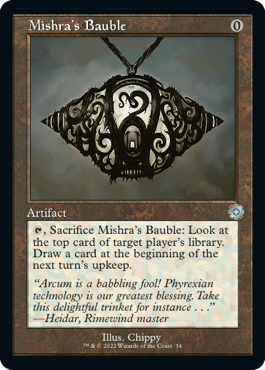
Rating: 6/10
Much like the decks that play Mishra's Bauble in Modern, you can make a lot of use of Mishra's Bauble in decks that care about casting noncreature spells. A free spell that cantrips is an incredibly strong card in the right deck, and it’s never all that bad even in the wrong one.
But having a delay on drawing the card might actually hinder you when you draw it late. Either way, if you can make use of a free cantrip spell then this is it. I can imagine a lot of decks wanting exactly this card.
Mox Amber
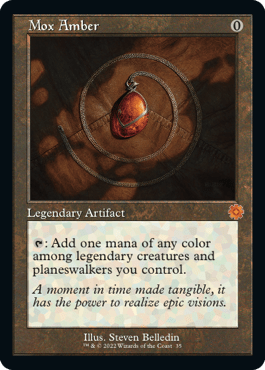
Rating: 0/10
Even if you have several legendary creatures, Mox Amber is just too unlikely to even work for it to be worth playing. But this is likely one of the pricier reprints on this list, so take from that what you will.
Mystic Forge
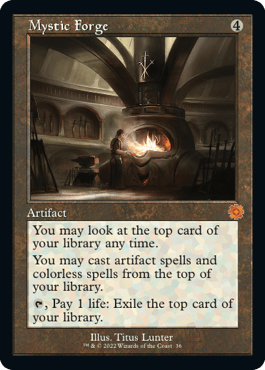
Rating: 7/10
Given how many artifacts appear to be in this set I can see Mystic Forge just being an incredible powerhouse. It was very lackluster when we last saw it because it came in a Core Set without a lot of many artifacts in it. But it doesn’t seem unthinkable for you to have a deck where the majority of your spells are artifacts, and this can end up drawing you a bunch of extra cards in a very short span of time.
We’ve seen this become a Constructed staple over the last few years, and this seems like the prime Limited environment to test it out.
Ornithopter
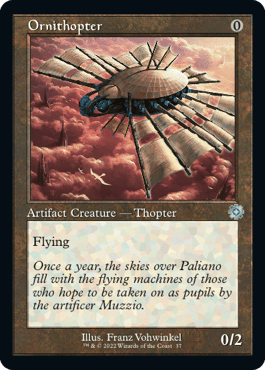
Rating: 1/10
While I’m sure that we’d love for Ornithopter to be good, it sadly isn’t. It’s a 0-mana creature, it has flying, what’s not to love? Well, it also has no power, isn’t very good at blocking, and it costs you a whole card.
While this has seen a considerable amount of play in a wide variety of Constructed decks, it would need an extremely specific Limited environment to work. I’m leaving at least a single point on its rating because I hope that a deck for it does exist, but odds are it won’t.
Perilous Vault
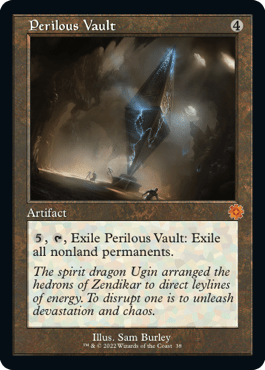
Rating: 6/10
It’s always hard to rate board sweepers, especially ones that cost a total of nine mana likely over two turns. But exiling everything is definitely something to pay attention to and hitting annoying permanents regardless of their types is also going to be something desirable.
You’ll need to accelerate Perilous Vault a little, but it shouldn’t be too difficult to play into this and let your opponent overextend all manner of problematic cards into it.
Phyrexian Processor
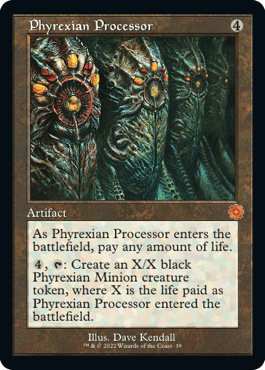
Rating: 5/10
I really have no confidence in this rating since Phyrexian Processor is a classic card that I just have no experience playing with. I know that a prominent Standard deck involved Tinkering this into play on turn 1 or 2 back in the late 90s, paying 19 life and then proceeding to keep making 19/19 tokens each turn. I can’t imagine that any deck would be happy doing that now.
I’m not sure how much life I’m happy paying for this, but I assume about six to eight would be reasonable in the right matchups. And then making huge tokens every turn should win you the game pretty quickly. But then if this is destroyed quickly you’ll have paid a large amount of life for no gain.
It’s hard to figure what this will settle at, but it’ll definitely be fun to try.
Phyrexian Revoker
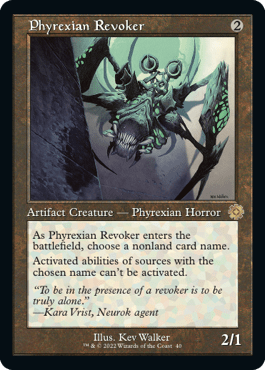
Rating: 3/10
While you might be able to shut down an annoying permanent like a big artifact or planeswalker, Phyrexian Revoker will often be little more than just a Bronze Sable. But just one note about how it works: you can’t name “Powerstone” because it’s not the name of a printed card.
Platinum Angel
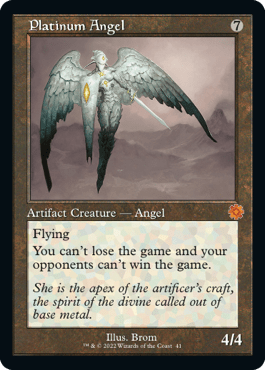
Rating: 6/10
Platinum Angel always looks nigh on unbeatable, but this set has an abundance of removal so it’s not likely to stick around. There are going to be situations where this lands and your opponent just can’t answer it, though. Even if they just can’t answer it for a couple of turns that can give you a window to turn a game around.
There are also ways to protect this angel if you craft your late game plan around it, so I can see this doing a lot of work. I’d just warn against assuming this is the nuts and not putting any effort into it.
Precursor Golem
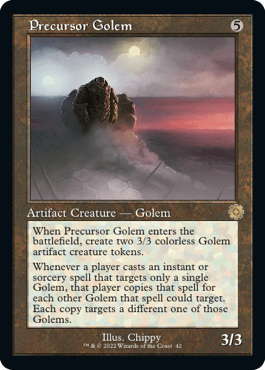
Rating: 6/10
I used to love playing with Precursor Golem when it was in Standard. You’d usually side it in against decks that ran little to no removal spells and just overwhelm them with its efficiency. While a lot of decks will have plenty of removal that takes care of this, what I really like is that you can just sacrifice the original golem for value and be left with a couple of 3/3s with no downsides.
There should also be some good ways to make use of the enters the battlefield trigger. Basically, it’ll be very useful to have around if you have ways to get around the heavy downside associated with the card.
Pristine Talisman
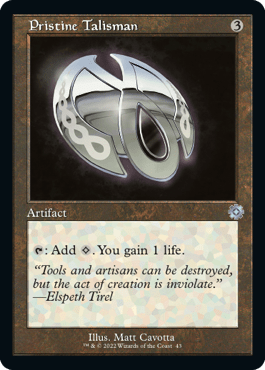
Rating: 5/10
While mana rocks have become less good in recent years, Pristine Talisman still stands out to me as one of the best we’ve ever seen. The repeated lifegain makes it so that you also gain about eight or nine life on top of accelerating you up to your more expensive spells, which is exactly what you need over the course of a game to make sure you survive long enough to leverage the power of your big spells.
Only making colorless mana is certainly a downside, but given how you want to be casting huge 10-mana mechs I don’t think you’ll notice it that much.
Psychosis Crawler
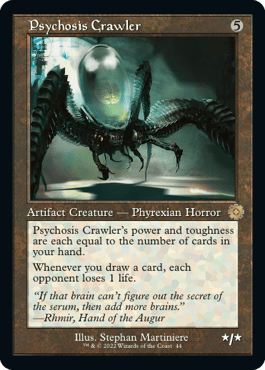
Rating: 1/10
This rating might surprise some Commander players out there, but the fact that Psychosis Crawler sees play at all is a surprise to me.
This was a garbage Standard rare and virtually unplayable in Limited. You just can’t build around it the way you can in Commander. Not to mention that your average hand size (I’m already mentioning this for a second time?) by the time you play this card is probably about two to four, making it a very undersized creature.
Picture this as a 5-mana 3/3 that pings the opponent for one each turn and has the chance to be a lot worse than that and you might understand why it gets such a low rating.
Quicksilver Amulet
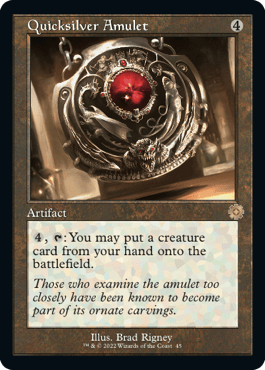
Rating: 1/10
It just isn’t worth it to spend a whole card to give you a way of cheating out expensive creatures. Quicksilver Amulet ought to be a 0, but I could still see scenarios where you have a bunch of enormous mechs that want to be cheated out and this might help a little. But even then I’d much rather ramp into them and cast them normally.
Quietus Spike
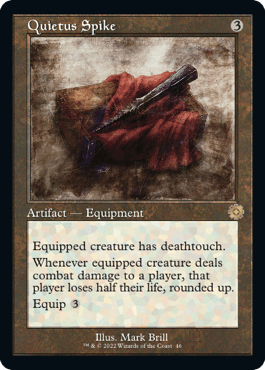
Rating: 6/10
Quietus Spike is a tad on the expensive side to reequip, but the payoff appears to be there. Deathtouch on each of your creatures will be profoundly annoying for your opponent to deal with and the clock is very real.
With so many 1/1 tokens lying around the set there’ll be some decks where this is an absolute house, and even outside of that it’ll be pretty strong.
Ramos, Dragon Engine
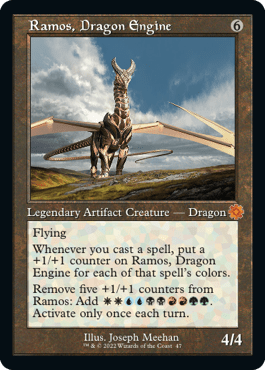
Rating: 8/10
Ramos, Dragon Engine is an absolute beast. It’s never been available in a Limited environment before, but I can’t imagine it’s anything less than busted.
Starting life as a 4/4 with flying isn’t exactly embarrassing, but growing in size with every colored spell you cast will get out of hand very quickly. Granted there are fewer colored spells in this set than in most others, but as soon as this reaches 6/6 and higher it’s already big enough to be the most powerful creature on most boards.
I guess it’s also an easy way to activate Door to Nothingness, but no one will be trying that… right?
Runechanter's Pike
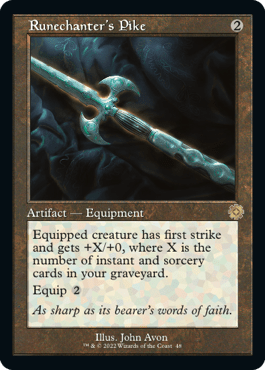
Rating: 4/10
Runechanter's Pike will naturally improve based on how many instants and sorceries you have in your deck, but I don’t see this as being good enough to run unless it’s easy to get at least two or three in the bin. If it ends up reliably giving about +3/+0 and first strike then it’s very much worth the cost to run.
Scrap Trawler

Rating: 7/10
Given that we have a small sacrifice theme in the set and we’ve already seen a bunch of cards on this list that love getting sacrificed, I think Scrap Trawler ought to become a powerful little engine. Even if you just play it, trade it off in combat, and pick up a 2-drop that died earlier, this card is very good for that.
It just has the extra potential to draw you about half a dozen cards if left unchecked while you keep sacrificing artifacts for value.
Sculpting Steel

Rating: 7/10
Not only can Sculpting Steel give you an extra copy of your bomb rare artifact but you can copy your opponent’s one too.
I remember playing against this once or twice when it appeared as a masterpiece in Kaladesh and was always brutal when it landed. It’s usually going to be at least the biggest creature on the board when you play it and sometimes it can copy something absurd which takes over the game or at least swings it back in your favor.
Self-Assembler

Rating: 5/10
Back in Kaladesh Self-Assembler was common and it was a great late game to just have three of these in your deck and have them search each other. Here we actually have four other assembly-workers in the set including the Tron trio, which you really want to search up.
It’s certainly possible to get multiple copies of this in a Draft which you should definitely try to do, but if this is getting any one of the Tron trio then it’s already a very strong card.
Semblance Anvil
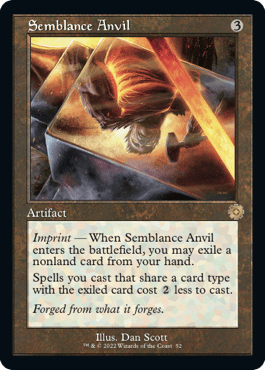
Rating: 0/10
If I wasn’t interested in Cloud Key making some of my spells cost one less, I’m even less interested in a card that uses up an extra card in my hand to make things cost two less. I get that these cards have sweet Commander and Constructed applications, but they’re less than useless in Limited.
Sigil of Valor
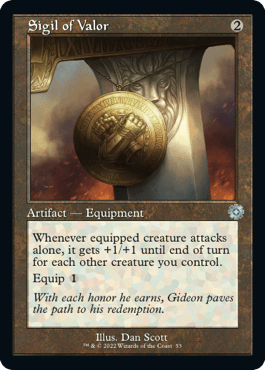
Rating: 5/10
Having a way to effectively attack with everything while only risking one creature at a time is something that can really help you swing a damage race in the go wide tokens deck of this format. We’ve seen Sigil of Valor and similar cards like Angelic Exaltation do some serious work by switching your go-wide game plan into a go-tall one, and that switch normally takes your opponent off balance and helps you swing a game.
Soul-Guide Lantern
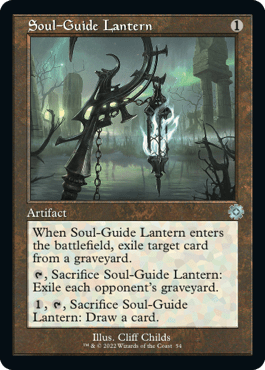
Rating: 4/10
Unearth existing in the set makes graveyard hate somewhat desirable. A cheap artifact that you can play, exile an unearth creature, and then just sacrifice to draw a card is pretty fine to run. You can then recur Soul-Guide Lantern for more value or whatever else, so I reckon this will play out fairly well.
Springleaf Drum

Rating: 1/10
Another Constructed all-star that sadly doesn’t get there in Limited. It could be different if Springleaf Drum was easier to make mana, but requiring creatures as well as this sets it back far too much to be useful.
Staff of Domination
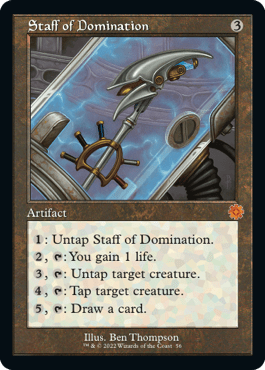
Rating: 2/10
Staff of Domination is the bane of my existence and one of the main reasons I don’t really enjoy Commander. But it kinda sucks in Limited.
The modes you care about cost too much mana to use, but they can be powered out by Powerstones so it’s very possible you have enough mana lying around that this becomes a powerful option in your deck. I’d just need to see that deck come together first.
Sundering Titan
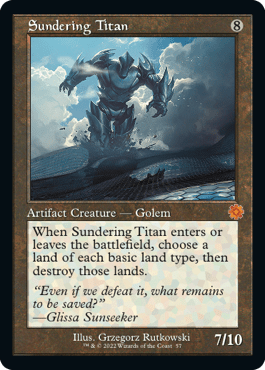
Rating: 7/10 (pun definitely intended)
Sundering Titan is a real beating if you can cast it, and this seems like a set that should be able to cast it. If you have a bunch of Powerstones out and are casting huge mechs then the triggers on Titan are likely to punish your opponent a lot more than they punish you.
I’m a little worried that a 7/10 might be a little too small compared to some of the other giant mechs in this set, but it should be powerful enough if you get it down early enough.
Swiftfoot Boots
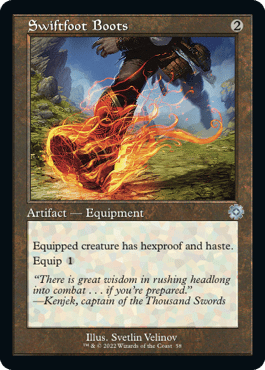
Rating: 5/10
Swiftfoot Boots really only have the downside that all equipment has, in that it costs a whole card to use them. But at one mana to equip and giving a pair of very relevant keywords, this is one of the more useful ones you can have.
Haste is very relevant to move to each new creature that you play and hexproof helps you protect the giant bomb that you’re relying on to win a game. This doesn’t get a higher rating mostly because it’s doing very little to make bad creatures good, but it should still be decent in the right deck.
Sword of the Meek
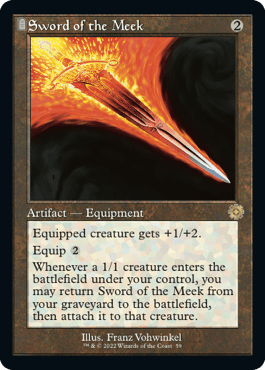
Rating: 4/10
While the base rate of Sword of the Meek isn’t embarrassing, it really is the graveyard recursion mode that you care about. There are a lot of 1/1 tokens in this set as well as ways to sacrifice artifacts, which I think makes it likely that we’ll be seeing some sweet Sword of the Meek decks in this format.
Thorn of Amethyst
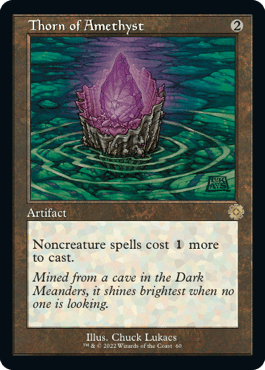
Rating: 0/10
Just, no. We like this effect on creatures, but even then it’s only ok. To have it on an otherwise do-nothing artifact like Thorn of Amethyst is just not what we want at all.
Unwinding Clock
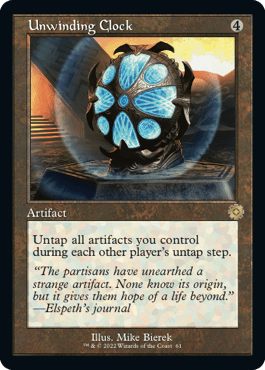
Rating: 1/10
I think Unwinding Clock is likely to do little more than just give all your artifact creatures pseudo-vigilance, at which point it can be playable in some scenarios but is largely going to be useless.
Well of Lost Dreams
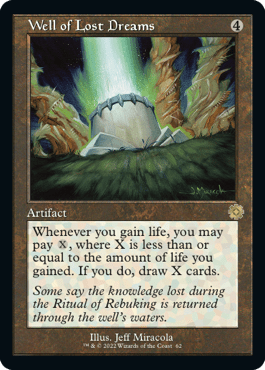
Rating: 3/10
Drawing a lot of cards is something worth giving a second glance, but Well of Lost Dreams is less than useless in most decks. I like that this basically turns Pristine Talisman into Archivist, but I think the amount you have to set this up will be too much of a drawback.
Wurmcoil Engine
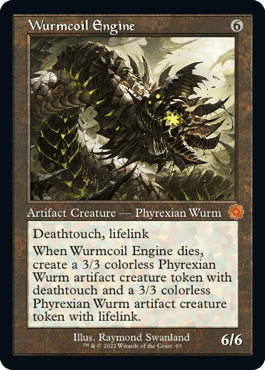
Rating: 10/10
Wurmcoil Engine is by far the most stupid card on this entire list.
If you can’t exile it then it takes over the game in virtually every imaginable scenario. It’s good when you’re ahead, behind, and at parity. It wins races being a 6/6 lifelinker. It requires multiple creatures or removal spells to trade off for it.
So short of being able to exile or fly over it for lethal damage in a single turn, it’ll kill you and it won’t be pretty. Oh, and did you notice it's colorless and can go in any deck?
This has to be the single highest Draft pick in the entire set, much like it was when it was first printed in Scars of Mirrodin.
And Done
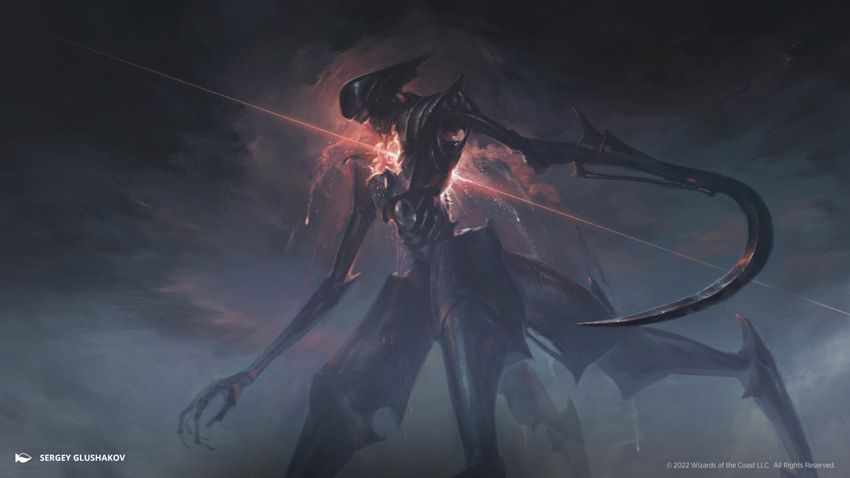
Swamp (The Brothers’ War) | Illustration by Sergey Glushakov
And that’s it, my biggest set review since I started writing them! I noticed that I ended up giving some very polarizing grades this time around. Well over a dozen cards got a 0/10 thanks largely to the Retro Artifact sheet, but I also gave out more 10/10s than I normally do. I wonder if that means anything for the Draft format we’re about to enter. I guess we’ll find out.
Next up, I've got two more things for you:
- Download our free app Arena Tutor so you can get limited card ratings inside MTGA while you're playing (invaluable)
- Check out our Brothers' War Sealed guide for more information on building a sealed deck for your prerelease and any other tournaments you've got coming up
Until next time, take care of yourselves and have fun at your prereleases!
Follow Draftsim for awesome articles and set updates: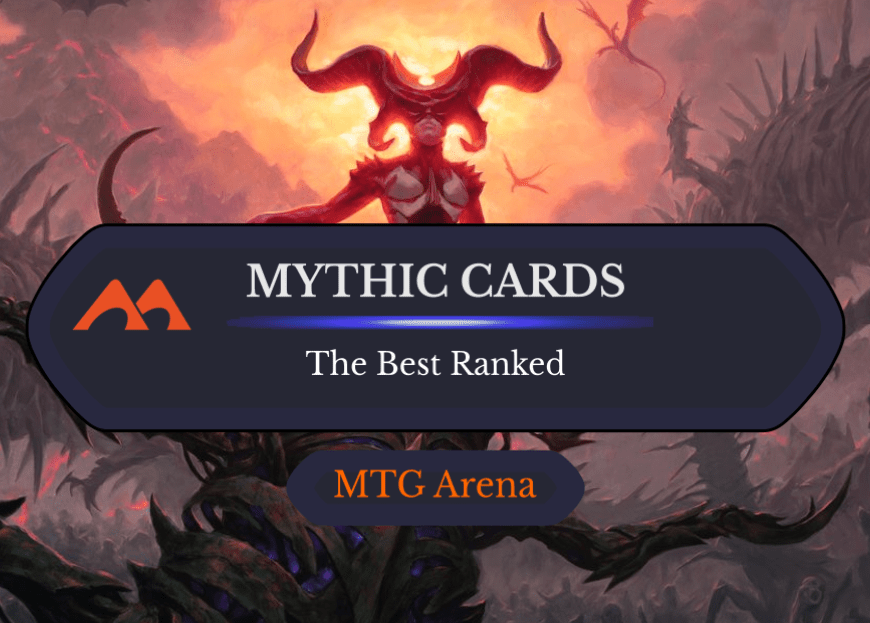
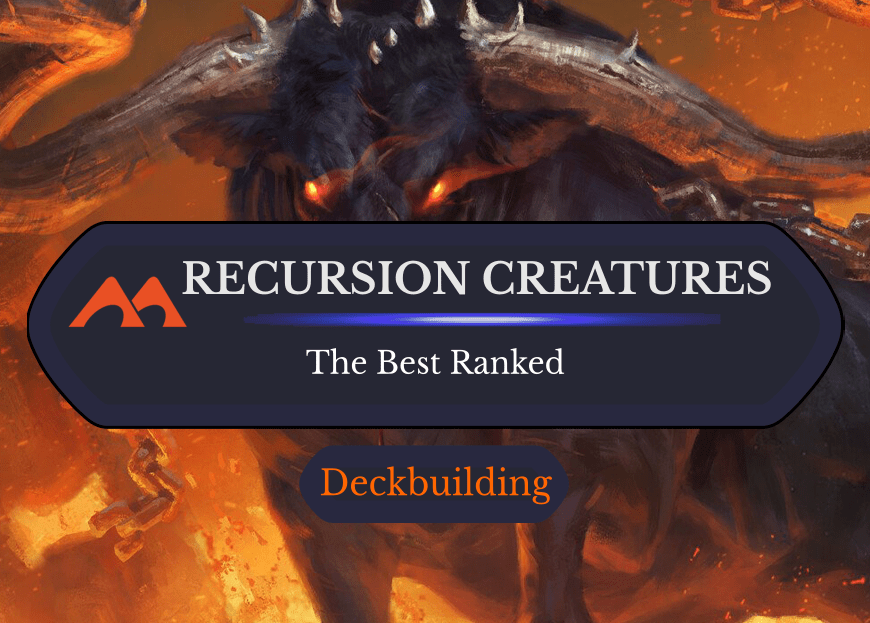
Add Comment